|
STONE HOUSES, MANSIONS AND OTHER
OLD HOUSES |
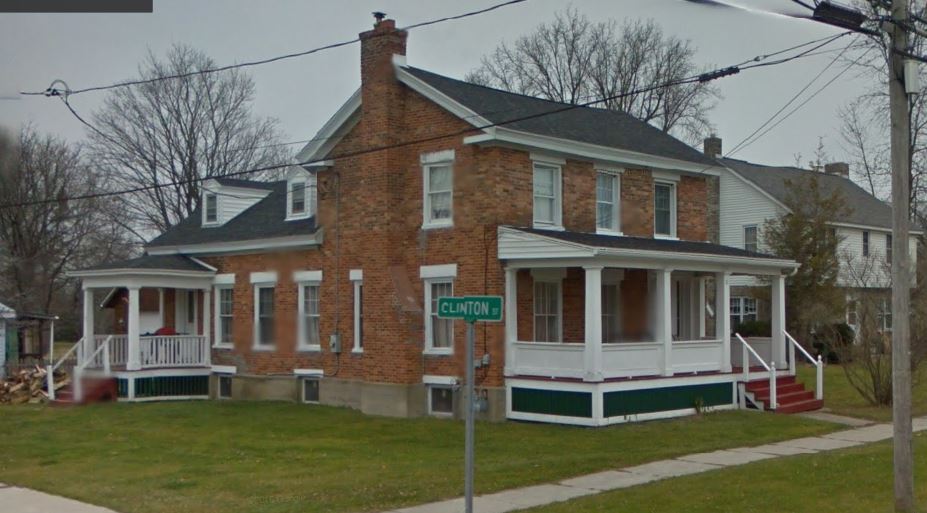
Although this brick house on Lincoln avenue at the corner of Clinton Street, Waddington, was moved there about 1930 it looks, in the main, much as it originally did when it was built about 1845 on the present village school site for James Redington, at the corner of LaGrasse Street and Lincoln avenue. Since September 25 1940 the house, which now faces south on Lincoln avenue, has been owned by the Waddington bank and since April 1943 has been occupied by Roy B Pike, executive vice-president and cashier of the bank.
Born in Waddington June 27 1810 James Redington was son of Jacob Redington and younger brother of George Redington who owned a large stone mansion on LaGrasse Street. Jacob Redington, Revolutionary veteran, bought land in the present town of Waddington in June 1800 and moved his family there from Vergennes, Vermont. In the War of 1812 lie was wounded in a skirmish on Ogden island and in 1813 removed to Potsdam. There his son, James, was educated in St Lawrence Academy, later entered the law office of his brother, George, in Waddington in 1827 completing his legal education in the office of J P Cushman, Troy, and was admitted to practice in 1831. About that time he joined the Congregational church (changed to Presbyterian in 1862), in 1835 married Miss Charlotte G Colfax, daughter of Robert Colfax of New London, Connecticut, and on November 30 1840 was appointed surrogate of St Lawrence county by Governor Seward. He served four years as surrogate under appointment and in 1856 was elected to the office. Originally a Whig he became a Republican, was a staunch supporter of Lincoln and was elected assemblyman in 1861 serving four terms before, becoming United States consular agent at Morrisburg, Ontario
From David C Judson on May 27 1845 James Redington bought a large plot of land along LaGrasse Street to the present school site at the corner of Lincoln avenue. The plot was made up of three parcels originally owned by David A Ogden. On December 19 1812 Ogden sold one parcel to Samuel Gordon, who conveyed it to Judson July 5 1814. In November 29 1817 Ogden sold the two other parcels to Judson thus completing the plot.
It is said Redington built his brick house shortly after he bought the land in 1845. There he lived until his death October 12 1891 leaving his house to his son, George N Redington, an artist for some time connected with the N L Stone photographic gallery in Potsdam. In his will George N requested that his brother, James K Redington, Washington, D C, lawyer and onetime law clerk in the federal interior departments, be given first opportunity to buy the mansion if his widow should be compelled to sell.
George N Redington died May 7 1925 leaving the property to his widow, Addie, but on August 10 1928 she sold the northerly part of the property to the village for a school site and the house was acquired by Reverend Fenton Wesley Johnson, Methodist minister.
Reverend Mr Johnson purchased the lot at the corner of Lincoln avenue and Clinton Street September16 1929 took the house down off the schoolhouse lot and set it on the new site. Then on September 25 1940 Reverend Mr Johnson sold the property to the Waddington bank. The little square original porch was moved to the side door of the house, a new verandah was built across the front, a fireplace and outside chimney were installed, but otherwise the house is little changed, the interior being almost as it was originally. Mr and Mrs Pike, the occupants, came to Waddington from Canton where, Mr Pike had been president of the First National bank. He now is a director as well as executive vice-president and cashier of the Waddington bank, has been president of the St Lawrence County Bankers' association, is a former president of the Waddington education board, and has been active in the Red Cross, Salvation Army and chamber of commerce.
As for the Redingtons, Jacob, the pioneer was first clerk of the town of Madrid when it was set off in the spring of 1803.
It was in 1864 that Reverend James Mackey, who was then pastor of St Mary's Roman Catholic church in Ogdensburg, started to build this squarish structure near the corner of Franklin and Lafayette Streets from stone out of old St Mary's. Its first use was as a parochial school with James Murray as its only teacher. In September, 1866 however, two Grey Nuns were placed in charge.
But after Reverend Edgar Philip Wadhams, DD, was appointed February 15 1872 bishop of the new diocese of Ogdensburg, he engaged the Clerics of St Aviator, a Christian Brothers order from Joliette, P Q, to open a school that fall on the third floor of the Averell building, Ford Street. Thereafter, this property, now designated 723 Franklin Street, became a parish house and social center for a time, and at present it is the St Mary's sexton's house, occupied by Sexton Arthur Pinkerton. Until destroyed by fire about three years ago St Mary's cathedral stood next to it upon a site which is only part of the entire block of land owned by the diocese on Franklin Street between Montgomery and Lafayette Streets.
The trustees of the church bought Lots 12 and 13 in block 15 on Franklin Street from Nathan C Ford February 9 1846. On October 2 1849 Mr Ford sold them Lot 11 while on July 1 1859 he sold Reverend James Mackey Lot 15 and on October 10 1859 Mr Ford conveyed Lot 14 to Reverend Mr Mackey. Reverend Mr Mackey transferred Lots 14 and 15 containing this stone house to Rt Reverend John J Conroy, bishop of Albany, on August 26 1867 for $4,780 because the Diocese of Ogdensburg had not yet been created. Likewise on September11 of 1867 the trustees of St Mary's deeded Lots 11-12-13 to Bishop Conroy.
Sometime in the late 1840s Reverend Father Mackey had acquired the two lots at the corner of Montgomery Street, thereby completing Catholic ownership of that entire block on the north side of Franklin Street, and erected his modest little rectory in 1848. Four years later he started the first St Mary's edifice, which was dedicated in 1855.
Bishop John J Conroy of Albany deeded Lots 11-12-13-14-15 to St Mary's church December 29 1869. Eventually, in 1898 all of the Catholic lands in St Lawrence county were conveyed to the Rt Reverend Bishop Gabriels of the Diocese of Ogdensburg. And it can be said that not since the Catholic church obtained title to this block of land on Franklin Street has it passed out of that ownership. The history of Catholicism in Ogdensburg has been a richly romantic one running back to Fathers Picquet and de la Garde in the 18th century. After them there was a void until Father Farnham of Utica made his visit there in 1820 finding a station consisting of a few tradesmen and common laborers who had come from Montreal to work.
It remained for Rt Reverend Bishop DuBois of New York City, the purchaser of the LaFarge mansion for a priests seminary at LaFargeville in 1838 to appoint Reverend James Salmon in 1827 to serve Ogdensburg, Waddington and the contingent territory. And it is a coincidence that Reverend James Mackey, born in County Armaugh, Ireland in 1808 came to America, studied in the seminary at LaFargeville, was ordained January 5 1841 and assigned that summer to serve his first and only parish, Ogdensburg, through a period of 42 years.
After his death in 1883 he was succeeded by Reverend Joseph H Conroy of this city who later became bishop of the Ogdensburg diocese, of which Rt Reverend Msgr John L Plunkett, now pastor of St Patrick's in this city, was also the chancellor for a number of years before coming back to his home town of Watertown.
NOTE: The Red Tavern was located in the area of where the current location of the Fredrick Brothers Funeral Home (lot No. 101 a mile up Rt. 37) at what is called Coopers Corners. The text of the history of the landowners is correct, and I have verified it by deed research. Looking at the 1864 map of Theresa, the owner of the tavern in 1864 was A. D. Terrell and is located on lot No. 101, which was also verified by deed research. Ostrander Corners is on lot No. 198. It is gone now
Upon the old Military road, where it intersects the Theresa-Alexandria road about two miles from the village of Theresa, stands a whitewashed brick farmhouse that has an interesting history. It is the old "Red Tavern," said to have been built by Henry R Morey in 1828 to become one of the most famous of the old stagecoach inns that dotted the Military road.
The Military road resulted from the visit of President Monroe to the North Country in midsummer of 1817 and was constructed by soldiers in 1818 1819 and 1820. It did not take long after completion for taverns to spring up, for the road ran from Sackets Harbor through Brownville, Pamelia Four Corners, Redwood, Hammond and on northerly and easterly to join another important highway at Plattsburgh.
First of the taverns in the town of Theresa to be erected on the Military
highway was that of Lodowick Salisbury. Then came that of Elias Holbrook
about 1827 and following it was Morey's "Red Tavern" in 1828.
With the "Red Tavern" went about 12.35 acres of land and one
of the succeeding owners and proprietors after Morey was Austin Bates.
Others were Elias W Glass, Hiram Becker, Rufus Dodge, Walter B Sheldon
and William S Tompkins.
A recorded deed shows that on April 7 1836 Austin and Lucy Bates sold the "Red Tavern" property to Hiram Becker for $1,400. On December 22 1840 Becker and wife, Angelic, sold to Elias W Glass for $1,600. Then followed the other transfers as mentioned and on May 14 1856 Walter B and Sarah H Sheldon sold it to William L Tompkins June 4 1863 Tompkins and wife, Eliza, conveyed to Arad L Terrell who, with his wife, Martha, sold to Mrs Sarah Sinclair May 24 1869.
Mrs Sinclair and her husband, George Howe Sinclair, cattle dealer, later moved to Port Hope, Ontario and on August 3 1872 sold the "Red Tavern" property to Stanley Paterson, a Port Hope banker, for $1,000 in gold. Paterson and wife, Joanna, disposed of it to Minerva Cole, wife of M V B Cole, March 10 1875. On September 25 1877 Mrs Cole sold the old tavern and its more than twelve acres to Irving C Cooper, who merged it with his approximately 400-acre dairy farm, most of which had been owned and operated by his father, Edward Cooper.
Edward Cooper was one of the early settlers in what is now the town of Theresa and on September10 1838 surviving trustees of the old Antwerp company of Belgium deeded to him 142.53 acres, first of the several parcels that comprise this big farm. The other parcels were bought in ensuing years, the last one being obtained from Lewis A and Mary Jane Remington July 28 1854 and on August 3 1855 Edward Cooper died, leaving Mary, his widow, and Lydia, Josephine, Irving and Angeline, his children.
Irving was born on this big farm May 13 1843 but was away from it between 1854 and 1866. Then in 1870 he began acquiring the interests of the other heirs in it, it having long been known as the Edward Cooper farm at Cooper's Corners.
In 1875 Irving erected three cheese factories and began making English cheese, operating the farm also. He augmented the production of cheese from his own factories with cheese purchased and became the largest northern New York cheese dealer, shipping to New York, Philadelphia and English markets.
His will, recorded December 17 1910 directed his executors to give his son, Jesse I, a five-year lease of the farm and provided that eventually Jesse and sister, Mrs Jennie Y McLaughlin of Columbus, Ohio, should share title. Ultimately the whole title went to her and after her death from her to her husband, Harry P McLaughlin, who conveyed the farm to the Watertown Savings bank December 7 1939.
On February 10 1940 the bank sold to Mrs Ida M Massey, wife of Captain Chester A Massey, well known retired lake captain, horseman and dairyman, who still owns and operates the place. And it is interesting that Edward Cooper's first parcel of 142.53 acres in the farm touched the farms of Henry Taggart and of Colonel Sinesy Ball, who in 1817 became one of the first two settlers in Theresa
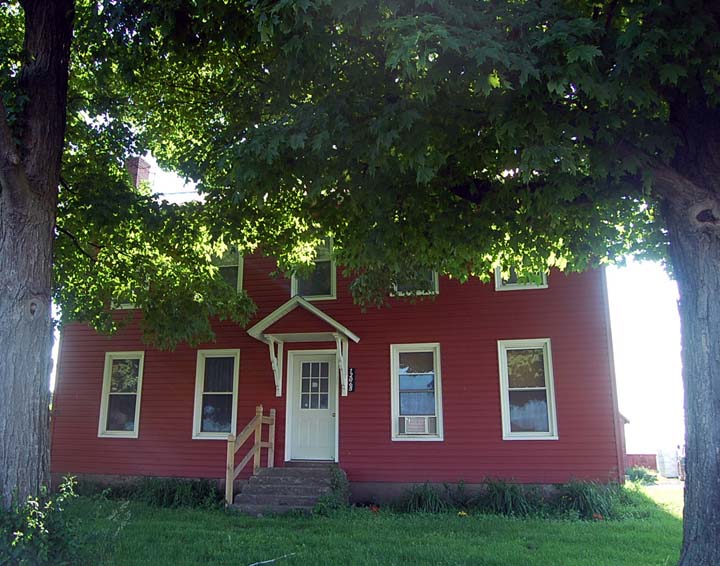
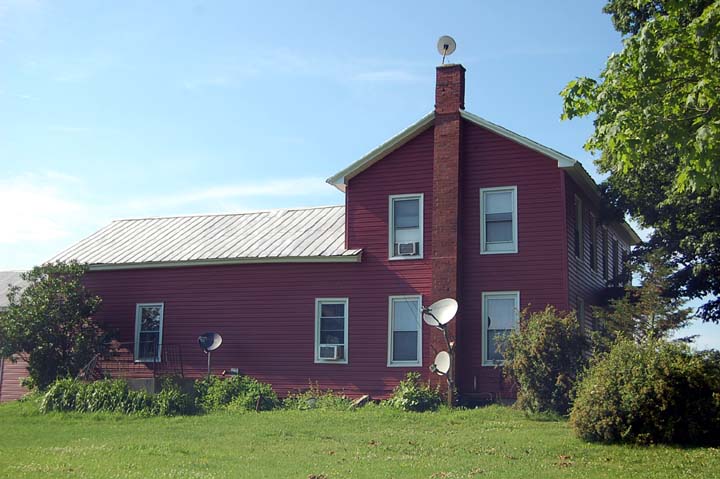
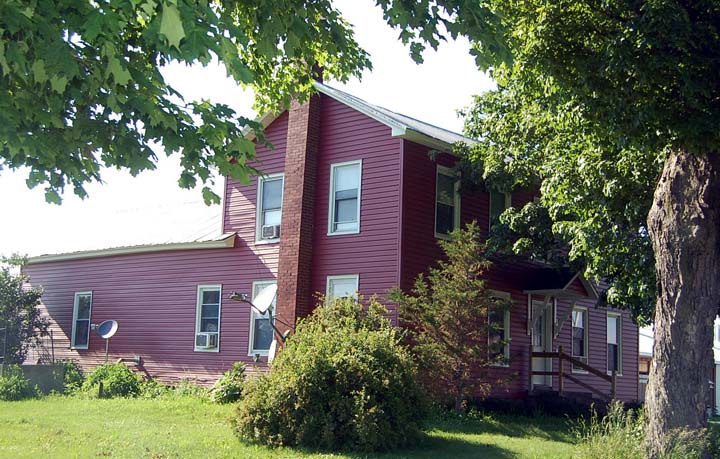
Bishop Street, with its tannery, distillery, saw and grist mills, church; school and tavern, was once a thriving little settlement in the town of Henderson. It was named for Captaim John Bishop, who had been to Naples, Italy and who had consequently named Henderson Bay the Bay of Naples when he came to settle, between 1801 and 1804 in what is now the town of Henderson. With him came his family, which included his four sons, Luther, John, Calvin and Sylvester, all of whom owned land along Bishop Street.
This house, now covered with modern composition shingles, is of Georgian design with handsome central front doorway. In its early history, with its original small paned windows, it must have been unusually attractive. Its age probably is at least 115 years and probably was built by Captain Bishop's son, John. On May 10 1824 a John Bishop bought 150.9 acres of land in the locale of this house from William Henderson, and wife, Sarah, of Hyde Park, the man for whom the town was named. On February 15 1834 John Bishop Jr, and Charles W Bishop purchased 32.73 acres, excepting the schoolhouse lot which was 40 feet square, from Israel and Chauncey Kellogg and wives from Clayton. On the ensuing July 15 Charles W and Susan Bishop conveyed their interest in this parcel to John Bishop.
The parcel suits the description of the location of the house and apparently later became part of a 112.73- acre parcel. Thus it may well be that this house was constructed in 1834-1835 and Mrs Ella R Overton, Adams postmaster, present owner, has been informed that it was once a tavern.
On December 30 1835 Sylvester and Almeda Bishop sold John 40 adjoining acres which also touched upon the 50 acres, which Reverend Luther Bishop had bought from John and Surviah Bishop on July 1824. On May 12 1841 John and Laura Bishop, Adams, sold the 112.23 acres, which is also cited as 112.73 acres in some of the deeds, to Wesley VanValkenburg of Henderson for $4,000. VanValkenburg and his wife, Jane, disposed of the same place on March 16 1848 to Alonzo B Schuyler for 13,080. Schuyler conveyed it on February 27 1849 to John D Gillett, who ultimately made an assignment for benefit of creditors. As a result Sheriff Leonard Sealon sold the 112.23 acres to William Kehoe, town of Scriba, Oswego county, for $2,680 on May 27 1879.
Kehoe apparently split the parcel and sold off parts of it but the complete record is Jacking, except that on March 23 1895 he conveyed two parcels of 27.26 acres and 18.42 acres to Floyd C Overton, prominent Holstein- Friesan breeder of Adams for $2,284. Mr Overton acquired adjoining land from the Orrin Sprague farm. Thereby he built the Bishop Street place to about 160 acres. Under his will when he died December 4 1923 this property went to his son, the late Dr F Carter Overton, and when the latter died April 12 1947 it passed on to his widow, Mrs Ella Overton, present owner.
Floyd C Overton, born in Adams September 4 1858 graduated from Union Academy, was prominent in the Grange, was a director in the Jefferson County Agricultural society, vice president of the Dairymen's League association of the state, president of the Adams board of trade and village president of Adams. His son, Dr F Carter Overton, born January 17 1888 graduated from Union Academy and Cornell and was county veterinarian from 1923 to November, 1925. On August 7 1912 he married Miss Ella Ralph, daughter of Fred and Etta Ralph, and had two children, F Ralph Overton and Mrs Robert S Rhodes Jr
Also a graduate of Union Academy as well as the Oswego State Normal Mrs Ella R Overton, prominent Democrat, taught school for a time, has been county committeeman some years, county election commissioner nine years and June 1 1945 succeeded the late J W Cain as postmaster of Adams.
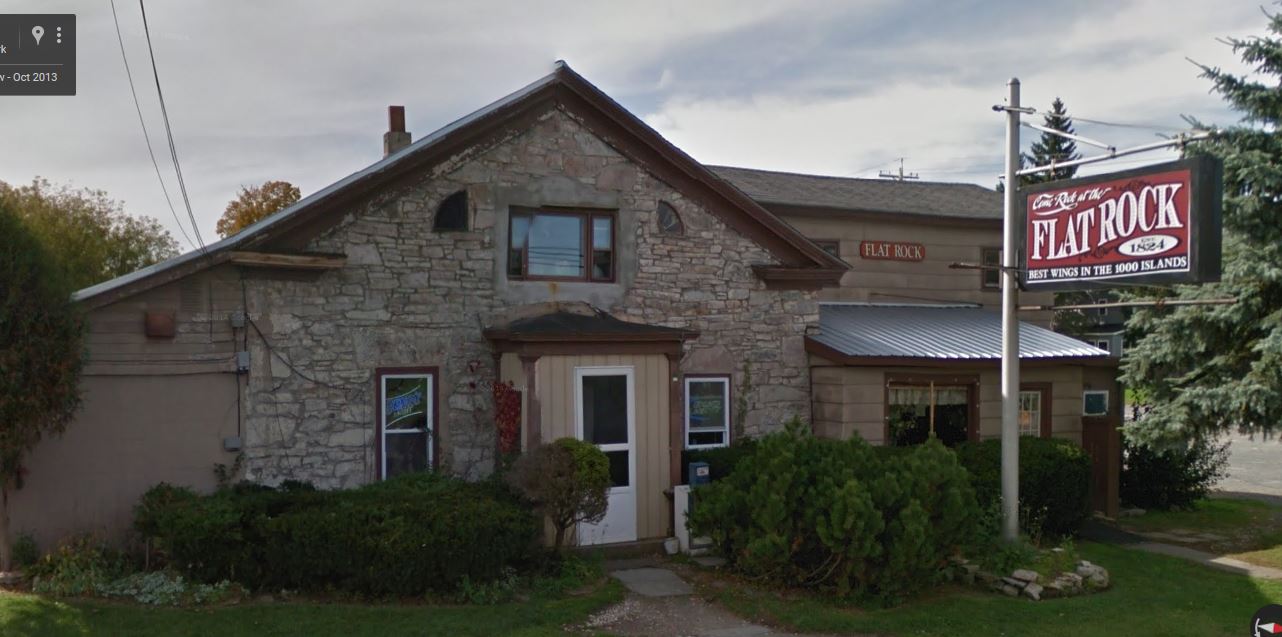
Jason Clark of Plessis, one of the early settlers of Jefferson County died on August 6 1872. A surveyor for James D LeRay de Chaumont and son, Vincent LeRay great north country land barons, Jason Clark had been a resident of LeRaysville in the 1820s and first owned land in the town of LeRay. About 1830 he removed to Plessis the hamlet winch the LeRays had named for a place in France and on April 20 1839 became the land agent for the firm of Woodruff & Stocking.
Standing high in the people's confidence he was first postmaster of Plessis. For several years he was justice of the town of Alexandria. In 1837 1841 1842 1855 1856 1857 and 1859 he was supervisor of the same town. Also he was onetime county judge and in 1853 he became master of Alexandria Lodge, No. 297 F & A M Plessis, familiarly known as Flat Rock in its early days developed largely into a tidy little industrial community as a result of the grist mill which James D LeRay constructed there on Plessis creek in 1817. In 1830 Jason Clark and William Shurtleff purchased and rebuilt this mill, Clark later becoming the sole owner. A short time afterward he is understood to have built the stone building now owned and utilized by the Plessis Farmers' Cooperative Association, Inc., as a store, and also to have built for his residence the little stone building adjacent to it which is owned and operated by Lawrence P Storrs as the hotel shown above.
The Cooperatives' building, which stands on Main Street at the corner of Wall Street, was used by Jason Clark both as a land-office and store. His house faced wholly on Main Street.
The firm of Woodruff & Stocking, for whom Jason Clark became the general agent, was comprised of Norris M Woodruff, who later built the Woodruff hotel in this city, and Samuel Stocking. Utica capitalist who at one time had vast St Lawrence county land holdings about Morristown
On February 20 1836 this firm took over the trustees of the old Antwerp, Belgium, much of the remaining lands of the company in the towns of Alexandria, Antwerp and Clayton, and Jason Clark set about disposing of them.
The record of the house is difficult to trace in a united space of time. The county atlas of 1864 designates and the land-office as the property of Jason Clark but but county atlas of 1888 shows the ownership in Silas G Norton
A deed dated April 27 1870 shows that Almeda Clark, who was the wife of Jason Clark, conveyed the property to Nancy P Norton, who was the wife of Silas C Norton merchant and business man of Plessis for a number of years. Mr Norton died late in 1890. Mrs Norton died about 40 years ago leaving her estate to her son, Milton H Norton, who were joint executors. After the Norton ownership of this house it has passed through many, hands and was always used as a residence until about 1937 when Louis and Mildred Ritter purchased it from Harry R and Hazel Foerster on October 28 of that year Later it was acquired by Harold and Anna Mitchell, who sold it on October 20 1947 to Lawrence P Storrs, present owner and proprietor. The stone store has been owned by the Cooperative more than 20 years, and a half century and more ago was conducted as a mercantile establishment by Augsbury & Wilcox.
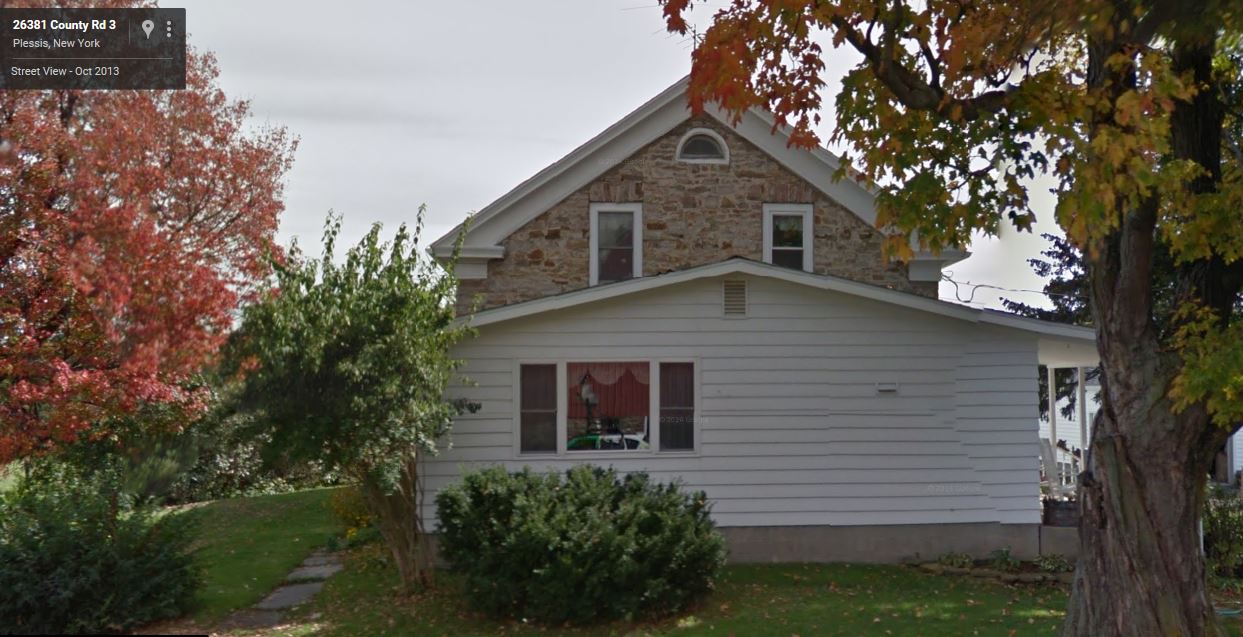
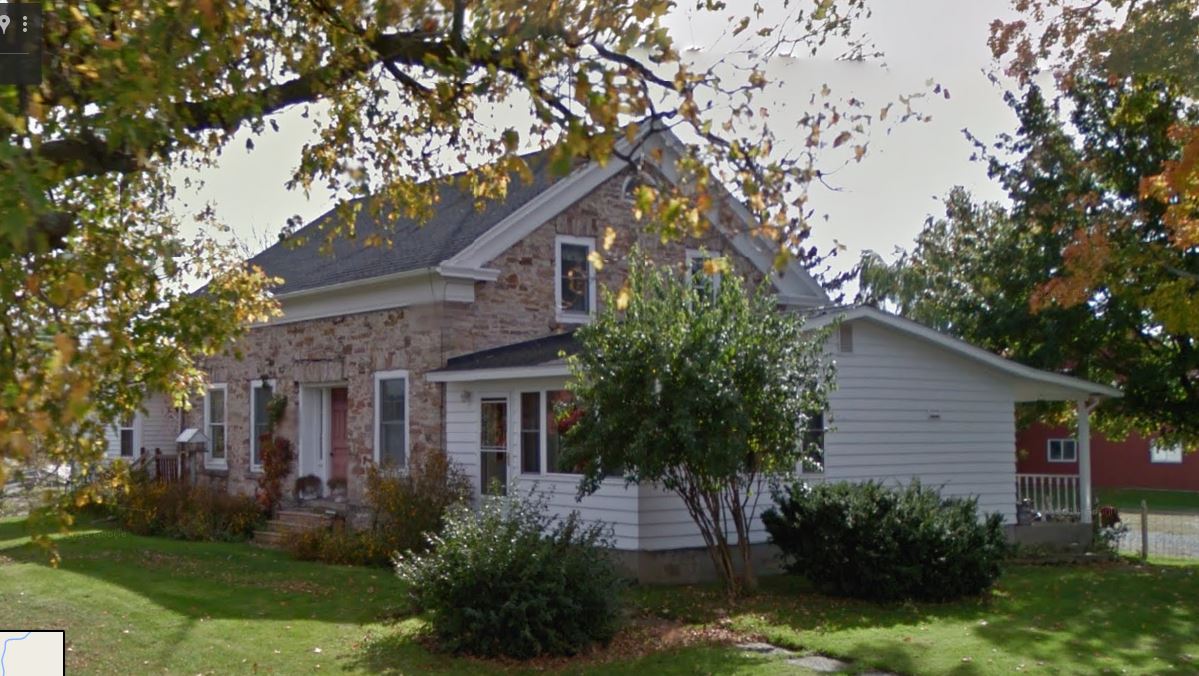
Between the villages of Plessis and Redwood on the quiet, peaceful country road that connects these two communities this fine old native sandstone house is located. The environment is one of rural beauty and contentment. It is a place for a poet, a painter or a composer of music. Through the countryside it is known as the George Augsbury farm. In reality it dates back further than that to Asa E Newman, one of the early settlers of that area, who is believed to have built this house in 1826-1827. Asa E Newman was the son of Abraham Newman, a Revolutionary War veteran, native of Stafford, Connecticut, who enlisted in the Colonial army in 1776 and served three years. In 1789 Abraham removed to Otsego county, transferred from there to the town of Alexandria in 1820 and died June 19 1841.
On June 29 1826 Asa E Newman purchased 100 acres, first and largest of the original five parcels in this farm, from Francis Depau, New York City merchant and north county landowner, for whom Depauville was named. It is likely that Newman began construction of this house about that time, and in connection with this first deed it is interesting to note that Alexander LeRay, son of James D LeRay de Chaumont, and for whom the town of Alexandria was named, acted as attorney for Depau and for his father, who also had an interest in the plot.
The second parcel of the' farm, 56.07 acres was bought by Newman from Francis and Silvie De Grasse Depau February 15 1836. Then on May 10 1841 Depau's executors sold 19.30 acres to Newman.
From the Depau estate Asa E Newman purchased parcels of 47.31 acres and 4.70 acres on April 14 1845. Then on July 2 1849 Newman disposed of the farm to George W Clark and Edwin H Tanner for $3,000 removing to Addison, Steuben county.
Clark and Tanner sold to Charles Welch for $4,000 on February 14 1850 and on December 10 1853 Welch and wife, Harriet conveyed the property to George Augsbury, then of the town of Theresa, for $5,000. Mr Augsbury resided there until February 27 1888 when he died intestate leaving three children, George Wilson Augsbury, Mrs Byron (Belona) Ostrander and Mrs James (Corintha) Dillen. George Wilson Augsbury, long a member of the Plessis old stone store mercantile firm of Augsbury & Wilcox, was named administrator of his father's estate.
On March 28 Mrs Belona Ostrander sold her one third interest in the farm to her brother and sister for $4,000 and on February 25. 1891 the latter, Mrs Corintha Dillen conveyed her half interest to her brother for $6,000. George Wilson Augsbury was married to Sarah J Stone, daughter of Loren and Janet Stinson Stone of Moon Lake, in 1875 and shortly after that they removed to Plessis where he became a merchant. They had three sons, Theodore, Morristown druggist; Earl, New York City teacher, and Reid, an Atlanta, GA, business man. In 1930 George Wilson Augsbury died and on November 13 1941 his widow passed away at the home of her son, Theodore, in Morristown. On September 1 1943 Theodore B Augsbury individually and as administrator of his father's estate, W Reid Augsbury then of Redwood and Earl S Augsbury of Woodmere, Long Island, sold the farm to Henry and Lottie Zimmer, the present owners.
The farm as now constituted consists of 350 acres and a herd of 35 Holstein cattle. It is one of the best operated dairy farms in that section of the county and the old stone house is maintained in spic and span condition
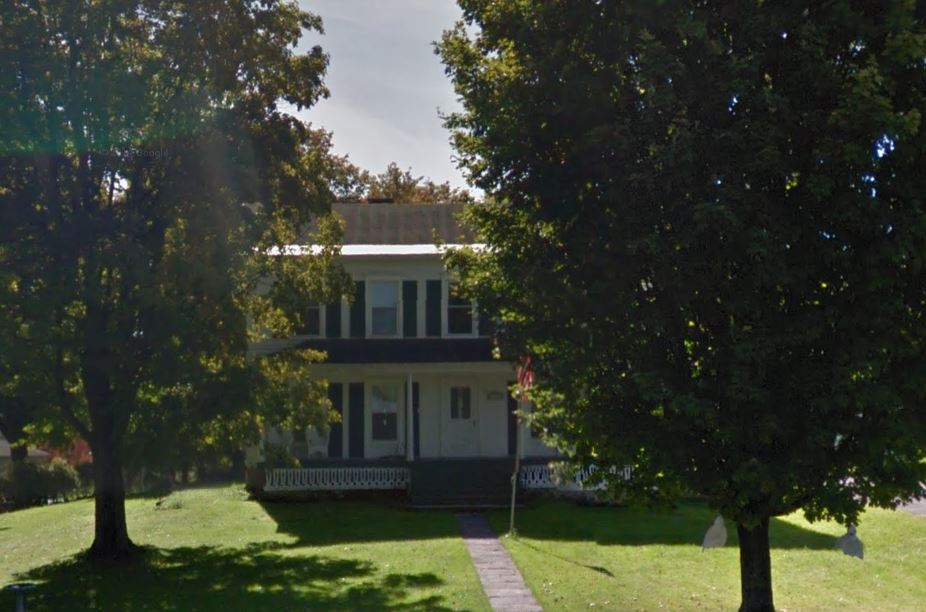
For considerably more than a century the beautiful old Conklin house and estate located on Main Street in the village of Antwerp has been owned in the Conklin family. In it many members of the family have been born and died.
Last of the members to own and occupy it was Calvin S Conklin, able chemist and pharmacist who died there July 12 1949 at the age of 85. Under the provisions of his will, his interest in the place, which is filled with antiques and heirlooms, went to his brother, Luther F Conklin, the present owner.
Son of Stephen and Sarah A Robinson Conklin, Calvin was born in the old house February 18 1864. He attended private school and Ives Seminary. Later he learned pharmacy and chemistry in the store of Edward B Perley and when that store burned Mr Conklin helped design the present store, which has some of the most beautiful interior woodwork in the north country and is now owned and operated by George L Rogers. Ten years before his death Mr Conklin retired, but during the last dozen years of his activity he had been much interested in improving the quality of milk and cheese and beginning in 1927 was chemist and bacteriologist for F X Baumert & Company, manufacturers of fine cheeses.
Under the will of his mother, Mrs Sarah A Conklin, recorded April 3 1907 Calvin S Conklin became the owner of her one-third interest in "the homestead" including the Hannah Gill lot, which had been deeded to her by her son, Luther F Conklin. The rest of her real and personal estate she willed equally to Calvin, his sister, Miriam H, and brother, Luther F. Up to the time of her death on November 15 1944 at the age of 77 Miriam Hannah Conklin had lived in the homestead with her brother, Calvin. There she was born November 6 1867. She attended Ives Seminary and Oswego Normal college, was for some time librarian of the Antwerp Free library and member of the board of education. By her will recorded December 27 1944 she gave all of her real and personal property including her interest in the homestead to Calvin.
Her grandfather, Luther Conklin, one of the early settlers of Antwerp, bought from Isaac L Hitchcock, Antwerp's first tannery, which was built about 1812. Luther's acquisition of it was about four years later, the county records showing that on June 7 1816 Hitchcock and wife Ruth sold two parcels of land, six acres and .98 of an acre to Luther Conklin for $1,000. It is likely that Luther built this house about that time. On August 21 1819 he and his wife, Hannah Howe Conklin, conveyed these two parcels to Luther S Conklin of Rossie for $1,142 and January 26 1837 Luther S and Frances R Conklin, quitclaimed their interest in the same to Stephen and John H Conklin. October 1 1871 John H and Sarah N Conklin deeded their interest to Stephen Conklin. John H and Stephen Conklin were brothers and sons of Luther.
John Howe Conklin, born at Remsen in 1812 was one of the original trustees of Ives Seminary and was president of the board in 1861-1862. In 1853 and from 1855 to 1864 inclusive he was supervisor. Also he was warden of Auburn prison for a time. He first married Sarah Northrop and later Emma White. He died February 11 1875.
His grandfather, Major John Howe, was one of the committee elected to build the Antwerp blockhouse in July 1812. Also he was one of the committee in charge of the undenominational brick church built in 1816 was supervisor in 1820 1821 1822 1825 and 1826 and was master of the Queen of Sheba Masonic lodge formed prior to 1825 and dissolved during the Morgan excitement.
Lack of vital early data in the county records, or of mention in county histories, make the history of this old brick house on the Theresa-Plessis road a challenge to the imagination. It was probably built by Michael Lewis between 1825 and 1836 and Ernest G Cook, Theresa historian, believes that originally it may have been used as a tavern. The construction of the house subscribes something to that theory.
It is almost certain that the farm land, upon which the house stands, was originally part of the extensive land holdings of Mme Cornelia Juhel, mother-in-law of Vincent LeRay de Chaumont. This is evidenced by the fact that on November 24 1834 through Samuel C Kadany, her attorney, she sold Michael Lewis an adjoining 100- acre tract to this 211.44 acres. Also on November 30 1825 through Vincent LeRay as her attorney she sold 98.59 adjoining acres to Matthew Lewis, who may have been a brother of Michael Lewis.
Whence Michael Lewis came to this county there is no inkling. That he later removed to Pavilion, Illinois, the record shows. That he was a man of some means is apparent from the fact that he held mortgages on several farms, but none of his own property seemed to be materially encumbered. When a resident of Pavilion, IL, he conveyed this house and its 211.44 acres of land, minus a half acre which had been excepted for school uses, to George Washington Phillips of Theresa for $4,100.
George Washington Phillips, brother of County Judge Crandall F Phillips'
grandfather William D Phillips was one of the twelve children of John
Phillips Jr, and Sarah McCombs (or Macombs) Phillips.
Born in Herkimer county in 1806 John Phillips Jr, came to Jefferson County
in his youth with his parents, settling first in the town of Lyme. There
he was married to Sarah McCombs in 1826. Later they transferred to the
town of Theresa.
George Washington Phillips, one of the oldest children of John and Sarah Phillips, married Mira Bury, became one of the most prosperous farmers of the Hyde lake area, served as a town officer for a number of years, and was one of the founders and leading stockholders in a limburger cheese factory constructed in his neighborhood. He died April 29 1896 leaving a widow and two children, Mrs Alice E Place and George C Phillips, who after maturity became a resident of Carthage.
Under the will of George Washington Phillips one half of his real and personal property went to his widow, $500 went to his daughter and the residue of the estate to his son, who, with his wife, Maude H Phillips, conveyed his interest in this house and farm to his mother, Mira, July 25 1906. She died early in 1910 willing one-half of this farm and personal property on it to her sister, Mrs J R (Clara A) Sturtevant and the other half to Miss Lois Phillips, daughter of her son.
On January 1 1923 Mrs Sturtevant and Miss Phillips sold the place to George
and Maggie Slate for $8,000. Mr Slate died early in 1946 and on March
24 1948 Mrs Slate disposed of this property to the present owners, Wilbur
H Stanton and wife, Esther D Stanton
<<< Back to Master List
>>>
Almost as primitive in type as the early American log cabin, this native sandstone house about two miles towards Canton from Potsdam on the Canton-Potsdam state highway, is one of the earliest stone houses constructed in that area of St. Lawrence county.
The time of construction must have been about 130 years ago, for on April 6 1820 Garret VanHorne, St. Lawrence county land baron, sold 55.77 acres of land lying on both sides of the Canton-Potsdam road at that point to Eli Dewey.
Son of Chester and Annie Parish Dewey, Eli Dewey was born in 1796 in Connecticut and came to Canton with his parents in 1800 shortly afterward removing to become the fifth family to settle in the town of Potsdam. Pressed into militia service in the War of 1812 Chester Dewey, the father, died of exposure in 1813 leaving a widow and six children. Eli, one of the older of these, was married in Potsdam to Miranda Champion, schoolteacher and native of Vermont, and became the parents of a son, James.
In 1934 Eli Dewey died and in due time his widow married Lucius Dewey, who is said to have been no relative of Eli. They resided on the farm until August 19 1859 when Miranda and her husband, Lucius, conveyed the property to her son, James A Dewey.
Born on the farm March 29 1828 James A Dewey not only followed farming, but spent three years learning cheesemaking and is reputed to have established the first cheese factory in St. Lawrence county. On March 30 he and his wife, Sarah sold 147.96 acres with other lands and including this 55.77 acre tract to Isaac Matthews for $7,118.50.
Isaac Matthews kept the place about 15 years and on December 1 1882 his wife, Levett, joined with him in selling the house, out buildings and 147.96 acres to James Sullivan, a native of Ireland, for $7,398.
When Mr Sullivan died February 12 1919 this farm, with its old sandstone house and other buildings went to his son, Daniel James Sullivan, who had been born in the town of Potsdam on July 1 1862.
Daniel J Sullivan, farmer by occupation, lived most of his life on this farm. In 1892 he was married to Margaret Hourihan. She died in 1931 and shortly after that her husband retired, moving into the village of Potsdam. There, on August 24 1947 at the age of 85 he died at his home on Clinton Street.
Under the provisions of his will one-fourth of his estate went to his son, Lloyd Sullivan, Schenectady; one fourth to his daughter, Mrs Jane S Roach; one-eighth to his daughter, Mrs Mildred S Heaney; one-eighth to his daughter, Mrs Agnes S Given, and one-fourth to his daughter, Miss Catherine I Sullivan. On January 14 1948 Daniel J Sullivan's estate, through its executor, conveyed this property to Clifford E Yaddow and wife, Mrs Anne Yaddow.
Native of Massena Center, Mr Yaddow is a son of Mr and Mrs Harry Yaddow, attended Massena High school and formerly was employed by the Aluminum company. On May 29 1941 he was married to Miss Anne La Clair, daughter of Mr and Mrs Wilfred La Clair of Brasher Falls.
But to revert to Garret VanHorne it should be said that in 1803 when the town of Potsdam was in three tracts he and David M Clarkson, as trustees, took over the large eight by ten-mile one, while Charles LeRoux took one two by five miles and David A and Thomas L Ogden took the third of similar size. These men were trustees for themselves and for Nicholas Fish, Herman LeRoy, William Bayard and James McEvers.
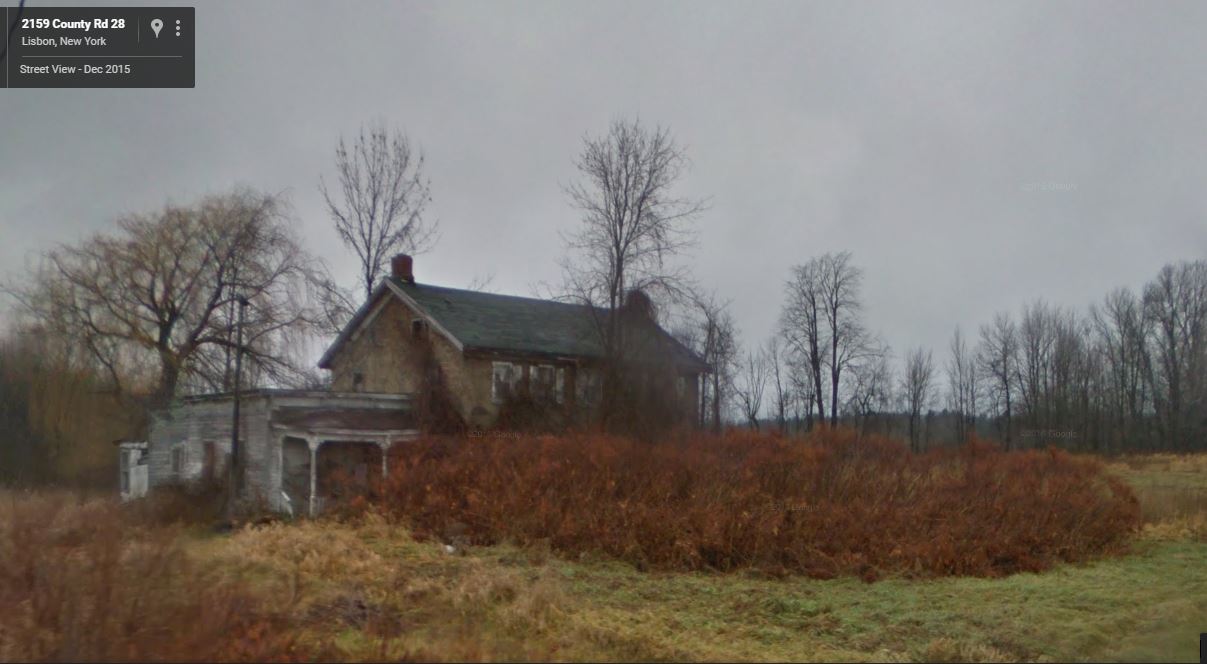
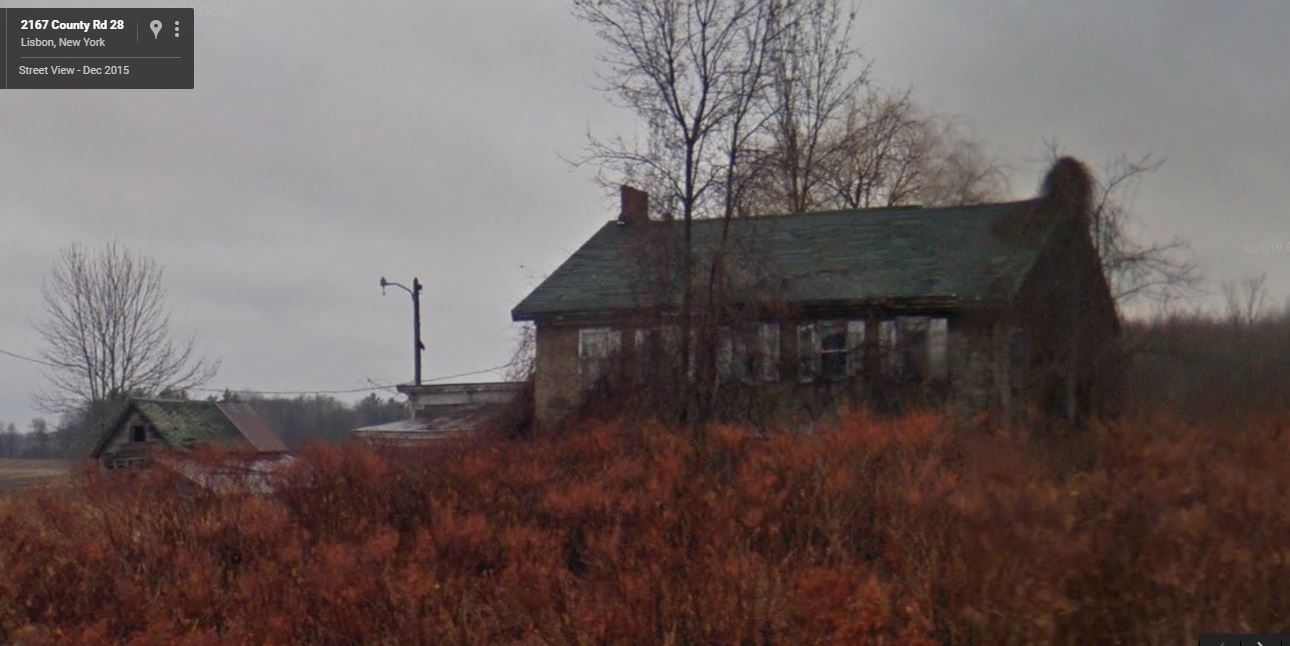
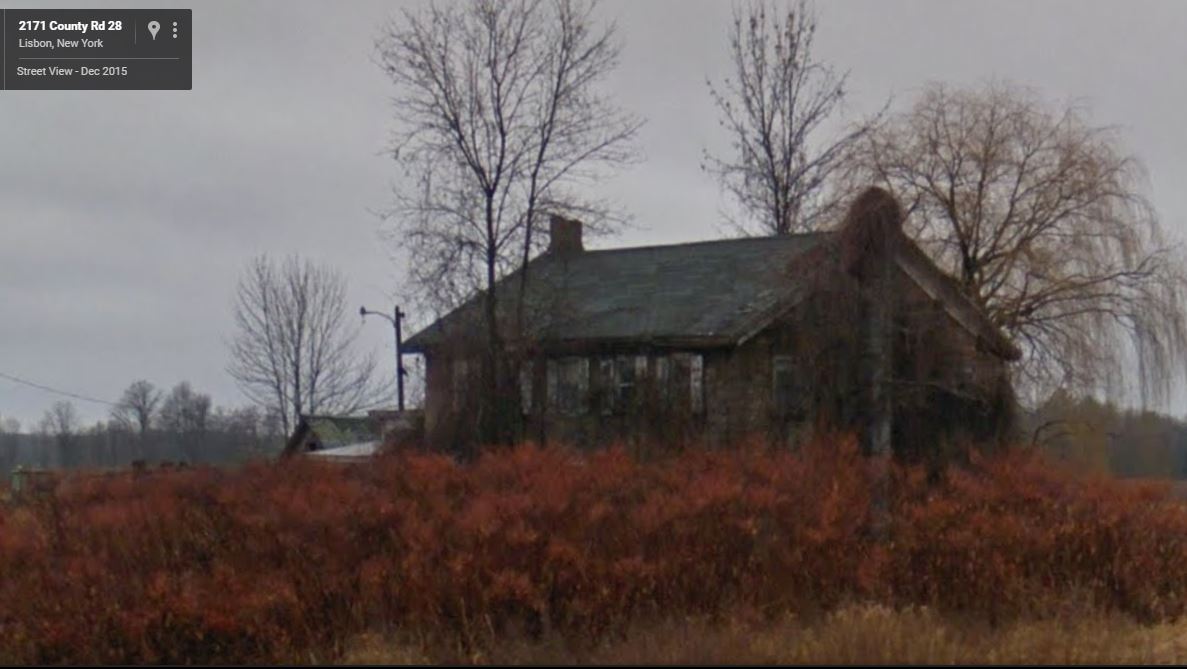
In the Sucker Brook section of the town of Waddington, where this small native sandstone house is located not far from the village of Waddington, Albert Scott for some years operated the pioneer sawmill reputed to have been established there in 1802 by his father, I H Scott.
On October 13 1840 Albert Scott purchased from Daniel C Judson, the Ogdensburg banker, business man and landowner, the 80-acre tract upon which this house was shortly afterward built, in all probability. Here he and his wife, Caroline, resided, and devoted most of his active life to the lumber business.
When Albert Scott died June 14 1888 he willed his widow, Caroline, a life-use of his farm, and provided that after her death the place should go to their daughter, Emeline, in life-use. After that it was to become the absolute property of Albert Scott's grandson, William L Purves or Purvis.
The record shows that almost immediately the other heirs of Albert Scott began conveying their interests in the property to Mr Purves. On October 8 1888 Caroline Scott and her daughter, Emeline, deeded their rights in the place to Mr Purves. By two other deeds on the same date Mary E Porteous and Sarah R Parlow, two other daughters of Albert and Caroline Scott conveyed their interests to Mr Purves, who was then 27 years of age.
Son of Donald and Lucina Scott Purves of Waddington, William L Purves was born there April 12 1861. He received his education in the Waddington schools and in the business college at Poughkeepsie. Then he engaged in the lumber business for a number of years with his father and his grandfather, Albert Scott.
William L Purves was married to Mary Agnes Dunn of Waddington on March 9 1891 and at some later time they became residents of the village of Waddington. There Mr Purves became a member and president of the school board, a trustee of the village and ultimately its mayor.
A tract of 70.06 acres, upon which this old stone house stands was sold by Mr Purves and his wife. Mary, to Harvey W and Anna H Stone on March 1 1922 for $6,250. The same tract was conveyed by Mr and Mrs Stone to Elmer W Stone and wife, Mrs Ruth W Stone, on August 16 1947 and on November 14 of the same year they disposed of this house and one acre of the land to Mrs Bertha E Dunn, wife of the late William Dunn, to whom William L Purves had sold his business in 1910.
William L Purves died April 12 1943 aged 82 and his wife died May 28 1947 at the age of 78. She was the daughter of the late Robert F and Jane Veitch Dunn. Robert H Purves, son of Mr and Mrs William L Purves, followed in the footsteps of his father and became mayor of the village of Waddington.
William Dunn, husband of the present owner of the old stone house, was born August 29 1860 on a farm, son of Robert F and Jane Veitch Dunn and therefore the brother of Mrs William L Purves. For some years William Dunn worked a farm, but from 1910 to 1921 he operated the sawmill, which he had acquired from Mr Purves. On May 12 1897 Mr Dunn was married to Miss Melinda Lawrence of Madrid, who died April 6 1920 leaving him and a son, Robert, as her survivors. On June 21 1921 William Dunn married Miss Bertha E Freeman of Waddington present owner of this house. Mr Dunn died October 9 1946 at the age of 86.
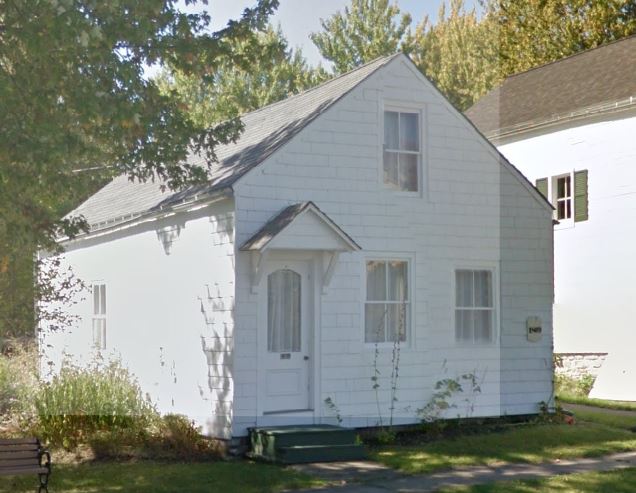
The story of this little house and its next-door neighbor, the Pickering-Beach historical museum on the outer end of Main Street, Sackets Harbor, is somewhat legendary. Both are Pickering houses and the story is that this one was constructed about 1812 and used for a time as a hospital during the War of 1812. The larger one, now used as a museum, stands next to the battlefield and is claimed to have been erected about 1816. According to the same source this little house was first occupied by the Pickering family, and after the larger house was completed about four years later, was assigned to the family servants. Today, it is occupied by Mrs William Mott, curator of the museum.
If county records are any criterion neither of these Pickering houses was built before 1816. The record shows that none of the Pickerings owned real estate in Jefferson County before that year and that the first of the family to buy realty in this county was Joshua Pickering, who died about 1822 came to Sackets Harbor in time to see Henry Eckford build Commodore Isaac Chauncey's battle fleet and was probably descended from John Pickering of New Hampshire.
This first purchase of Jefferson County land consisted of three lots on the south side of Main Street, Sackets Harbor, in the locale of these two Pickering houses, and was made on January 1 1816 for $200 from Colonel Elisha Camp and wife, Sophia
The documentary record of the property is sketchy from that time on, but at the death of Joshua Pickering the houses must have passed to his son, Captain Augustus A Pickering.
Captain Augustus A Pickering was the first to lake a commercial ship
into the port of what is now Chicago. That he did on June 14 1834 it being
the schooner "Illinois," in which he set out from Sackets Harbor
on May 12 of that year with a cargo of wagons and farming implements and
a large delegation of North Countrymen to colonize the Chicago area. Ten
years later, on June 5 1844 he died in the province of "Upper Canada,"
Ontario, and it is reported that he committed suicide because he had built
a ship, "Ariadne," which was an inch too wide to pass through
the locks of the Welland canal.
On June 18 1844 his widow, Caroline, petitioned to have herself and James White of Henderson appointed administrators of his estate. Pickering had left five minor children, Clarissa, Gustavus, Mariette, Caroline and Olivia. Mariette who became Mrs Hay gave the Hay Memorial library and Pickering chimes to the Presbyterian church in Sackets. Olivia married Lieutenant Governor Allen C Beach and became the ultimate owner of these houses.
From her title went to her daughter, Mrs Amy Beach Ewers, wife of Colonel William V Ewers. Mrs Ewers died in Sandys Parish, Bermuda, January 8 1936 willing these houses and contents to Attorney G Willard Rich, New York City, in trust, with instructions to convey them within six months after her death to some person or body for a museum. On June 10 1941 he deeded them to the village of Sackets Harbor and a civic association was set up, which took over their operation and management. Mrs Myron E Avery is now head of that organization and the group has done a most creditable work, assembling an unusually excellent collection of antiques of a history pertinent to Sackets Harbor and this county.
143 E Joseph St
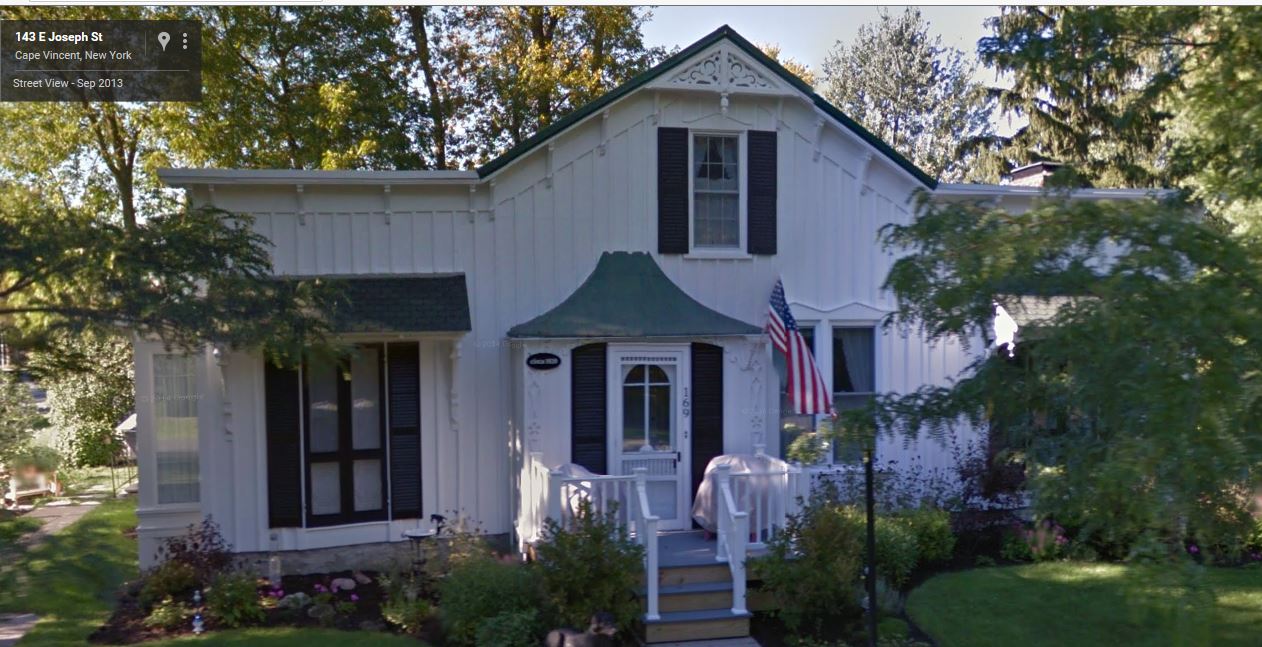
An interesting and attractive example of early American Gothic with shutters is this old Buckley house in its peaceful, sequestered location on Joseph Street at the corner of Point Street in the charming and historic village of Cape Vincent.
An atmosphere of beauty and comfort fills the spacious rooms enhanced by a number of fine antique pieces including two pier glasses. Outside, tall trees along the front throw a cool shade across the broad, deep grounds studded with handsome lilacs, conifers and shrubbery.
The house, in the neighborhood of a century old, occupies land owned by only two families in a period of 105 years, the Buckleys and the Potters, both prominent, and the five-eights acre lot, upon which this house stands, is only a few feet away from one owned by Paul Charboneau Jr on the corner of Point Street and Broadway.
Paul Charboneau Jr, it will be remembered, was one of the Napoleonic refugees who made his way to Cape Vincent after the Waterloo debacle, and concerning him the record shows that on September 29 1820 he purchased the Point Street-Broadway lot from Vincent LeRay de Chaumont of LeRaysville.
James Buckley, one of the early residents of this village, was a man of means and owned several real estate properties in the town of Cape Vincent. In fact, on December 26 1821 he purchased one next to that of Charboneau. When the First Presbyterian Society of Cape Vincent was formed February 13 1832 James Buckley was one of its first trustees. He was one of the petitioners for Cape Vincent Lodge, No. 344 F & A M, which was instituted July 10 1822. His wife, Tryphema, signed the first constitution that formed the Auxiliary Female Missionary Society of Cape Vincent, organized before any church there.
The Buckleys were, indeed, people of importance in Cape Vincent. Samuel Buckley is reputed to have operated the first stage coach line to Watertown. W B Buckley was first agent of the American Express Company at Cape Vincent.
On January 16 1845 James Buckley purchased the two lots forming the scene of this house from Vincent LeRay through the latter's attorney Patrick Somerville Stewart. Then on November 28 1859 he and his wife Tryphena conveyed the place to Mrs Mary E Buckley, wife of William B Buckley and it was Mrs Mary E Buckley who sold the property to Mrs Emma Louise Potter, wife of Dr George A Potter, August 23 1901.
Dr Potter, one of the prominent dentists of the county, born November 26 1865 in Consecon, Ontario, son of Dr Handley B and Sarah Miller Potter, practiced 50 of his 53 years in Cape Vincent. When he died October 5 1943 at the age of 77 he was the county's oldest practicing dentist.
His widow, The former Emma Louise Mount, born September 27 1873 daughter of Dudley D and Eliza Miller Mount, was a native of Three Mile Bay and member of its first families. She was married to Dr Potter December 21 1892 the year he established himself at Cape Vincent. They both became active in civic and social circles. Dr Potter was master of the Cape Vincent Masonic Lodge and Mrs Potter was matron of the Eastern Star Chapter in that village. Dr Potter headed the county and the fifth district dental societies. Mrs Potter was chairman of the town's War Chest fund in World War 1. She was a director of the Three Mile Bay Cemetery Association and raised the money for building its vault. She died October 29 1949 aged 76. This house and contents belong to her estate.
Both Dr Potter and his wife are buried in the Three Mile Bay Cemetery. James Buckley and his wife, Tryphena, on the other hand, are buried in Cape Vincent's Market Street Cemetery. James died May 12 1876 aged 84. Tryphena died October 13 1877 aged 77.
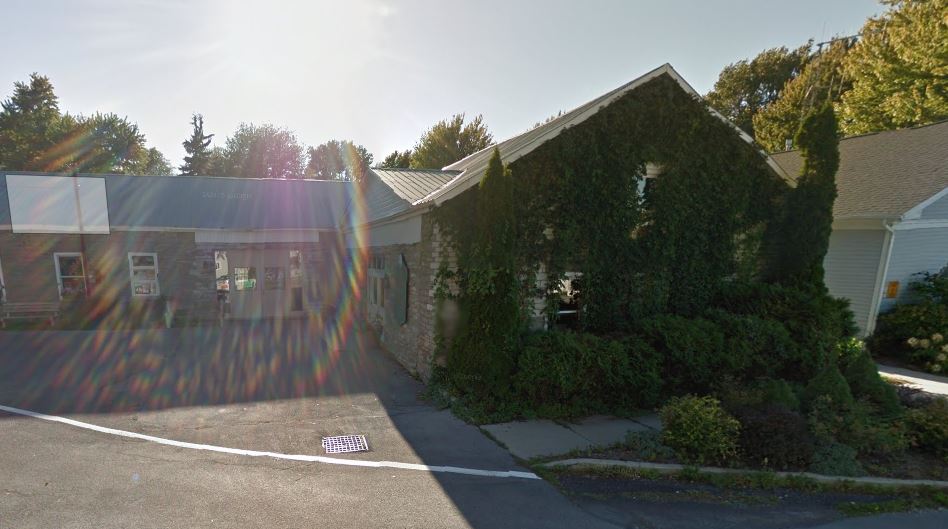
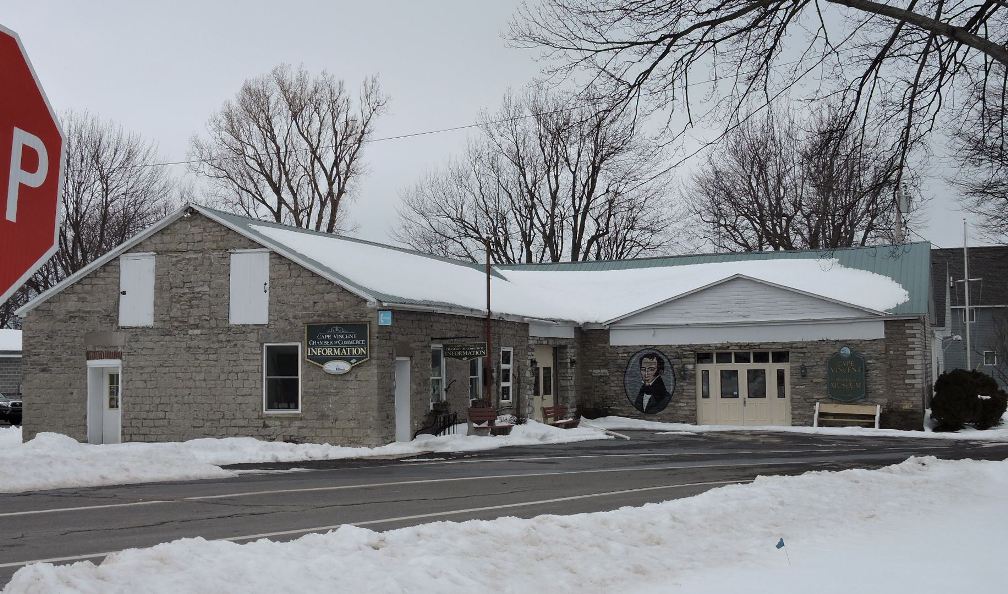
Unpretentious in type this house, built almost a century ago, is upon the west side of the outer reaches of James Street at the outskirts of the village of Cape Vincent. The upright of native limestone has been given a thin coat of stucco at some time. The spacious wing is of wood. Flowers and shrubs ornament the site, which early in the last century was a small part of the immense land holdings of the LeRays.
It was one of the many parcels of land, which Otis P Starkey owned at one time or another in the village and township of Cape Vincent. Mr Starkey, who died January 6 1857 at the age of 59 was one of the most prominent men of Cape Vincent. He was postmaster of the village from 1845 to 1849. In 1836 he was member of assembly. When St. John's Episcopal church was organized January 25 1841 he was one of its first vestrymen and he gave the acre of land upon which its church edifice was built that year. In 1853-4 he was supervisor of the town of Cape Vincent and in 1856 he was president of the village. His widow, Mrs Beulah Starkey, died May 9 1876 in her 74th year. They had several children.
On November 29 1852 Mr and Mrs Starkey sold the 1.41 acre site of this house to Charles P Morrison for $150 and it is likely that shortly afterward Mr Morrison, who was another prominent resident of the town and a founder of Riverside cemetery, erected this house. Then on September 30 1857 Charles P and Margaret C Morrison disposed of the place to William D Fuller who served the town as supervisor in 1862-3. On April 30 1864 William D and Cornelia R Fuller sold to Mrs Malinda Cough.
Mrs Cough was the wife of Henry Cough. Mrs Cough died on May 24 1873 in New York City. Under her will executed September 15 1872 she gave this residence to her husband absolutely and willed him a life-use of the balance of her property. Shortly afterward Mr Cough married again and January 5 1875 made a will giving his second wife, Emeline, a life-use of his entire estate, providing that what remained after her death should go to his son, Jeremiah W Cough.
Henry Cough died January 26 1885 and in due time this house and 1.41 acre lot came into possession of Jeremiah W Cough, who lived until May 26 1928 when he died at the home of a daughter, Mrs Jennie B Mills in Cecil, Wisconsin. The estate of Jeremiah W Cough was small and his property had to be sold to satisfy it. As administrator of the estate Attorney Charles A Phelps conveyed this stonewood house and lot to Robert E Grimshaw November 30 1929. Born on Wolfe Island April 28 1859 Mr Grimshaw was a Cape Vincent farmer, horse-breeder and horse trainer more than 60 years. His first wife was Miss Nellie Canfield, whom he married in Cape Vincent in 1885. She died in 1898 and in September, 1900 he married Miss Jean Ann McCullock, a native of Wolfe Island who had come to Cape Vincent in 1890.
Mr Grimshaw died July 22 1946 at the age of 87 giving all of his property to his widow. On April 2 1949 she died at the age of 91. On September 7,1949 Ralph VanSchaick as executor-trustee of her estate, sold the residence on James Street to Franklin A and Dorothy E Sovie. Mrs Sovie, daughter of Mr and Mrs Leland Fryer, Cape Vincent, attended the Cape Vincent school and served in the village postoffice for a time prior to her marriage June 5 1943 to Mr Sovie, son of Mr and Mrs Otis Sovie. He attended the Ogdensburg schools and has been employed by the New York Air Brake company
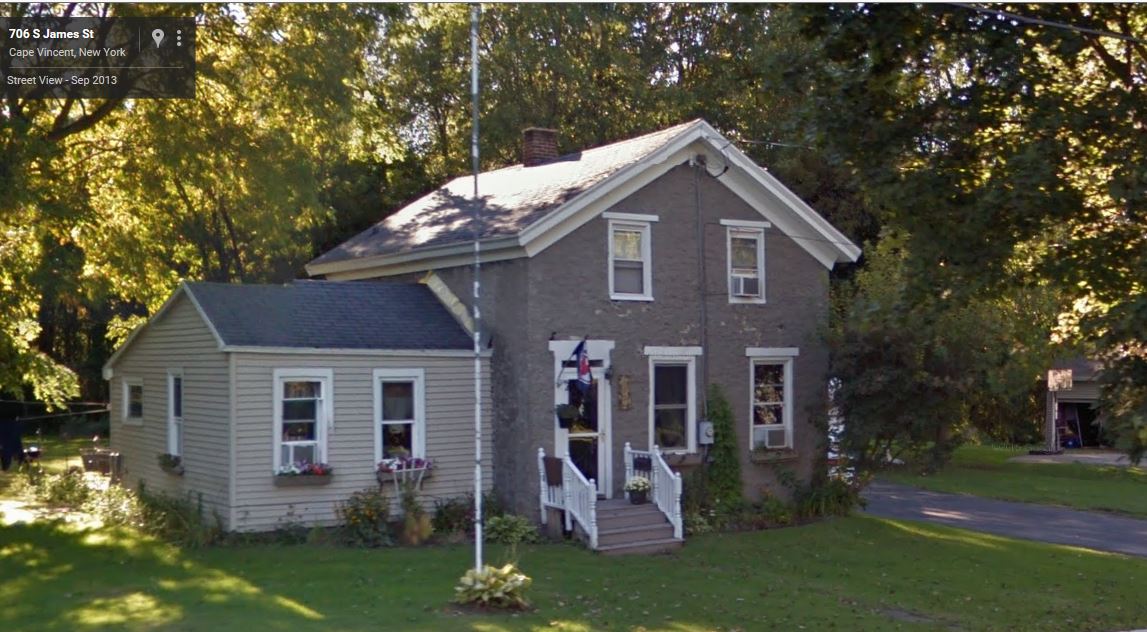
Notwithstanding that this scrupulously neat and well kept native limestone house on the West side of James Street, Cape Vincent, has been owned in the Breslin family 85 years, it was at one time, 98 years ago, the property of Hyacinthe Peugnet. Hyacinthe Peugnet, born in France June 24 1794 was one of three brothers who were loyal officers of Napoleon at the time of his final defeat and abdication as emperor of France.
These three brothers, Hyacinthe, Louis Desiree and Theophilus were among the Napoleonic refugees at Cape Vincent, and after some years acquired the historic "Stone House," beautiful mansion of Vincent LeRay de Chaumont which was erected on the upper end of Broadway 1815-1817 and which is now the summer home of Mr and Mrs John L Johnston. The three Peugnet brothers also purchased the town of Cape Vincent holdings of Count Pierre Francois Real, builder of the famous Cup and Saucer house as a retreat for Napoleon, a property which the Peugnets acquired in the Real transaction.
This old James Street house, built upwards of a century ago, possibly by Horace Cross or Sidney Langworthy was conveyed by Sidney and Juliette Langworthy to Hyacinthe Peugnet, then of New York City, on August 7 1852. On January 16 of the same year Langworthy had purchased it from Horace Cross.
On October 9 1857 Hyacinthe Peugnet and his wife, Emeline, conveyed this same property to Charles Peugnet for a nominal sum and on September 16,1865 Charles Peugnet sold it to Morris and Bridget Brushnen, a name, the spelling of which has been so altered that it has been variously known as Brushnan, Breshnen, Bryclan and now Breslin. Bridget died October 25 1870 leaving her husband, Morris sole owner On April 29 1872 he married Bridget Maria Egan. He died April 15 1906 appointing her sole executrix. The name then appeared Breslin.
Bridget Maria Egan Bryclan retained possession of the house and large lot until November 26 1926 when she deeded it to Evelyn M Breslin, of Washington, D C, also known as Bryclan. A recorded deed, dated September 24,1944 shows that she conveyed the place on that date to Augustine S and Florence W Breslin.
In any event Augustine S Breslin, native of Cape Vincent where he was born December 16 1875 son of Morris and Bridget Maria Egan Breslin, resided in the house for the past few years, dying on March 27 of this year at the age of 74 leaving his widow, Mrs Florence Whitaker Breslin, sole owner. Mr Breslin was educated in the Cape Vincent schools, then became a clerk in August, 1892 in the Cape Vincent office of the American Express company under Agent William Buckley. Later Mr Breslin was an express messenger, became cashier in the Amsterdam office in 1902 agent at Fonda in 1905 later agent at Ilion and Oneida and retired in 1940. Besides his widow he is survived by two daughters, Mrs Herbert Decker and Mrs Donald Martin. Mr Breslin's marriage to Miss Florence Whitaker, Plessis took place January 27 1902.
In spite of the fact that the three Peugnet brothers came to Cape Vincent in the early years after Waterloo the records in the county clerk's office show Hyacinthe Peugnet owning no real estate in this county until April 10 1837 when he joined with his brothers in buying Count Real's Cape Vincent lands from Real's daughter.
Records of the St. Vincent de Paul church cemetery in Cape Vincent show that Hyacinthe died June 13 1865. His wife, Emeline Joseph Peugnet, born March 24 1804 died December 24 1878 and is also buried there as is Charles Peugnet, born September 21 1832 and who died October 9 1868 Theophilus Peugnet, born September, 1800 died January 15 1868 and is buried in the same cemetery, but Louis Desiree Peugnet, the other brother of Hyacinthe and Theophilos, lies elsewhere.
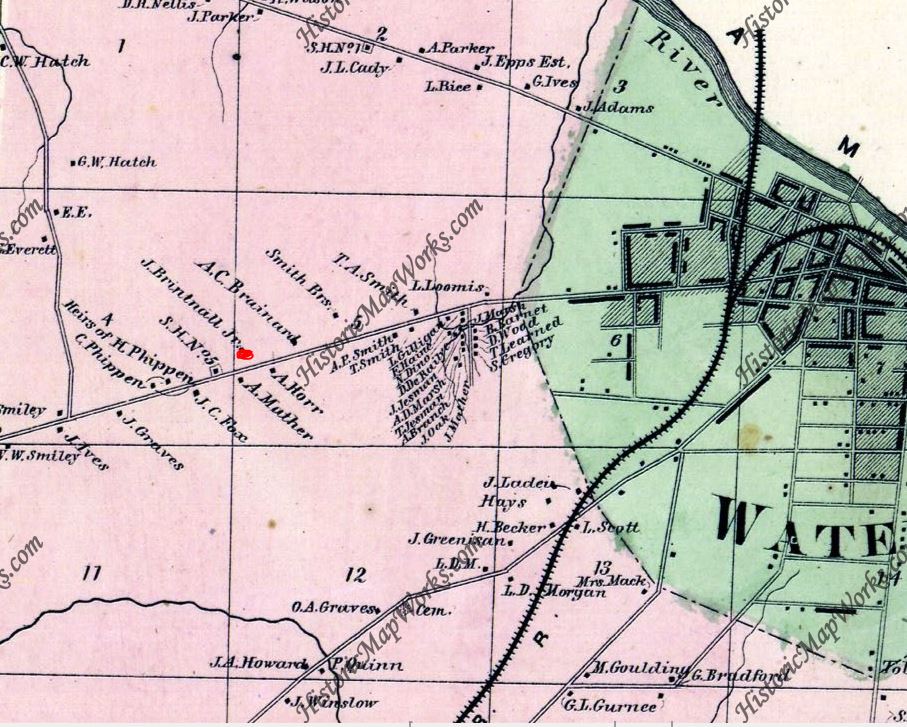
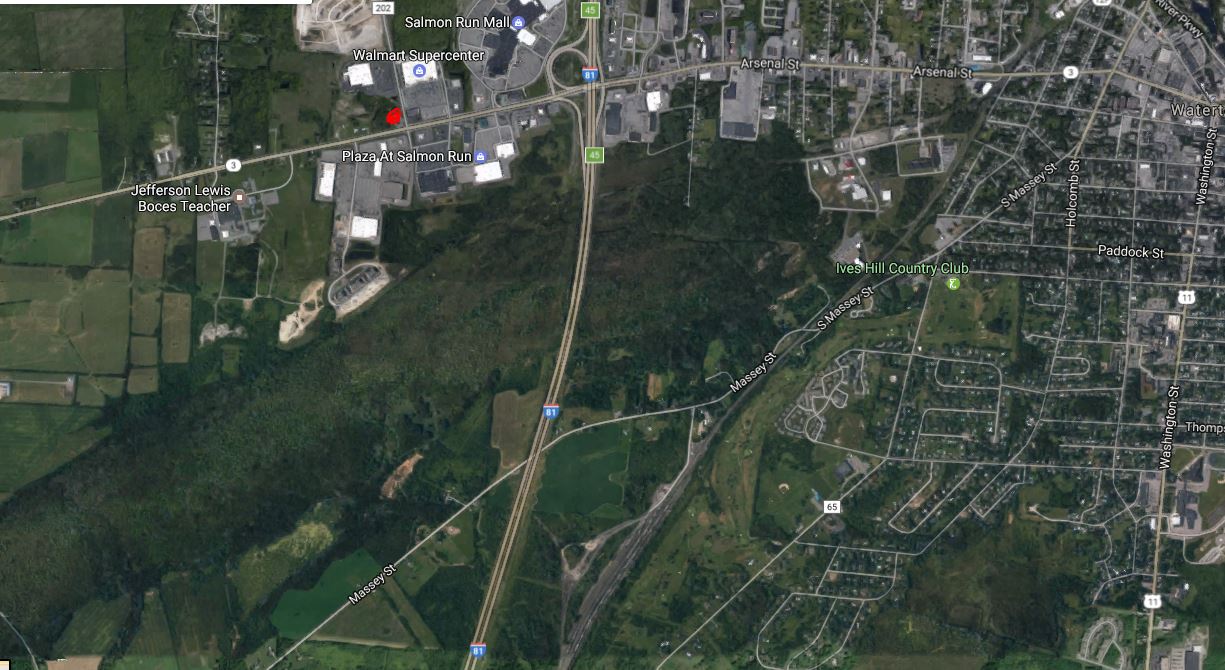
From county records comes the inference that this native limestone house on the north side of the Watertown- Sackets Harbor road about two and one-half miles west of the city was built over 120 years ago. The land upon which it stands was deeded to Hart Massey Sr, August 20 1811. At some later date the farm site of this house came into the possession of Hart Massey Jr, for on April 30 1836 he sold the place to Albert P Brayton for $2,320.
On February 16 1844 Albert P Brayton and wife, Louisa C Brayton, conveyed it to Dexter Haven for $3,300 and on May 27 1845 Brayton acquired a 29.85 acre tract from Alexander and Betsey Parker to add to it. Next, on April 1 1848 Dexter and Mary Haven disposed of the property to Vilander Adams for $3,400 and on April 1 1859 Adams deeded it to James Brintnall Jr. He willed it to his daughters, Jennie E and Anna Brintnall, who resided there for some years.
Anna Brintnall transferred her interest in the property to her sister, Jennie E Brintnall for $2,600 on February 19 1892. She became the wife of Byron G Barbour and under the name of Jennie E Barbour she sold the property to Henry H Smith of this city April 24 1894. Mr Smith died intestate on September 7 1901 and on October 3 1904 his estate consisting of his widow, Mrs Evelyn C Smith, son, Starr King Smith, and wife, Edith Sarah Smith of Syracuse, sold the 46.51 acres that was left of the farm, after Henry H Smith had sold off some acreage, to John E Barbour.
Henry S Barbour, individually and as executor of John E Barbour, transferred to Maitland B and Jennie A Baker February 12,1913 and on October 30 1916 it was sold by them to Martin B Tillotson, who resided there for several years and on May 15 1945 conveyed it to Don L and Helen L Eastman of this city. Mr and Mrs Eastman sold it to Alma Ross Miller December 4 1945.
Mrs Miller on June 9 1948 sold off the house, barns and 2.86 acres of the 46.51 acres to Dr Ferdinand O Johanson, veterinarian, who resides and has his office there. When Dr Johanson purchased the place the stonework had been covered with concrete and marked off to look like concrete blocks. He has removed that and other accretions which obliterated the beauty of the place and has accomplished a fine job of restoration, returning the old house to its original handsome appearance. Landscaping of the grounds has also enhanced the property. Dr Johanson was graduated from Cornell in 1935 and for three years was with the bureau of animal husbandry of the state department of agriculture and markets. Also for a number of years he was with Sheffield Farms Inc., and in 1943 established himself in private practice.
Martin B Tillotson, florist and landscape gardener, native of Riverhead, Long Island, married Miss Mary Lennox sister of Mrs Loren E Harter, October 4 1911 and moved to this farm in 1916. From May 22 1922 to August 30 1939 they were superintendents of the Jefferson Farm school. Maitland R Baker, for some years resided there and manufactured hamburg steak, which he marketed in this city and other communities. Henry H Smith, who died in this city at 78 was for many years a schoolteacher in Rodman and elsewhere, and latterly conducted a private school in the Doolittle & Hall block, now the Lincoln building. James Brintnall Jr, son of one of the town of Watertown's oldest and most prominent settlers, was born in the town February 5 1825 and May 14 1846 married Elizabeth, daughter of Nathan Talcott, proprietor of Talcott's tavern near Adams Center. Mr Brintnall died November 23 1888.
Hart Massey Jr, was son of one of the original settlers and heavy landowners in what is now the city of Watertown.
There are fine characteristics about this house at 406 New York avenue, in the city of Ogdensburg which instantly charm the passerby. The wrought iron balustrade around the border of the verandah roof is an unusually fine piece of craftsmanship. It is doubtful if there exists a superior specimen in the north country, and, painted black, it neatly sets off the white of the house.
The information forthcoming on this house has been so meager that, from it, it has been difficult to establish the age of the structure, but it appears to be about a century old. The small-paned windows indicate an old construction, and back in the 1850's, or before, brackets along the cornice were much used.
Who built the house is something requiring more exhaustive research. It may have been an early member of the Kelly family in Ogdensburg, for in a judgment of partition dated November 9 1852 in the action of Life Baldwin vs. John Kelly et al, all of Block 16 Lot 3 was set off to Mr Baldwin. On November 30 1852 Baldwin and wife, Susannah, conveyed the same to John S Kelly, who on November 1 1854 transferred seven lots in the block to Francis M Hill, who on the preceding January 1 had conveyed his interest in the same to Abby C, H Kelly.
There were some ensuing conveyances among the Kellys until September 22 1864 Mrs Abby C H Kelly, Andrew and Elizabeth Cole disposed of six of the lots including the site of this house to Reverend L Merrill Miller, DD on March 29 1867, September 27 1869 and January 18 1886. Dr and Mrs Lydia B Miller sold the lots to James McGuire or Maguire.
Born in Rochester October 13 1819 Reverend Dr Miller was graduated from Hamilton in 1840 studied theology at Princeton a year and a half, was ordained at Bath in October 1844 married Lydia B Ramsey in October 1846 was called to the First Presbyterian church of Ogdensburg in February 1851 and built the new church there in 1866-7.
James McGuire, born in Ireland June 24 1822 came with his parents to Waddington in 1831 settled in Ogdensburg in 1832 was educated there, became a stone mason and built many of the most substantial buildings in and near Ogdensburg. In 1849 he married Miss Annie Smith and was the father of nine children.
Mr McGuire was a man of prominence in Ogdensburg, member of the Presbyterian church, assessor for a number of years and alderman in 1891-2. He and his family resided in this house and when he died May 29 1908 he gave his widow a life-use of his estate, but provided that after her death the north half of the house should go to his son, James M McGuire, and the south half to his son, George M McGuire.
A daughter, Annie, of James and Annie Smith McGuire was married to Ira H Foote in 1882 Me. Foote having been born in Turin December 5 1849 son of Giles and Pamelia Lee Foote and for some years prior to his retirement was a New York Central engineman. He died May 16 1936 in this house at the age of 87 and Mrs Foote died there October 14 1938 aged 80. The south half of the house had been conveyed to her and Mr Foote by George M McGuire December 24 1919 and the north half by James M and Charlotte McGuire December 12 1919. After Mr Foote's death the house went to their son, Ralph Foote, New York City, advertising manager of the Beechnut Packing company. On July 26 1939 he gave it to his uncle Fred S McGuire.
Ralph Foote, who left Ogdensburg in 1902 and lain engaged in the advertising profession, was married to Miss Mary K Walton of New York on April 19 1927 and now holds one of the most prominent advertising positions in the country
Pretentious today with all of its pillared, modernish verandahs and framed expansion, the little, one-story native limestone house that once belonged to Joseph Luff on Black River Bay near the mouth of Mill creek, seems submerged. Nevertheless it does peek out from beneath the floor of the second-story verandah and disclose its identity.
Not much is to be found in the county records about the Luff house, but tradition has it that it was erected about 1816 just after the close of the War of 1812 as the farm home of Joseph Luff. In the neighborhood of 55 years ago it was purchased by Nathaniel P Wardwell, the banker, Edward B Sterling, the paper manufacturer, and Samuel F Bagg, the steam engine maker. About that time the wooden additions and verandahs were added, converting it into a grand place, which, with its 115 or so acres became known as "Shore Farm," and was used as the summer home of the Wardwells, Sterlings and Baggs. After some years the sole ownership came into the N P Wardwell family, and passed to Addison F Wardwell and the late Samuel B Wardwell, sons of Mr and Mrs N P Wardwell. Today it is owned by Addison F Wardwell and the estate of his brother, Samuel B Wardwell, and is still used as a summer home, although there was a period of 16 years between 1930 and 1946 when Mrs Eunice Remington Wardwell, wife of Samuel B Wardwell, operated it successfully as a high-calibre summer camp, where youths could ride horseback, swim, sail, play tennis and enjoy wholesome recreations in summer's open-air.
Beginning with the original owner, it can be said that Joseph Luff w as one of the sons of Samuel Luff, head of an English colony which came to Sackets Harbor in 1805 to settle. There were six other children and they located near the mouth of Mill creek, where the elder Luff had purchased a large tract on either side of the creek mouth. There, at the mouth of the creek, he built a dam and one of the first grist mills in the county. Not long afterward he constructed a sawmill on the opposite side of the creek, and made much of the lumber used in the development of Sackets Harbor.
Docks were constructed at the mill and sailing ships came there to lade with lumber for export to New York City and other points, for there was much spruce, cedar, tamarack and black ash in that areA Joseph Luff died intestate July 24 1857 and the old stone house and farm, went to his family.
Nathaniel P Wardwell, son of Nathaniel Wardwell Sr, and grandson of
Micah Sterling, was born in the limestone Sterling mansion on Sterling
place, and engaged in a banking career. Beginning with the National Bank
& Loan company, he early transferred to the Watertown National Bank
as its first cashier, when it was organized in 1882. When he died in 1909
he had been president six years. He was also vice president of the Jefferson
County Savings bank and a director of the Ontario Paper company and of
the Agricultural Insurance company at one time. Mrs Wardwell was the
former Miss Ella F Farwell.
Addison F Wardwell later came to follow in the footsteps of his father as head of the Watertown National bank and is now head of the Carthage Machine company. His brother, the late Samuel B Wardwell, was the managing force of the former Oswegatchie Paper company, while his widow, the former Miss Eunice Remington, is the daughter of the late Charles H Remington, head of the Remington group of paper mills. She is a great-granddaughter of Jasan Fairbanks, one of Watertown's most prominent early settlers
418 Market St
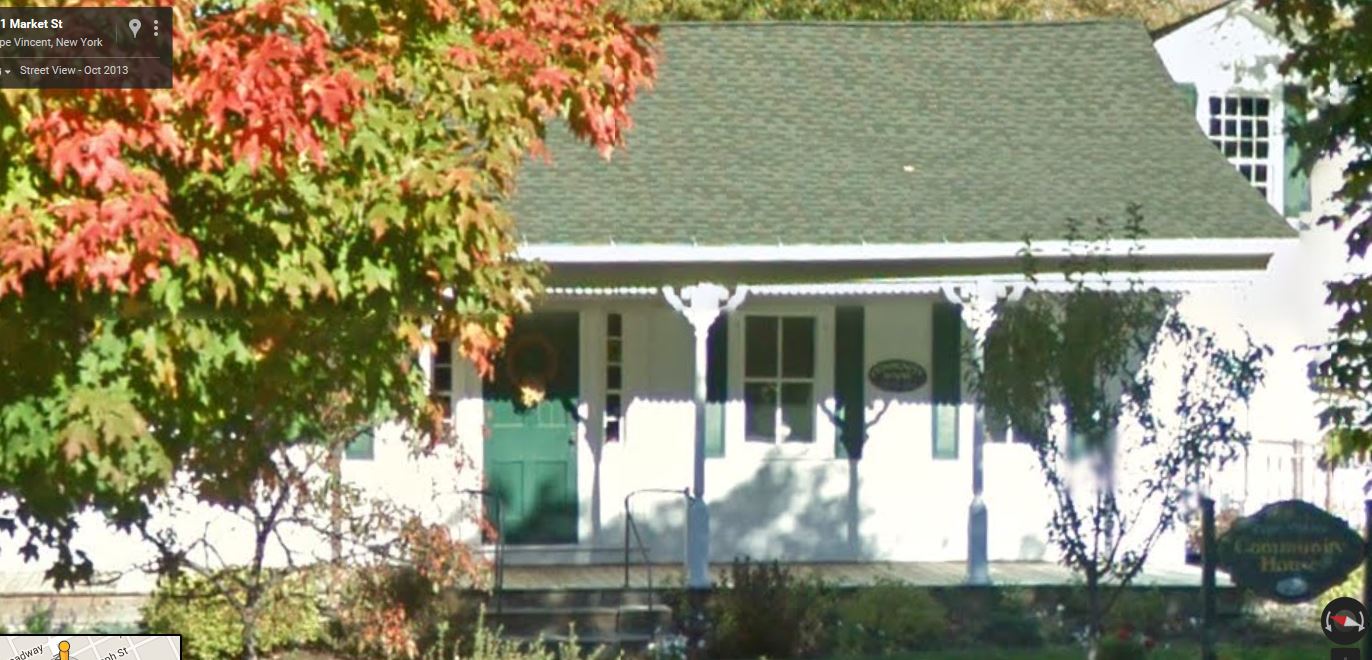
As one enters the heart of Cape Vincent village on the old turnpike road from Watertown which is designated Market Street, he is captivated by the soothing beauty of architecture of the house at the corner of Market and Joseph Streets and the air of contentment that surrounds it.
The site was sold by Vincent LeRay de Chaumont to the Borlands who, it is likely, built the house upwards of 120 years ago. On May 26 1828 John Borland conveyed the property, consisting of five eighths of an acre of land, to Walter B Borland for $1,000. Smith Bartlett of Kingston, Ontario, purchased it from Walter B and Chloe Borland and Maria, wife of John Borland, on June 30 1842 for the same price of $1,000.
Smith Bartlett died November 12 1867 at the age of 86. By his will he gave the Episcopal church $100 a year for three years to aid the rector's salary, gave his grandson, Henry A Duvillard 27 volumes of Penny's Cyclopedia, gave Mrs Roderick (Amey Ann) Rose twelve volumes of British Reformers, and his residence at the corner of Market and Joseph Streets with furniture, remainder of books, pictures and wearing apparel, to his son, George F Bartlett.
George F Bartlett, a prominent resident, served some years as justice of the peace, was supervisor in 1865 and again in 1867-8. His widow, Sarahette A Bartlett sold this house and lot to David Laird September 18 1897 for $1,025. Mr Laird, a prominent Cape Vincent farmer, died September 29 1902 giving his wife, Mary C Laird, a life-use of his property. He then provided that a girl named Mamie Dunbar who had been living with them and was known as Mamie Laird should have the property.
Charles Armstrong, president of the Bank of Cape Vincent settled up the
David Laird estate, and on March 10 1931 Mamie Laird Bates and husband,
Jesse Bates of Mayville, NY, sold the place to Caruthers Ewing, New
York City's summer resident of Cape Vincent 40 years, and general counsel
for the Great Atlantic & Pacific Tea company. Mr Ewing, 75 died
August 20,1947.
On May 20 1931 Caruthers and Bessie W Ewing sold it to Stuyvesant
Fish, prominent New York broker and Cape Vincent summer resident, but
at the request of Mr Fish, Mr Ewing deeded the historic old house and
lot directly to the village of Cape Vincent, which has made it available
as a civic center.
Not only does it house the Community Library, but the meetings of the
Cape Vincent Improvement League are held there and in general the structure
serves most useful village purposes, it is pointed out by Mrs Armstrong,
Cape Vincent historian, by Mr Armstrong and by Henry Augustus, who is
much interested in Cape Vincent history.
Thus, through the benevolence of Mr Fish, great-grandson of Hamilton Fish, secretary of state in President Grant's cabinet, and member of one of the nation's most noted families, there is entrusted to the village of Cape Vincent for its use and preservation a most attractive architectural example and richly historical dwelling.
This is made certain through the original Borland ownership, for James Borland who acquired the site of the house from Vincent LeRay de Chaumont in 1828 was one of Cape Vincent's earliest settlers having come there from Montgomery county in 1815. He was the great-grandfather of Karl H Borland, Cape Vincent, who is also descended from Eber Kelsey who began building the settlement at Gravelly Point, now Cape Vincent, for Vincent LeRay in 1809.
was owned by Leonard Peck in 1858, though sold to James H Griswold in
1860. The old map below is 1864 so should have found J Griswold. The red
dot though would be the Evans Rd
The description below says "The parcel begins in the center of the
old Rome State road" and in 1888 J Griswold DOES appear on - but
again on Evans Rd. Possibly the other end of the property does end over
at the Rome State Rd
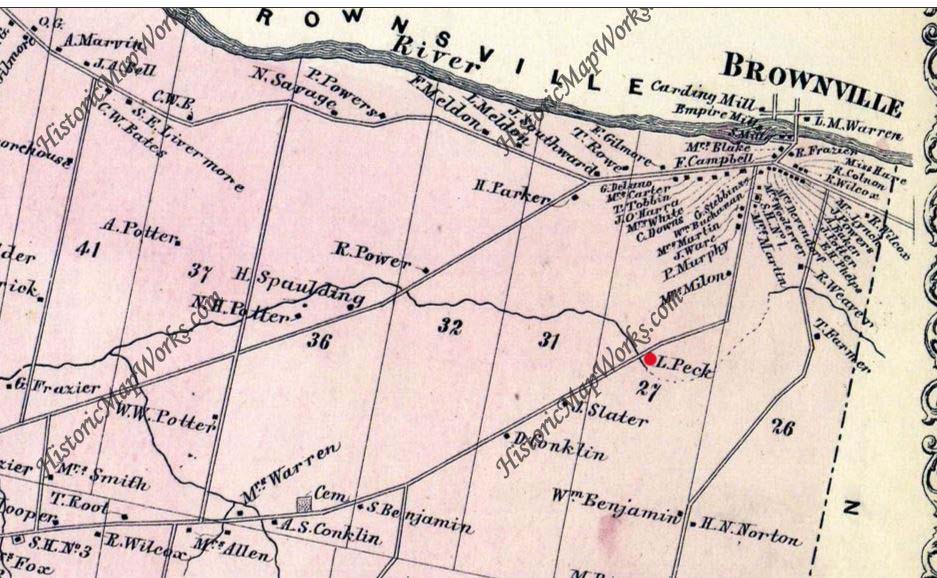
In spite of its dilapidation there is an air of dignity about this old
house which instantly stamps it as a place of importance in an earlier
day. The deed of its 231.03 acres from M Hurl Gilmore, unmarried, town
of Hounsfield, to the present owners Harry J and Anna C Siver, town of
Brownville, on August 5 1946 states that the main parcel of 170.97 acres,
upon which the house and buildings stand, was known as the William Lord
farm. It is located near Brownville village on Evans Rd
The parcel begins in the center of the old Rome State road and later deeds indicate that it was the property of William M Lord rather than of his nephew. Colonel William Lord, who was born at Woodstock, VT in June 1792 and came to the Black River country about 1816.
Lt Colonel William Lord, who later established the stone machine shop and foundry in Brownville. where plough points were made for the early ploughs wooded by his brother, Judah Lord, came, to this county from Vermont as a bookkeeper for his uncle, William M Lord, who kept tavern in Brownville village
When William M Lord leased the hotel, his nephew, William, taught school at Blanchard's Corners for a year. Then he began making wooden ploughs and later joined with Alanson Skinner in the firm of Lord & Skinner. He became noted for the quality of products which his firm manufactured.
William M Lord was one of the most prominent residents of the town, he was one of the founders and first directors of the Jefferson County Agricultural society, representing the town of Brownville
When the Brownville Navigation company was formed June 5 1810 by legislative act, William M Lord was one of its stockholders and also became one of the commissioners appointed to carry out the objects of the company. When this company built the steamboat Brownville in 1827 William Lord was one of those vitally interested in it. Frank H Gilmore of Geneva, executor of Elsie M Gilmore of Hounsfield, sold this farm to Edwin A Gilmore and M Burt Gilmore of Hounsfield on June 2 1919 for $11,000. On January 31 1907 it had been conveyed to her by Winfield S Parker, widower, James G Parker, Marion A Parker, Grace S Parker, all unmarried, of Cape Vincent, Fred F and Ettie S Knapp, Watertown; James G Knapp, unmarried, S I Joseph, Missouri; Ada J Taylor, Voorhiseville, NY, and Elsie M Gilmore, heirs of James H Griswold, lo Elsie M Gilmore, town of Watertown.
James H Griswold had purchased the main parcel of 170.97 acres from William J and Frances Martin and Leonard L and Susan M Peck February 23 1860 and on December 23 1858 William J and Margaret Martin had conveyed it to Leonard L Peck for $8,305.25. On January 2 1857 Charles N Ely, Watertown, sold the property to William J and William N Martin for $8,880.80 and Ely had acquired it from William S Ely who bought it on September 2 1826 from William M Lord and wife. A conveyance also shows the William N Martin conveyed his interest in the property to William J Martin February 24 1858. Lord had purchased the site in the early 1800's from the original owners of the township
It is said that in the Civil War days it was the scene of many a gay party attended by Civil War soldiers, who danced there and lent colorful tradition to the big house.
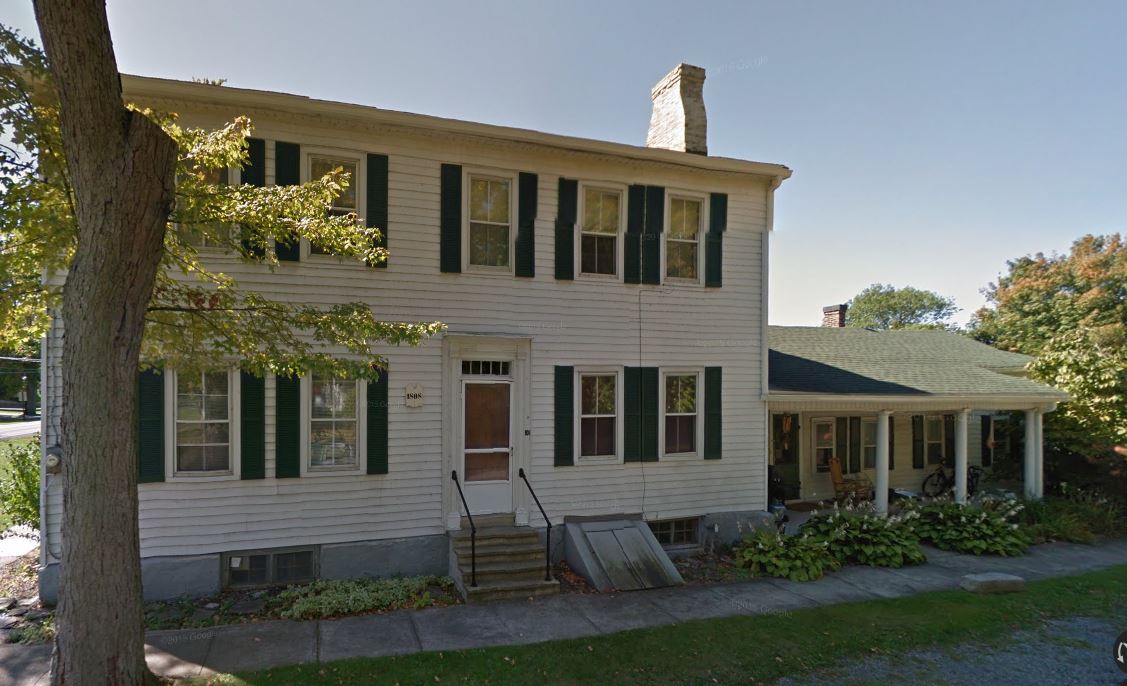
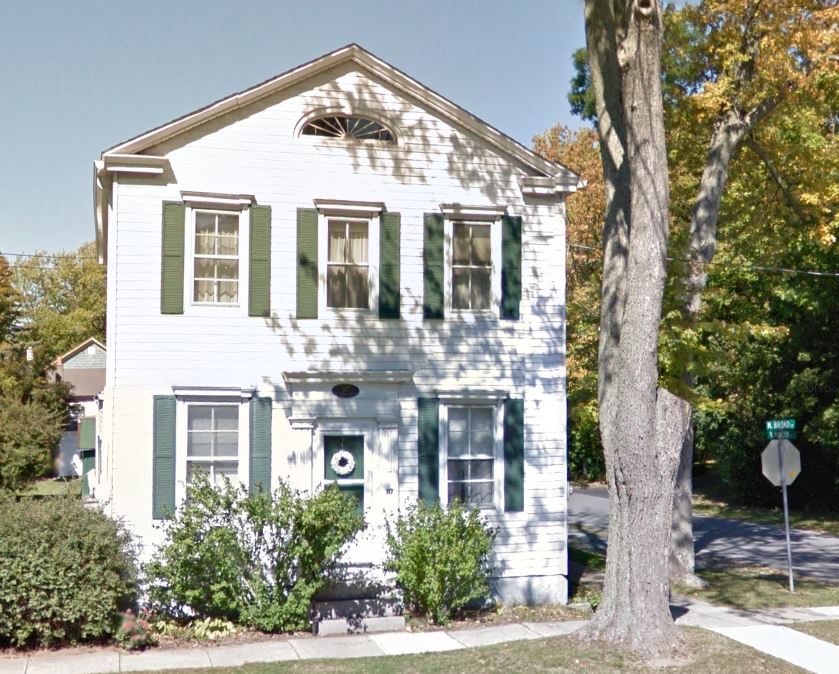
Upon a corner of Broad Street and Hamilton Street, the latter of which runs past the Elisha Camp property to the cove at Sackets Harbor, stands one of the oldest houses in that old military village. It is most attractive architecturally and it may have been built during or prior to the War of 1812. For the past quarter century it has been owned by Charles W Stoddard, a retired Army man, and his wife, Mrs Gladys E Stoddard, who have it filled with a fine collection of antiques.
The entire construction of the house, which is of Georgian style, evidences
its antiquity. The woodwork both exterior and interior is nicely crafted
and there are two fine old original fireplaces in it.
When Augustus Sacket, the New York lawyer who founded the village of Sackets
Harbor, conveyed the unsold lands in the village to a group of New York
land speculators March 5 1809 Thomas Ludlow Ogden of New York became
their trustee.
On August 20 1816 Colonel Elisha Camp as agent for such trustee, contracted to sell this property to Amos Roberts of Stamford, CT Roberts immediately assigned the contract to David Roberts, who assigned it back to Amos Roberts and on March 21 1818 the place was deeded by Ogden to Amos Roberts for $638.79. The deed shows lot frontage of 50 feet on Broad Street and mentions that it borders on Elisha Camp's two acre lot and the old parade ground. It also shows that excepted from it was a strip occupied by a new street cut through to the bay. A little later deed calls this street Reception Street and still later deeds and maps refer to it as Hamilton Street.
On June 8 1818 less than three months later he gained title to it Amos Roberts transferred the property to his son, Amos S Roberts for $680. On the same day Amos S Roberts conveyed to James H Cutler and Elisha H Gardner, who sold it the following October 3 to John P Rice. Rice disposed of it July 23 1819 to Asahel Smith, prominent early Sackets Harbor resident, who retained ownership for many years.
When Sackets Harbor chapter, No. 68 R A M, was organized February 8 1820 with Commodore M T Woolsey as high priest, Asahel Smith was captain of the host, and when the Methodist Episcopal church society of Sackets Harbor was formed May 9 1831. Mr Smith was one of the first trustees.
On June 27 1859 Asahel Smith deeded the place to his son, Albertus Smith, for $2,000. The latter and his wife, Ann G Smith, later mortgaged the property to Norman Gurney and to satisfy that mortgage Attorney Gary M Jones as referee sold it to Alexander Stone at public auction in the law offices of Rogers Atwell, city January 4 1896.
Son of Horatio Stone and Sophia McKee Stone, Alexander Stone was born on a Rodman farm June 14 1832 and during a considerable period of his mature years was engaged in the hotel and restaurant business. His first wife was Lucy D Kent of Providence, RI, by whom he had five children. His second wife was Fannie A, daughter of Samuel E Thompson, and on January 11 1896 Alexander Stone deeded this house and lot to his wife, Fannie A Stone.
The heirs of Mrs Fannie A Stone conveyed to Charles A Thompson of Reno, Nevada, July 12 1917 and on the following November 17 he and his wife, Mabel A Thompson, Reno, sold to Arthur P Hooley and October 9 1924 it was acquired by Mr and Mrs Stoddard, who relate that one of the Smiths was a cabinetmaker and used the basement of the house for his shop. In addition to manufacturing furniture he also built caskets for funerals. Undoubtedly the old house has an interesting early history, now lost to the world, and it may have even played a dramatic role in the War of 1812.
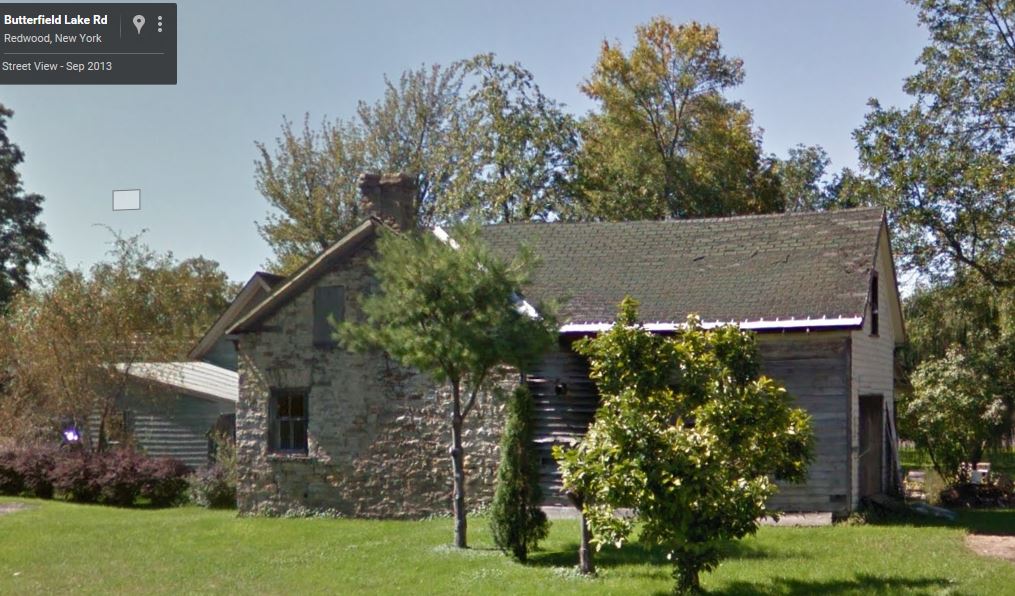
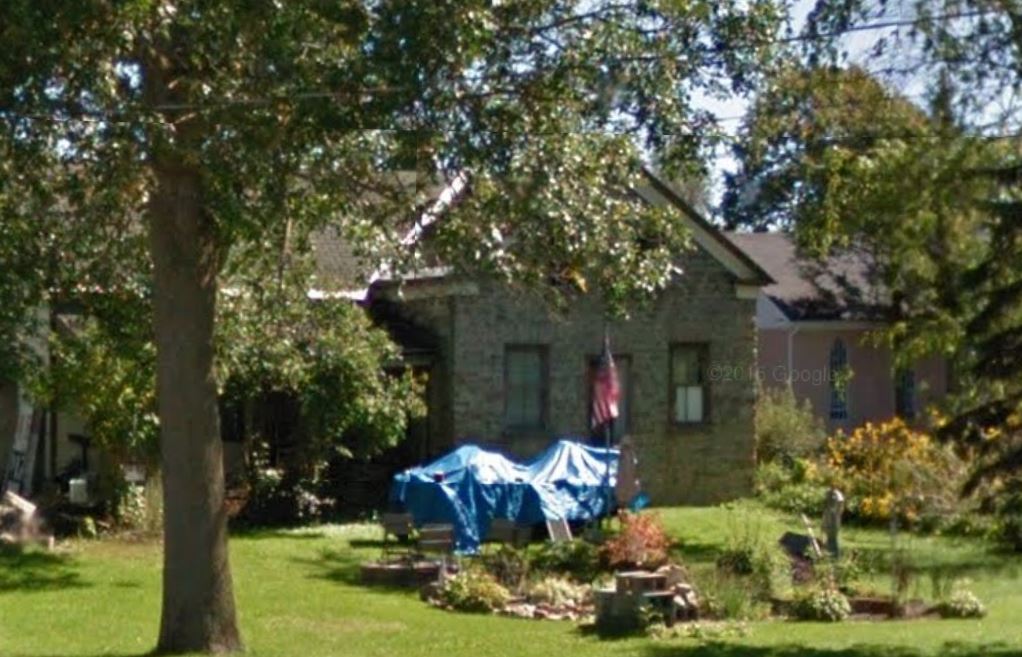
Probably completed in 1851 this modest house with the native sandstone upright and the frame wing has an intimate connection with the colorful history of Redwood glass, which is now so highly prized by collectors. Upon the village of Redwood's Main Street close to its junction with Church Street stands this quaint dwelling upon the same side of the road and barely a stone's throw from the glass works founded in 1833 by John S Foster.
A choice quality of sand in ample deposit and good water power had brought
Foster there in April 1833. Impressed, he bought 10,000 acres of Francis
Depau's land and built his glass factory. The first blow of glass was
made on September 30 1833 and a thriving community began to develop. Thomas
Clark, who surveyed that area, had planned to name it Jamesville, but
Foster, who had been identified with a glass works at Redford, Clinton
county, wanted a trade name of competing similarity and so named the settlement
Redwood. On January 2 1834 three months after the first Redwood glass
was made, Foster died. The property reverted to Depau. Boston banking
interests had a big stake in the plant and sent Joseph Butterfield, a
native of Tyngsboro, Massachusetts, and Henry S White on after a time, there having
been a succession of different operators. Butterfield's services were
recognized by a gift of 50,000 acres of Depau land near Fine.
Depau's executors sold Butterfield the site for this house on October 26 1850 for $65.30. Construction of the house was probably finished the next
year. Butterfield died November 5 1854 leaving his property in equal shares
to his widow, Laura Theresa Butterfield and eight-year old son, Francis
Josiah. In due time Mrs Butterfield married William W Butterfield, son
of Francis and grandson of Levi Butterfield, New Hampshire natives and
Revolutionary descendants, but no relatives of Joseph Butterfield. William
W Butterfield, Alexandria supervisor in 1859 and 1861 and assemblyman
1868-1869 became president of the Redwood Glass Manufacturing company
in 1859. With $50,000 realized from the 50,000 acres of land transferred
to him by his wife he became sole owner of the glass company, operating
it successfully from 1863 to 1874 when he leased it to others.
On December 20 1867 his wife, Laura T Butterfield, deeded her half interest in this old house to her son, Francis Josiah or Josiah Francis Butterfield. With it went the ashery lot and the old sawmill lot of Joseph. On December 1st 1868 Josiah Francis conveyed these three properties to his stepfather, William W. On December 25 1886 the latter, who had established his mother-in-law, Mrs Chlorinda Stevens, wife of Osmond Stevens, in the house, transferred it to his sister, Mrs Henry (Caroline) Hoffman. In August 1894 her heirs sold the old house to Dr James E Ryan and on September 15 1902 Dr Ryan disposed of it to John Dollinger.
John Dollinger, well known Dollinger hotel proprietor, game protector, guide and boat-builder, resided there until his death in 1930. The house then passed to his widow, Mrs Minnie E Dollinger, who died ten years later. From her it went to her children, of whom there were four daughters and a son and August 24 1944 became the sole property of her son, Ralph E Dollinger, the present occupant. His sisters are Mrs Anna D Baldwin, Mrs Dorothy Vale, Mrs Ethel Forsythe and Miss Mary Dollinger.
But the Butterfield interest was extinguished long ago and Mrs Laura T Butterfield died August 11 1904. Her husband, William W Butterfield, died September 22 1909. Their daughter was Mrs Cyrus Watson (Laura B) Simons, many years deceased, mother of Miss Laura C Simons and Mrs Eli G (Ethelwyn) Herrick, city, and William W Simons, Rockville Centre, Long Island.
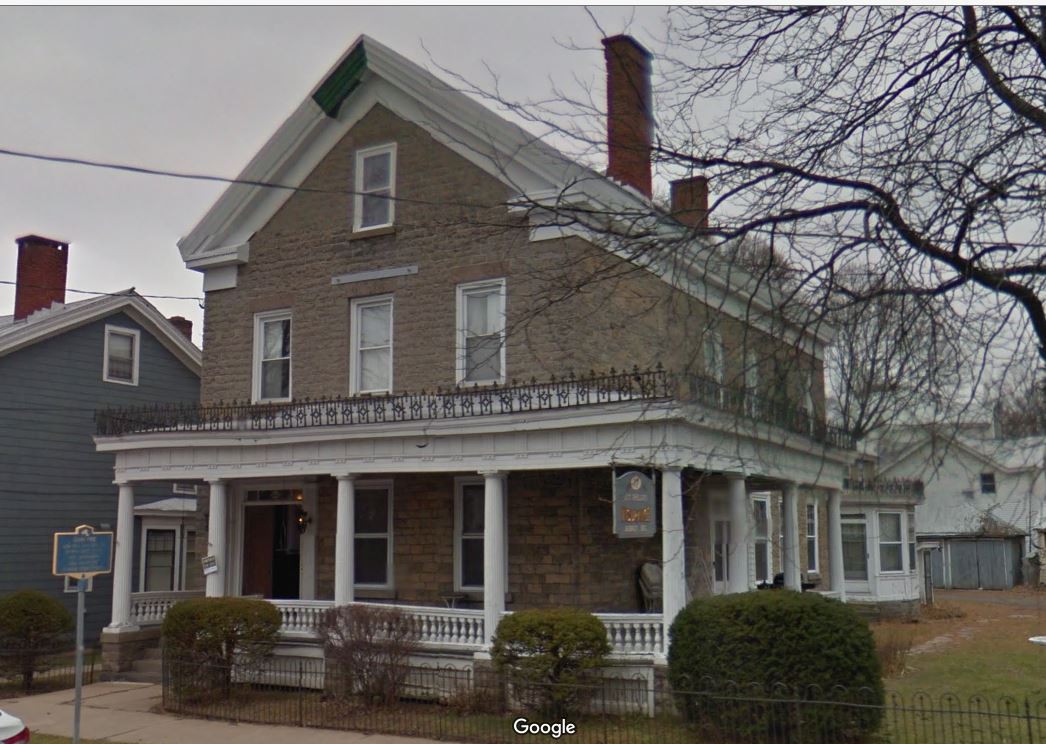
Highly modernized as it is this large native limestone house at 422 State Street, Ogdensburg, is over a century and a quarter old, it is likely. It seems probable that it was built by Palmer Cleveland, who was one of that community's early prominent residents, having served as a village trustee under President Louis Hasbrouck in 1818 and as village president the following year.
However, its ownership for 118 years was held by only two families, the
Fines and the Bentons and for the past eleven years by the Frasers. State
Street, upon which it stands opposite the postoffice, was originally known
as Euphemia Street having been so named for one of the six daughters of
Judge Nathan Ford, agent in the development of Ogdensburg for Landowner
Ogden.
Native of New York City, where he was born August 26 1794 Judge John
Fine was one of St. Lawrence county's most distinguished men, having settled
there in 1815 at the end of the War of 1812. In 1809 he was graduated
from Columbia college and began law study, attending lectures at Litchfield,
CT. At Ogdensburg he formed a law partnership with Louis Hasbrouck. Columbia
had conferred upon him an AM degree in 1812 and Hamilton had accorded
him an LLD From 1821 to 1833 he was St. Lawrence county treasurer.
From 1824 to 1825 from 1829 to 1838 and from 1843 to 1847 he was first-judge of the county. In 1838 he was elected to congress and in 1848 was chosen state senator. In 1847 and 1849 he was defeated for the supreme court. Owner of extensive timberlands and promoter of its first settlement, the town of Fine formed March 27 1849 was named for him.
Judge Fine mortgaged this property to William H Averell and lost it
to Elizabeth F Strong by foreclosure June 7 1864. She immediately conveyed
a two-sevenths interest to Jane G Fine and together they sold the place
to Dr John H Benton for $7,000 on December 22 1865. Judge Fine had died
January 4 1865 and he had acquired the first parcel of this site, or Lot
4 from Palmer Cleveland for $3,000 on February 1 1821. Cleveland had bought
it from Joseph Deming May 18 1810 for $400 and on November 1 1809 Deming
had purchased it from David B Ogden for $100
Parts of adjoining Lots 6 and 7 were bought by Palmer Cleveland from David Parish on August 6 1818 for $128 and sold by Cleveland to Wesson Briggs for $1,600. Briggs sold them to Judge Fine March 4 1823 for $1,300 and he added them to the site of his house. Such in the record of the property down to the tune that Dr John H Benton purchased it on December 22 1865.
Dr Benton, native of Oxbow, was of the lineage of Dr Abner Benton, Oxbow's first physician In 1818 and first postmaster in 1819. Dr John H Benton was thus tied in with Colonel Zebulon Howell Benton, North Country industrialist promoter, famed as the husband of Charlotte Caroline Bonaparte, niece of the great Napoleon and daughter of Joseph Bonaparte, king of Spain.
Dr John H Benton died August 31 1885 leaving Dr Charles Carroll Benton a life-use of his property, which was eventually to go to the latter's son, Dr John West Benton, who was born in Oxbow November 15 1864 was graduated from University of Pennsylvania medical college in 1886 and was married in London January 3 1903 to Harriet Egert, daughter of Charles G Egert, founder C G Egert & Company's bank. Dr John West Benton's mother was the former Sarah West.
One of the North Country's prominent physicians, Dr John West Benton, nephew of Colonel Zebulon H Benton, died January 23 1932 leaving a widow and five sons. The widow, Mrs Harriet Egert Benton, sold the house November 15 1939 to Jack Sherwell and Ada Butterworth Fraser who had operated it for some time prior thereto as a tourist house. Mr Fraser at 52 and native of Ogdensburg died in September, 1946. Mrs Fraser, whom he married February 23 1918 continues to own and occupy the house. Mrs Harriet Egert Benton, 65 died July 18 1945.
(is this a duplicate of Article 30?)
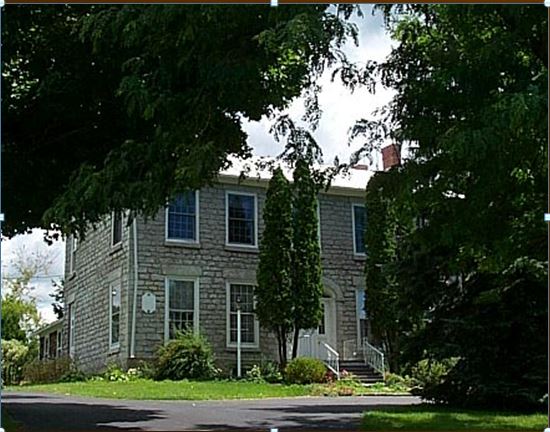
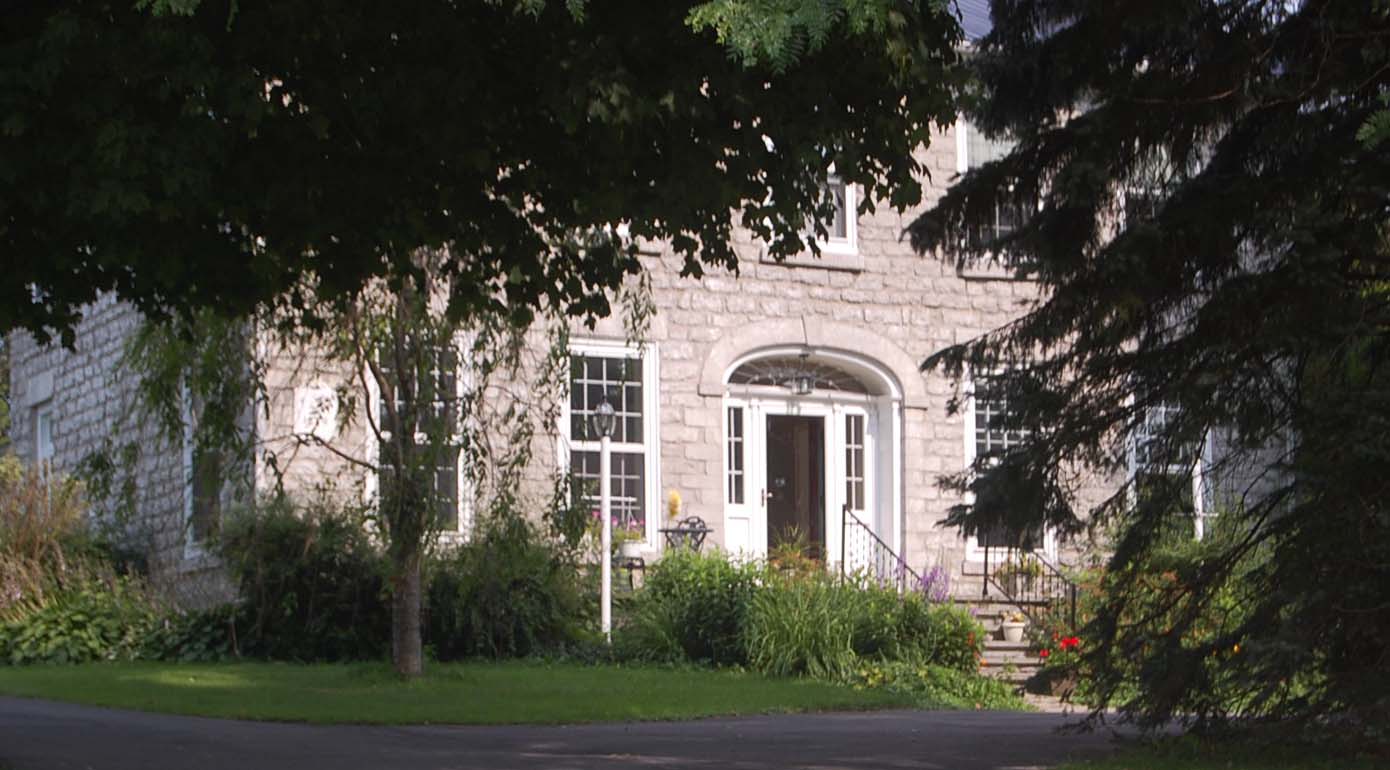
There is an air of Georgian dignity to this house of native limestone as it stands atop Dry Hill, framed by two ancient sugar maples, and haughtily gazes across the broad broad plain which ends with a shimmer of Lake Ontario along the western horizon.
Said to have been built in 1828 its original owner was John Losee, who came to this area from the Mohawk valley in 1801 and settled in that part of the town of Watertown where this house is. In fact, the hill is also known as the Losee hill.
John Losee is almost a legendary figure today, although he must have been a man of substance in his time, for his house is a large and pretentious one of eight large, 9 ft high rooms downstairs and ten-foot ones upstairs. Spacious halls from front to back evenly divide both floors and originally there was a fireplace in each of the eight rooms, although but one remains today.
For 78 years this house and its large farm remained within the ownership of the Losee family, of which there are descendants in the county at this time, and always in the transfer of the property there was reserved to the family, the 36-foot family cemetery where John Losee was buried across the road from the house and near the present location of the barns.
To satisfy a mortgage the late Attorney William W Kelley as referee sold the place at public auction to Sheriff John H Bogart, Theresa, and brother, Druggist James C Bogart, city, March 7 1906. Then on December 18 1912 James C Bogart conveyed his interest to John H Bogart who, with his wife, Rozella joining, deeded it to his son in law and daughter, Harry Y and Bertha B Stone on August 24 1918.
Prominent Jefferson County dairyman, Mr Stone, who died September 8 1947 at the age of 65 became not only supervisor of his township but for two terms was chairman of the county board. Five years before his death Supervisor and Mrs Stone turned the farm over to their son, John H Stone, who, with his sons, now operates it and the milk business associated with it. Mrs Harry Y Stone now resides in this city.
Before his death Mr Stone embarked upon a project looking towards the restoration of the house to its original appearance. A large verandah of modern type, which had at some time been added to the house, hiding a beautiful doorway, was removed. The concrete platform however, still remains, but Mr and Mrs John H Stone have in mind to go further with the restoration project, replacing this concrete platform with cut-stone steps and ornamental ironwork. Possibly also the type of original, small-paned windows will take the place of the large modern ones, and in addition they are considering a bit of landscaping of the grounds to make the property one of the most attractive ones in the north country.
As for its location, there is no house in the north that occupies a more commanding spot. High above the magnificent Black River valley there sweeps out from the old Losee mansion's front door one of the most beautiful vistas imaginable, and Mr and Mrs Stone regard the property with pride.
Mrs Stone is the former Miss Eunice Irene Ball, daughter of Mrs Laurentine Ball and the late Burt B Ball of this city. She is a graduate of the Rochester Institute of Technology and was married to Mr Stone in this city November 18 19I54. Mr Stone is a graduate of the local schools and the state agricultural school at Cornell. Mr and Mrs Stone have two sons, David and Jay, who are associated with them.
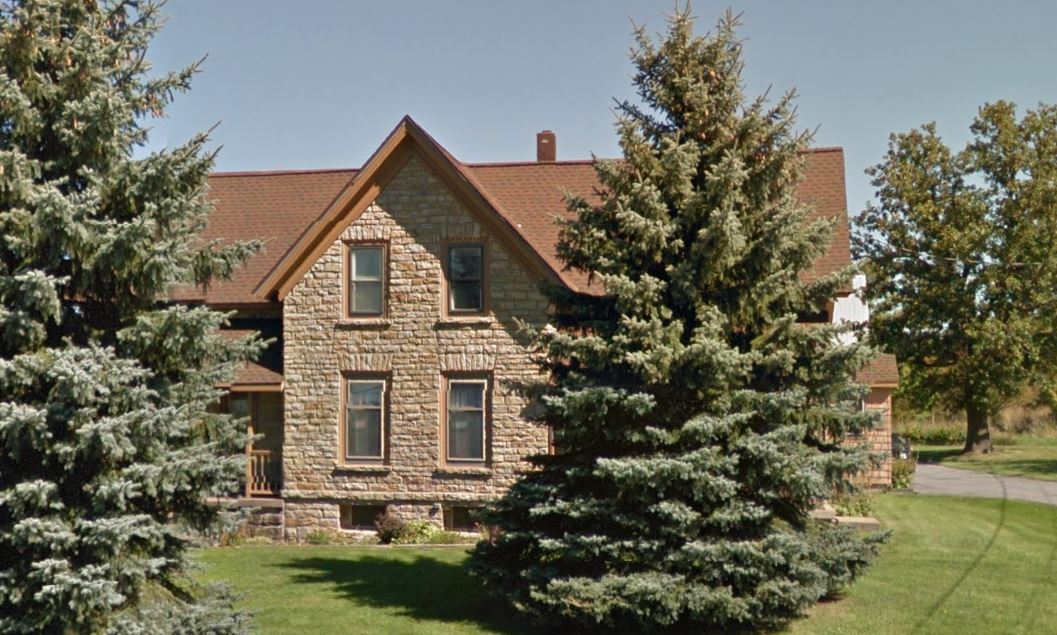
Almost a century old is this house of native stone, which is located not far outside of the village of Alexandria Bay on the road to Redwood. It is the residence of Mr and Mrs Richard W Felder, Mr Felder, supervisor of the town of Alexandria, being engaged in the motor freight business between that village and Redwood.
Since December 4 1918 the house and farm which goes with it have been owned
by Fred VanBrocklin and his wife, the former Miss Sarah Jarvis of Wellesley
island, Mr VanBrocklin, now retired, being an uncle of Mrs Felder and
son of Morgan VanBrocklin who, as a young man, worked upon the construction
of this house.
The house, which now shows signs of some modernization of its original architecture, was constructed about 1853-4 the land upon which it stands having been purchased on April 22 1853 by Jesse Davis from Theodosius O Fowler and Mortimer Livingston, of New York City, executors of the estate of Francis Depau, the New York City merchant who owned a large acreage of Jefferson County land in the town of Clayton and St. Lawrence river areA
The Jesse Davis purchase consisted of two parcels, upon one of which, 79.35 acres, he caused this house to be built, and three years later, Jesse Davis and his wife, Hannah, conveyed the property to his son, Delos Davis of the town of Alexandria also. Mrs Susan M Davis joined with her husband, Delos Davis on April 3 1889 in transferring the house and farm to their son, Hiram P Davis. Hiram Davis kept the place until December 4 1918 when he and his wife, Addie E Davis sold it to Mr and Mrs VanBrocklin, the present owners.
Mr Davis, who was born across the St. Lawrence river from Alexandria Bay in the village of Rockport, Ontario, February 24 1863 removed as a child with his parents to the Bay. There he received his education and there he returned to reside after he had conducted this farm for some years.
Upon taking up his residence in Alexandria Bay he engaged in the meat business. About 1913 he removed to this city and engaged in the grocery and meat business on State Street near William Street. From that he retired on October 1 1917 to take up the real estate business and the same year announced his candidacy for the Republican nomination of sheriff having served as a deputy for four years during the administrations of Sheriffs John H Bogart and Morris S Gragg. Mr Davis died January 19 1921 about two years after he had disposed of this farm to Mr VanBrocklin.
Mr and Mrs VanBrocklin, now 77 have long resided in Alexandria Bay and for 45 years Mr VanBrocklin served as caretaker of Craigside, summer home of Henry A Laughlin. Mr VanBrocklin was born December 30 1872 son of Morgan and Delia Mallett VanBrocklin of the town of Antwerp. His wife, the former Miss Sarah Jarvis, daughter of John and Sarah Jarvis, was born May 20 1873.
Mr VanBrocklin is a brother of the late George VanBrocklin who died
June 22 1940 and who was the father of Mrs Felder. George VanBrocklin
was also a resident of Alexandria Bay. He was born April 15 1882 and
engaged in farming the greater part of his life. His wife was the former
Miss Margaret Jarvis, who was a daughter of George and Catherine Jarvis.
Mrs VanBrocklin died September 17 1944.
Supervisor Felder, who served as electrician's male third class in the navy in the Pacific theater during the last war, is the son of Joseph and Margaret DeYoung Felder Jr, long residents of the Redwood-Plessis area, Joseph Felder Jr, also having served some time as justice of the peace and having been elected president of the Jefferson County Association of Justices. Supervisor Felder, his wife, the former Kathleen VanBrocklin and children enjoy the old stone house, which is their home.
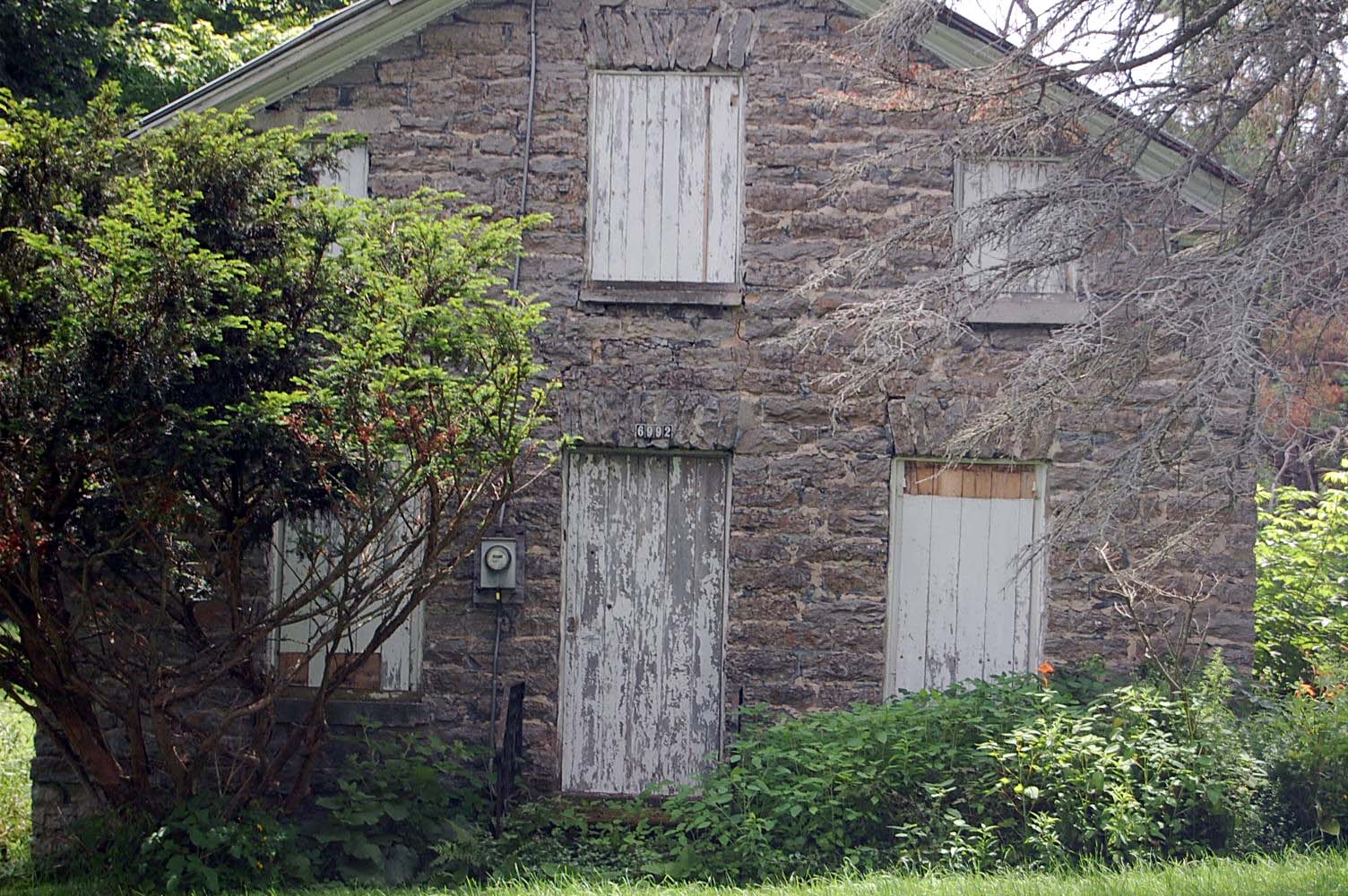
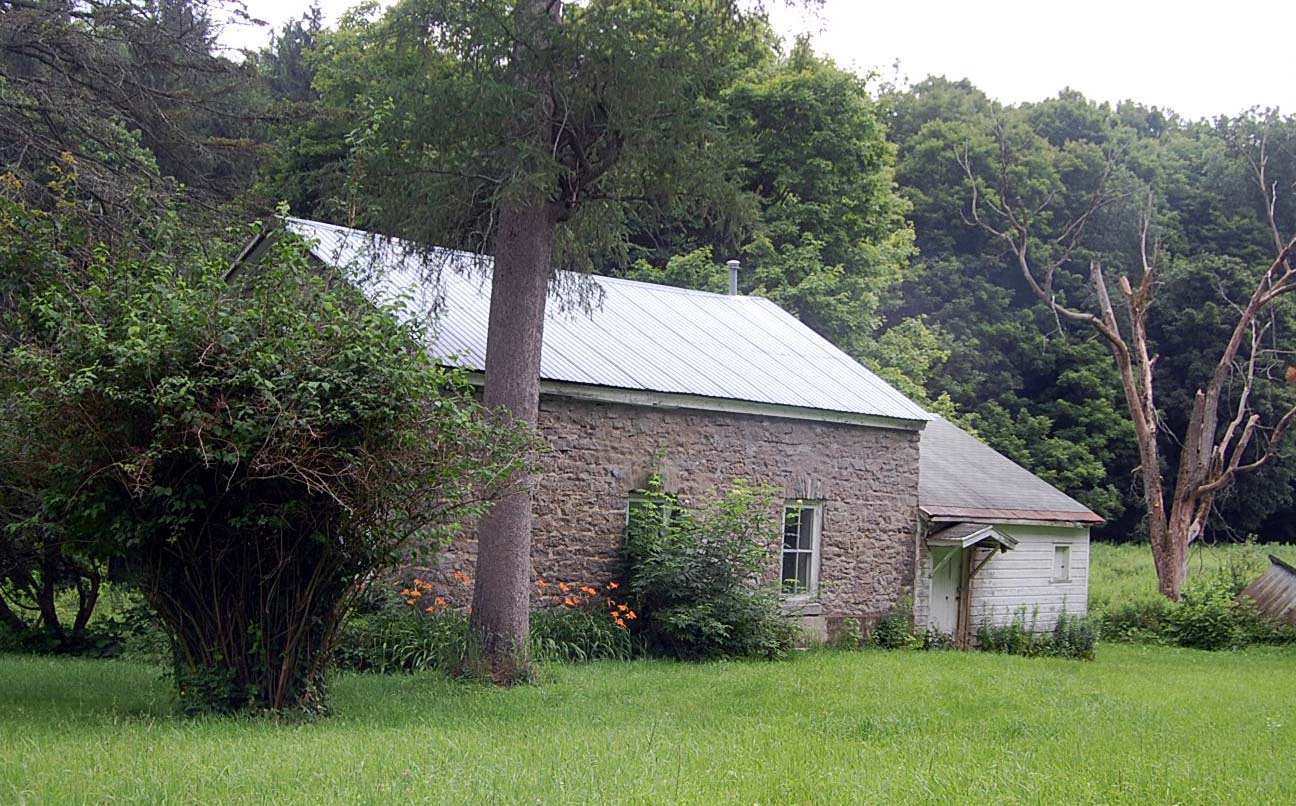
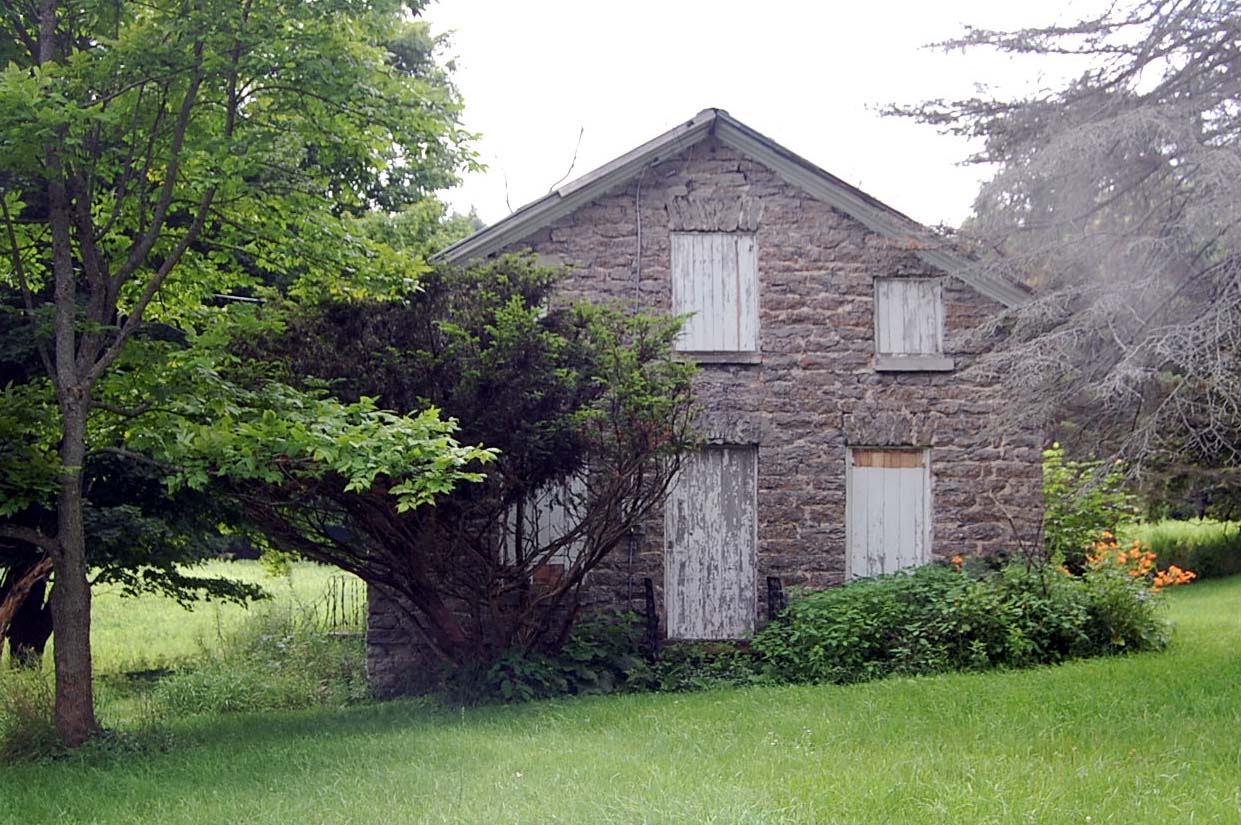
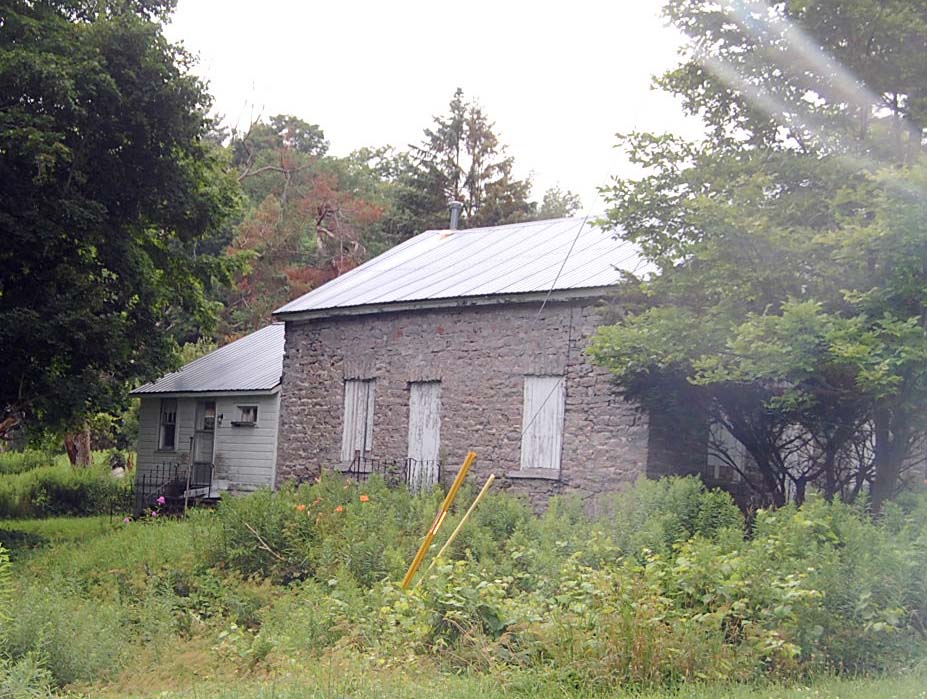
Along the peaceful, secluded Sandy Creek Valley road back of Dry Hill is this little native limestone house, which was constructed about 112 years ago. It would seem to have been built by William Tolman, a prominent early settler of the town of Watertown, for a record dated February 22 1838 in the county clerk's office states that the 77.10 acre tract, upon which the house stands, was purchased by him on that day for $450 from Cornelius and Nicholas Low, New York City, heavy speculators in northern New York lands.
In his will, however, recorded October 4 1892 wherein William Tolman devised his home farm featuring this 77.10-acre parcel to his son, William Orville Tolman, he declares that he bought the 77.10-acre parcel from Gardner White. But there is no record in the county clerk's office to support this statement, and so the presumption is that the house was not originally the home of White, but of Tolman himself.
Born in Nelson, New Hampshire, November 7 1795 William Tolman was nearly 97 when he died August 3 1892. He was descended from Thomas Tolman, who had come from England in 1635-6 to settle in Dorchester, Massachusetts, and was the son of Ebenezer and Mary Clarke Tolman. Ebenezer marched under Colonel Benedict Arnold against Quebec in 1775 and fought at Bunker Hill.
With his brother, Ebenezer Tolman Jr, who was eleven years older, William Tolman came to Jefferson County in 1817. For a few years he worked upon farms and from James D LeRay de Chaumont on February 13 1822 he purchased his first parcel of northern New York land, a 100-acre plot in what is now the town of Theresa.
Shortly he went to Pawtucket, RI, but in a few years returned to his native town and on October 9 1827 married Mary, daughter of Timothy and Abigail Bancroft. He brought his bride to Jefferson County at that time, but she did not like the Theresa farm and the upshot was his purchase of the 77.10 acre Sandy Creek Valley farm, to which he added other acreage as the years went on.
His son, William Orville Tolman, to whom he willed this home farm, was
born October 1 1837 in the town of Watertown. He attended the Jefferson
County Institute and on November 12 1863 was married to Mary Ophelia Bailey,
daughter of Lyman and Susan Bull Bailey. Two daughters were born to them,
Mary Louise who married Fred D Simmons and Susie Luella who married Albert
L Spink.
William Orville Tolman was a charter member, first secretary, later overseer and then master of Watertown Grange No. 7. Later he was master of the county Pomona and for several years was justice of the peace. He died December 25 1917 willing this farm, which then consisted of 140.69 acres to his daughter, Mrs Fred D (Mary Louise) Simmons.
Mrs Simmons, born September 5 1864 was educated in the town, and married Fred D Simmons October 8 1890. She died February 13 1944 willing her husband a life-use of this farm, and after his death a life-use to her daughter, Mrs Lee C (Ethel O.) Fralick. She provided that after Mrs Fralick's death the place should go to the latter's sons, Neil O, Perry L, and Glenn F.
Fred D Simmons died January 16 1949 aged 83 and now Mrs Fralick has a life use of the farm, which has grown to more than 300 acres. For picturesque location as well as good soil and for an environment of contentment it is one of the most ideally located in the county, being near the city of Watertown yet well off the beaten path. No stream of noisy traffic thunders by its door and beautiful old trees and colorful, old-fashioned flowers in summertime, lend a pleasant item to its outlook.
A few miles above Pamelia Four Corners on the old Military highway the old Jacob Baum farmhouse is located. It was probably built about 1836-7 for on June 18 1836. Moss Kent, who had early in the last century been a land agent for James D LeRay de Chaumont, but was then a resident of Plattsburgh, sold the nucleus of this farm to Jacob Baum for $546.50.
Jacob Baum became a prosperous town of LeRay farmer and died in 1854 leaving his wife Barbara and several children. He willed this farm to his son, Ephraim J Baum, but gave his widow all of his household goods and a life-use of one third of the farm.
On April 1 1856 Ephraim J Baum and wife, Elizabeth, sold the farm to Ephraim's brother Henry. Mrs Barbara Baum at the same time quitclaimed her interest in the property to the latter, who kept the place until March 1 1866 when his wife, Catharine, joined with him in selling it to Jacob Fikes, another early settler in that area. Fikes remained there until March 8 1880 when he and his wife Margaret sold to George Petrie, also a resident of the town of LeRay.
At the end of three days George and Mary Petrie disposed of this property to William and John Baum. Ten years later John Baum sold his half interest to William, John's wife, Jane, joining him in the transaction. William Baum, whose father was Absalom Baum, was a grandson of Jacob Baum, the original owner. After 20 years' of ownership of the farm William Baum died January 21 1900 leaving a substantial estate for his widow, Emma and 14-year-old son, Howard W Baum.
William Baum, whose mother was the former Anna Keller, was born January 26 1841 in the town of LeRay, and there he always resided. On December 6 1916 Howard W Baum transferred his interest in the property to his mother. She retained it until her death August 17 1932 when it passed back to her son, then a resident of Kearny, NJ, and on the following November 19 Howard W Baum and wife, Dora, sold the farm to Mrs Grace E Bulson, Theresa, and her husband, the late County Sealer Charles H Bulson.
Following an ownership of nearly 18 years Mrs Bulson sold to Ralph J and Harriett L Moulton on the 11th day of this month, the farm now consisting of 208.33 acres, and the old house, which is a fine architectural type constructed of red brick, is in excellent state of preservation.
The brick work is an example of unusually good mason craftsmanship and
the interior of the house remains much as it was when it was first erected
more than 110 years ago.
The little frame addition at the left end of it also displays all of
the phases of having been created over a century ago, and may have been
used as a milk house or as a shop of some sort. The emplacement of it
at the end of the house seems to have been poorly advised, and leads to
the opinion that it was not originally just where it is now, or if it
was that the gable was faced at right angles to its direction today. There
is a possibility also that it stood at the rear of the brick upright or
that it may have been an entirely detached building in the beginning.
Mr and Mrs Moulton, present owners, were married November 24 1938 Mrs Moulton having been the former Miss Harriett E L Longway, daughter of Mr and Mrs George A Longway of East Watertown. She is a graduate of the Brownville-Glen Park High school. Mr Moulton is the son of Mr and Mrs Elmer H Moulton of Rices, was graduated from the Adams Center High school and later was employed by the Dexter Sulphite Pulp & Paper company.
Near the Cheevar Rd
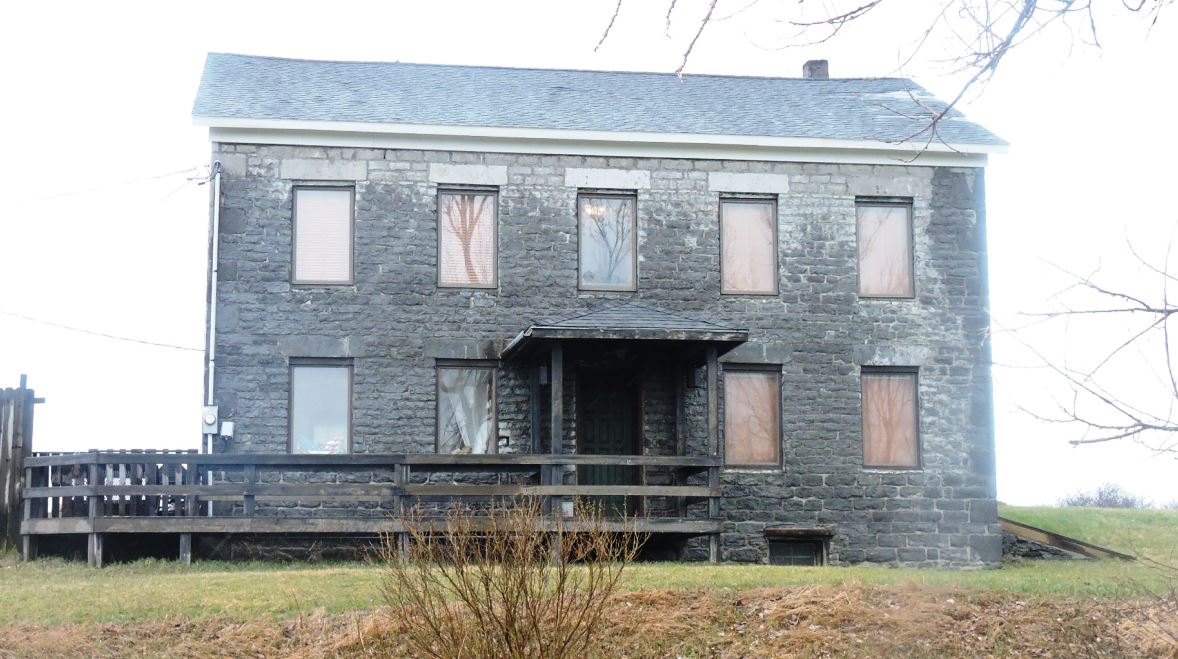
Owned By D C Eddy in 1864
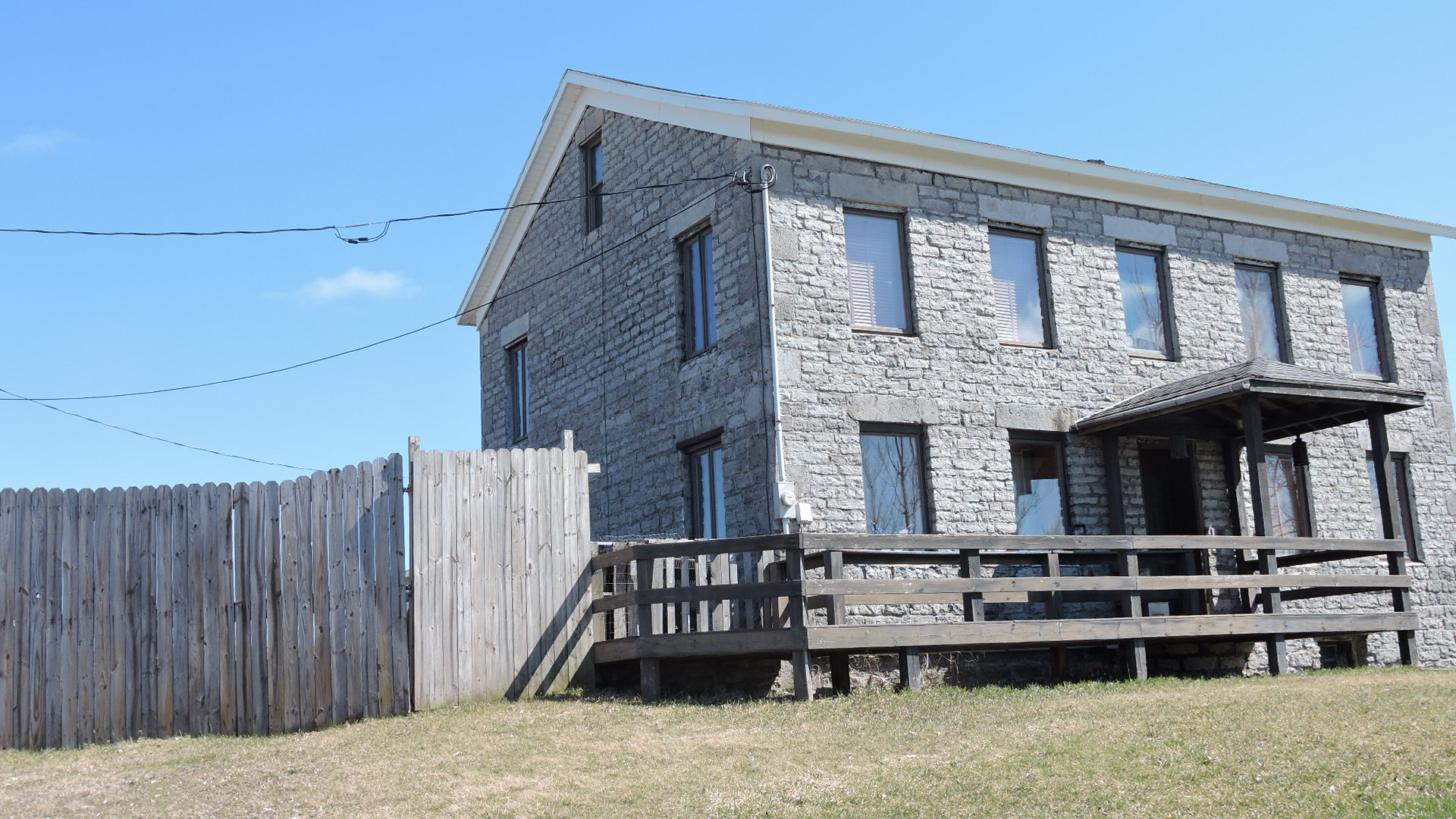
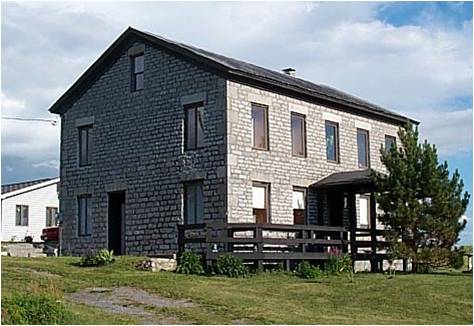
Reputed to have been constructed in 1813 on the Pamelia-LeRay road a few miles from Pamelia Four Corners this record seems to confirm that claim about this old native limestone farmhouse, the original beauty of which has long been destroyed by certain modernizations including an exterior coat of plaster, a metal roof and new windows.
Whether the house was first the home of Thomas Goodrich or Elias Wager is not revealed. Both were early settlers of the present town of Pamelia and when the Pamelia Farmers' Scientific Library was incorporated April 1 1822 Goodrich became one of its original trustees.
According to the record James Donatianus LeRay de Chaumont through Moss
Kent as his attorney sold the 200 acres that constitute this farm to Thomas
Goodrich on June 7 1806 for $700. On July 8 1813 Goodrich sold the same
property to Elias Wager for $1,000 which may indicate that a house had
been built on it or that Wager built the house shortly afterward, for
on April 14 1815 he and his wife, Elizabeth, conveyed it back to Goodrich
for $2,000 and March 31 1817 Goodrich transferred it to Ira Goodrich
for the same amount.
Apparently Thomas retained an interest in it, however, because on September 25 1824 Ira and Sally Goodrich and Thomas and Catherine Goodrich sold the place to Enoch Eddy Jr, of Rutland, for $2,000. Enoch and Huldah Eddy transferred it to James Eddy, Rutland, August 21 1830 for $1,869 and on September 7 1839 James and Cynthia Eddy sold the property to Enoch Eddy Jr, again for $6,000. On February 28 1842 Enoch Eddy Jr, conveyed it to James Eddy of Rutland, for $4,000. Then on January 28 1853 James and Cynthia Eddy disposed of it to William Howland of Rutland.
Eunice P Howland, wife of William, was the daughter of James Eddy, and on December 10 1860 William and Eunice P Howland sold the property to DeWitt Clinton Eddy, who was the son of Enoch D and Huldah Aldrich Eddy, Enoch D Eddy or Enoch Eddy Jr, being the son of Enoch Eddy, who came in 1800 from Rutland, VT to settle in Jefferson County's town of Rutland.
DeWitt Clinton Eddy, who was married about 1853 to Caroline, daughter
of Joel and Melinda Otis, died February 9,1894 leaving all of his property
equally to his widow and daughter, Cora M, wife of Edwin J Colligan. Mrs
Eddy died in this city July 1 1924 at the age of 91 and this old house
and farm then became the sole property of her daughter, Mrs Colligan,
who disposed of it on July 11 1944 to Elmer F, and Elizabeth A Brown,
of the town of LeRay, the present owners. Mr and Mrs Brown have the farm
worked by tenants.
Mrs Colligan died in this city February 8,1946. Her husband, who resided on and operated this farm for many years, was one of the most prominent agriculturists in the county, and in 1913 was elected president of the Jefferson County Agricultural society, of which he had long been a director. He has also been master of the county Pomona grange, was a member of the national Holstein-Friesan society and was a breeder and dealer in thoroughbred Holstein cattle and Shropshire sheep, exhibiting annually at the county fair. He and Mrs Colligan came to this city to reside in 1917 and he died January 6 1947.
The record of this old house shows that it was owned in the Eddy family for 120 years, a record which is equaled by few of the other old properties in the county.
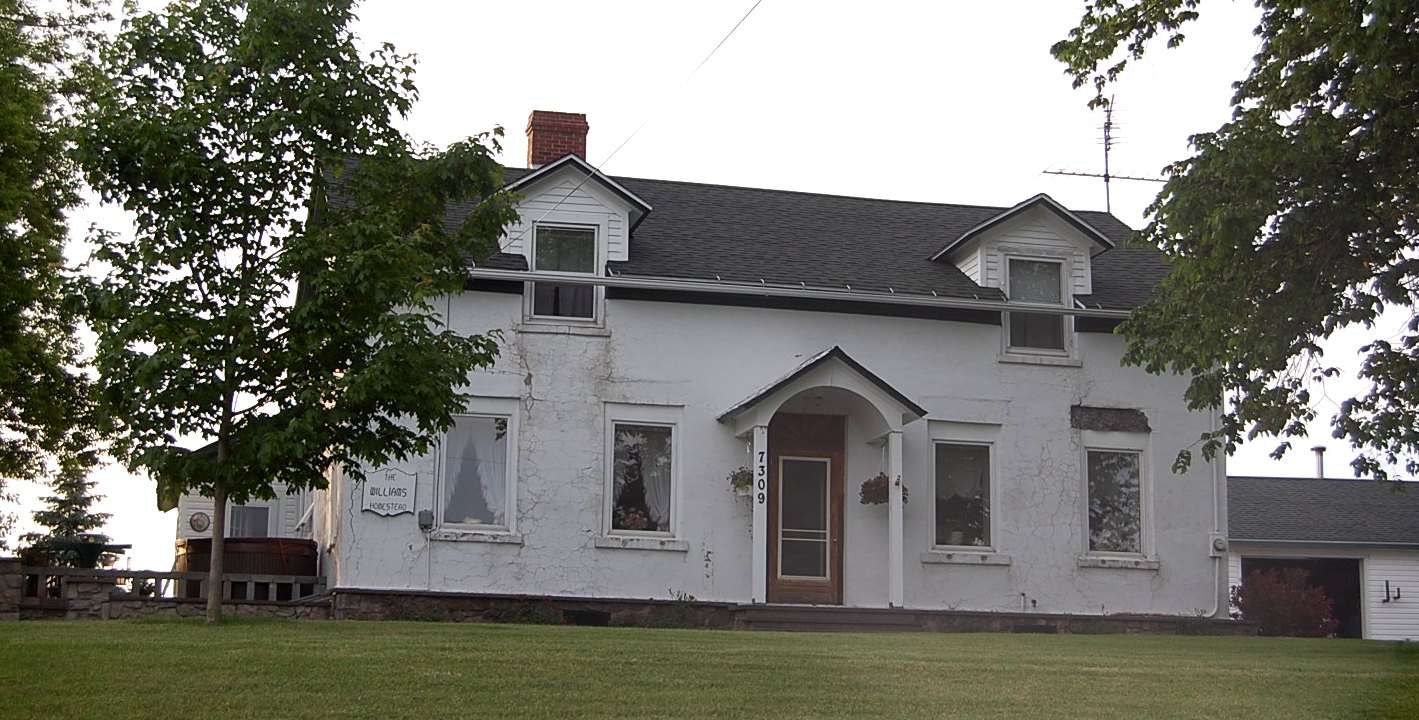
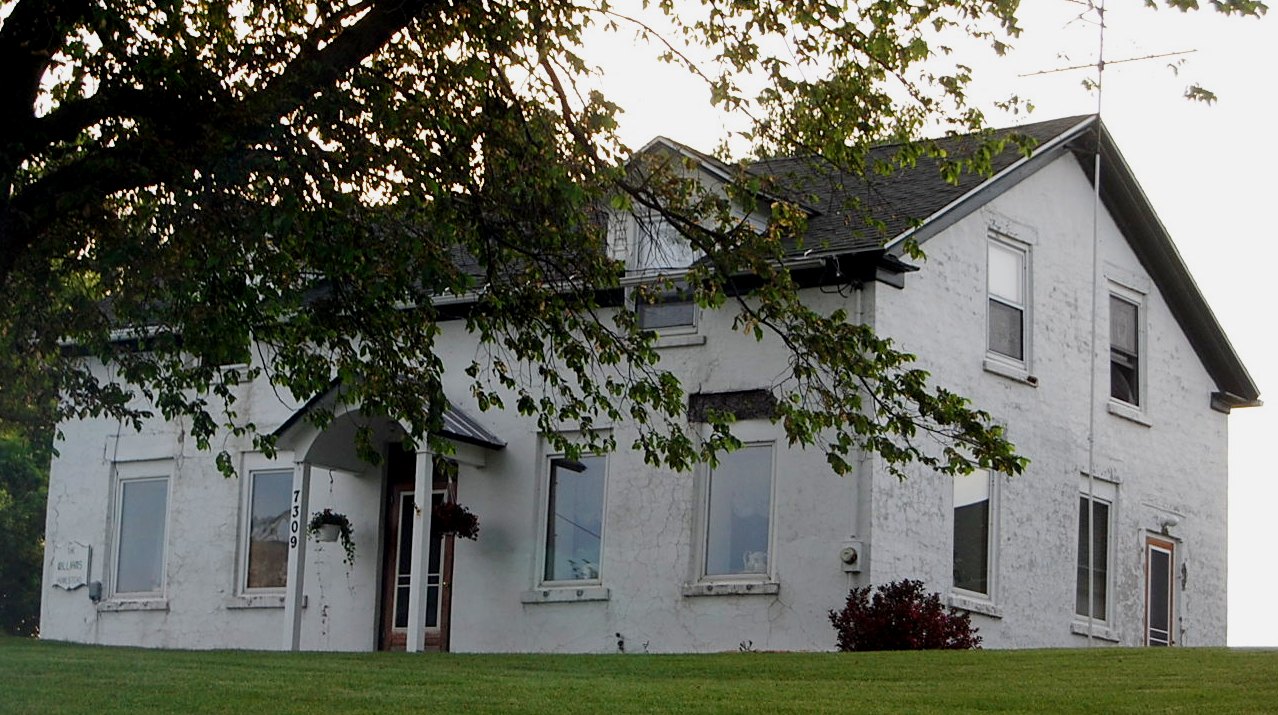
Limestone from the bed of the north branch of Sandy creek below the village of Belleville was used for the construction of this house, and the time was probably in the early 1830s. Within the past few years the structure has been considerably remodeled by the application of an exterior coat of cement which has been painted white.
Inside the house the central hall has been eliminated by the removal of one wall to make a larger living room, the original winding stair has been taken out to be replaced by one of more recent type and the two old fireplaces have also disappeared. Into the house has been installed modern kitchen, heating and lighting equipment.
For the past 30 years the house, outbuildings and approximately 200 acres
of land have been the property of Elliot O McConnell, whose name for some
years has been prominent in most of the north country horse shows for
the quality of his hunters and jumpers. Ridden mainly by his daughter,
Miss Shirley McConnell, accomplished horsewoman who is also a teacher
in the Sydney, NY schools, the McConnell horses have captured enough trophies
and ribbons to fill the room, which has been set aside in the house as
a trophy room. Literally the four walls of the room are ablaze with blue,
some red and some yellow ribbons and there are numerous cups of silver
and gold, plus many trophies wrought in bronze.
If traditions of the Dutcher family are correct, this house, which is not far outside of the village of Belleville on the road leading to Woodville, was built by George Dutcher.
That tradition, however, is not borne out by records in the county clerk's
office. Instead, it may well be inferred that Cornelius Dutcher or, perhaps
Seth Brewster had it built, for on April 8 1833 Brewster and his wife
Abigail, conveyed 165.75 acres of land in the same town subdivision to
Cornelius Dutcher for $2,000.
On March 31 1859 Dutcher sold the tract, upon which this house stands to Chester Wright and George Dutcher for $8,355. Wright, an early Belleville merchant, disposed of his interest in the place to George Dutcher for $5,243 on April 6 1866. In more recent years it came into the possession of Oliver J McConnell, wealthy retired miner, oil prospector and ranchman. After him it was acquired by Charles B and Dorothy M Eastman, owners before Mr and Mrs McConnell took it over some three decades ago.
Elliot O McConnell is the son of Ralph B McConnell, owner of nearly 1,000 acres of the old William Constable Pierrepont farm at Pierrepont Manor. Ralph B McConnell is in turn the son of William McConnell, who died June 10 1934 at the age of 90 and who was a brother of Oliver J McConnell, a picturesque figure who had been active in the western mining country and who died December , 21 1934 at the age of 83.
Ralph B McConnell, who for some time owned the manor house of William Constable Pierrepont, second president of the old Watertown & Rome, railroad, first railroad to come into this north country, sold this manor house a few years ago to Guy Mendel of Albany. It is located on Railroad Street, Pierrepont Manor, diagonally across from Zion Episcopal church, which was built with the financing of Mr Pierrepont and attended by him and his family.
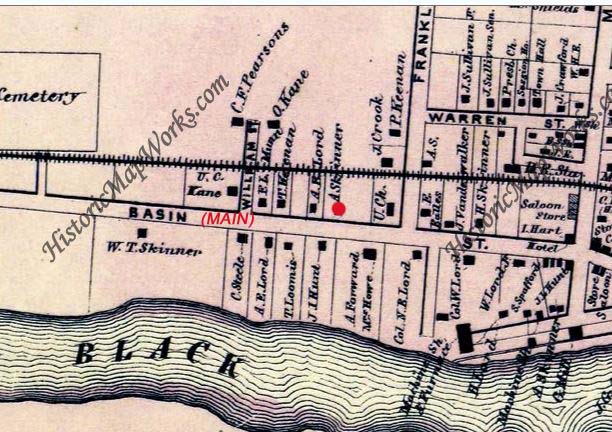
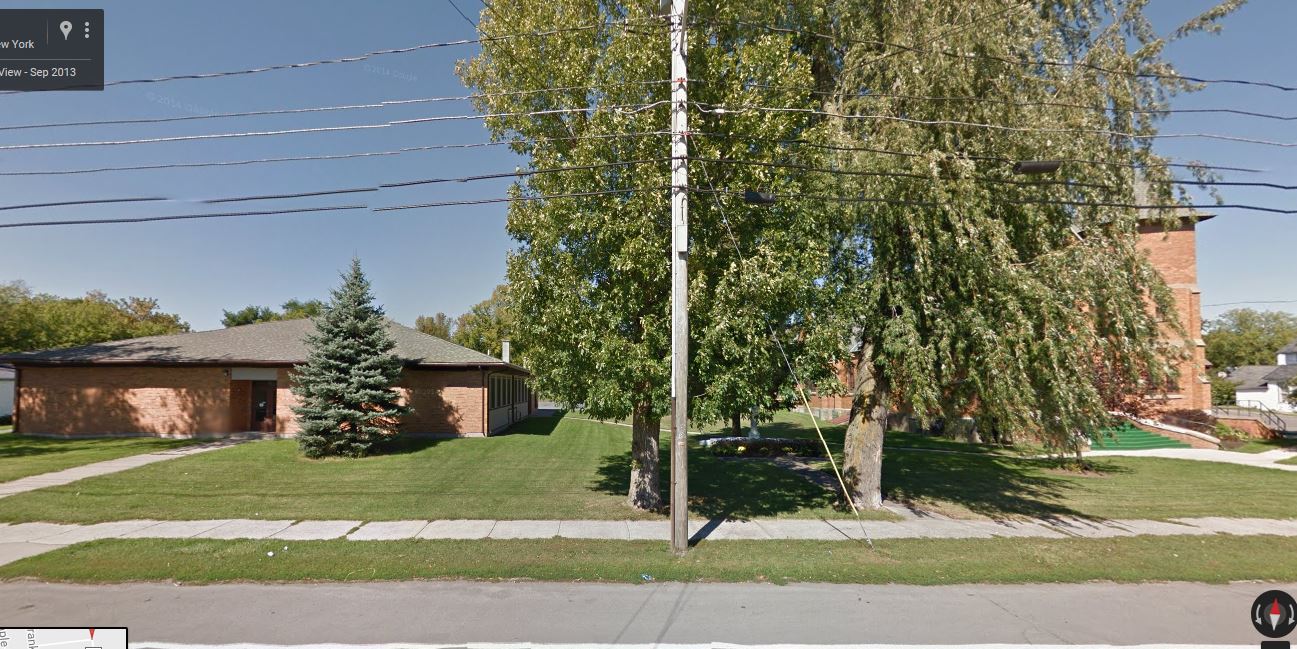
The House Is Now Gone
Born at Westmoreland, New Hampshire, May 21 1794 son of Mr and Mrs Timothy Skinner, Alanson Skinner served under General Jacob Brown in the War of 1812 came to Brownville in 1814 later returned to his home in New Hampshire but came back in 1830 to locate permanently in Brownville and become one of the leading citizens of Jefferson County.
An able machinist and foundryman he at once formed a partnership with Colonel William Lord under the name of Lord & Skinner, and that year was constructed the stone foundry which this firm operated for some time. Later it was conducted by William Lord & Son and by N B Lord & Sons.
Alanson Skinner had been located in Brownville barely a year when, on
May 7 1831 he purchased from John and Cordelia S Towle and Isaac and
Susanna W Towle the one-acre lot at the northwest corner of Basin and
Franklin Streets, upon which he built this brick house for his residence.
Only the preceding June 5 the Towles had bought the same lot from Colonel
William Lord and wife Charlotte for $200.
The house was spacious and equipped with cheerful fireplaces and all of the conveniences of the age. In 1837 Alanson built the foundry, machine shop, furnace and stove factory, which later was run by A Skinner & Son, H Skinner & Brothers and Skinner & Rice. In 1839 1840 1842 1843 and 1846 he was supervisor of the town of Brownville and in 1850-1851 he was state senator for this district. For a number of years he was a director of the National Union bank of this city and 1869-1877 he was its president. He was prominent in the Masonic fraternity and on September 29 1819 was married to Mary Woodward. Their children were Horace, Mary, wife of Reverend Luther Rice, James and William T Skinner.
Later he married again, and when he died June 7 1876 his will disclosed he had made a prenuptial contract September 23 1862 with his prospective wife, Ermina, giving her use of the house and furnishings so long as she elected to reside there.
On March 1 1880 Horace and Harriet E Skinner, Mary S Rice, James and Elizabeth Skinner, Lucy Skinner as executrix of William E Skinner and Ermina Skinner conveyed this brick residence property to Horace W Rice, and October 19 1891 Horace W Rice widower sold it to Mrs Agnes Sullivan of this city. After ten years Mrs Sullivan on July 6 1911 transferred the place to the Church of the Immaculate Conception of Brownville, and it underwent remodeling as a residence for the pastor.
The transfer took place more than a year after Reverend James J McGowan, pastor of that church, came on April 8 1910 to assume charge of that parish. For more than 40 years he has ministered to the people of the parish, a record said not to have been equaled in this diocese. And for 39 years he has been the occupant of this house. The old church next door was destroyed by fire April 1 1917 and the present one of yellow brick arose out of its ashes, during the early years of Reverend Father McGowan's pastorate.
Native of County Sligo, Ireland, where he was born March 17 1879 Reverend Father McGowan came to this country at the age of 15 received his early education in the schools of Fort Covington, got his clerical education in the Seminary of Montreal, served for a time at the cathedral in Montreal, then for nine months as assistant priest at Plattsburgh and from 1905 to 1910 at St. Mary's church in Fort Covington. Reverend Father McGowan was ordained at Montreal December 17 1904. He takes an interested part in the community life, and a deep pride in the parish and this historic old house.
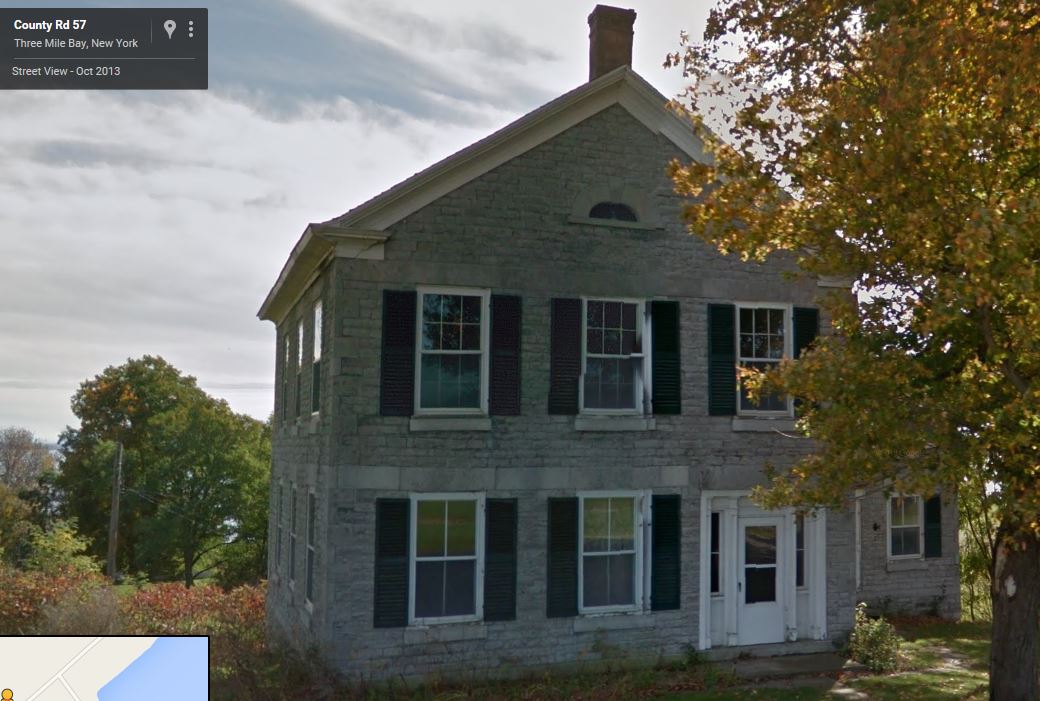
Beautifully located off the beaten trail, near the long carrying place on the road from Three Mile Bay to Point Peninsula, is one of the most attractive native limestone houses in Jefferson County. In the approximately 115 years of its existence its ownership has never been out of the Wilcox family. Proudly kept with its thick, true walls, its beautiful front entrance, its low stone wing and long stone "ell" at the rear, it rambles to overlook the waters of Chaumont Bay.
John T Wilcox, the present owner now 76 years old, is the grandson of
Charles Wilcox, for whom the house is claimed to have been built in 1838
and is a great-grandson of General Sylvanus Wilcox, who fought in the
War of 1812. General Wilcox, born in Connecticut, died in Charleston,
Montgomery county, aged 87 and the children of himself and wife Betsey
were Elijah and Elisha, twins, Calvin, Charles, Oliver, Betsey and Asenath.
Of these Charles came from the town of Oppenheim, Montgomery county in
1834 and on February 28 of that year paid Jesse and Polly Smith of the
town of Henderson $2,000 for the 348.25 acres that originally constituted
this farm, and not long afterward he is understood to have caused this
stone house to have been built.
Only a few miles away, on the shores of Point Peninsula, relatives established the hamlet of Wilcoxville. Still nearer by, at the hamlet of Three Mile Bay, Asa Wilcox was the most prominent shipbuilder of that area from 1835 to 1852.
But Charles Wilcox was spared to live but a comparatively few years in his fine stone house, his death occurring on January 13 1851 when he was but 56. He left no will and his property went to his widow and four children. His widow was the former Julia Ann, daughter of John and Nancy Merrill of Montgomery county, and his children were Sarah E, who married John M VanDerVeer; Nancy U, who married Norval E Douglass; Theodosia T Wilcox and John M Wilcox, the latter of whom eventually acquired the interests of his mother and the other children of this homestead property. His mother died May 12 1882 aged 78.
Born October 12 1833 John M Wilcox was in his 91st year when he died February 5 1924 leaving his widow life use of his property and after her death to their children. The children were John T Wilcox, the present owner; Charles G, George W and Claude V Wilcox. Charles G Wilcox died intestate August 14 1927 leaving a widow, Luella and daughter Mrs Doris W Riley. Mrs Wilcox died December 18 1930 and April 1 1932 John T Wilcox purchased the interests of the other heirs in the place.
On June 22 1874 he was born in this house, second of the four sons of John M and Amanda Grant Wilcox. He was educated in the Three Mile Bay School and the Watertown High school, taught school for three years, spent the three ensuing years sailing the Great Lakes and since that time has operated his farm. In early April, 1936 he was seriously injured by an enraged bull, but recovered from those injuries. Late last November he was awarded a 50-year Masonic grand lodge service medal he having for half a century been a member of Chaumont Lodge, No. 172 F & A M
Proud of his family record, he can point not only to the heroic service of his father in the Civil War, but to the fact that his great-grandfather served throughout the Revolution and was one of the few men who witnessed the execution of Major Andre.
Concerning his father, John M Wilcox. Mr Wilcox relates that he enlisted
in Company M, 10th New York Heavy Artillery, being mustered in a second
lieutenant, fought at Cold Harbor, was at the front in Petersburg and
served with General Phil Sheridan in the Shenandoah valley. He was discharged
a first lieutenant. From 1850 until his death he had missed but two county
fairs and was prominent in the Jefferson County Agricultural society.
The wife of John M Wilcox was the former Miss Amanda Grant, daughter
of William and Christine Mcintosh Grant of Cape Vincent.
For lack of a more positive identification this may as well be called
the Harmon Burnam (or Burnham) house, although it is possible that it
was built for Frederick Woodruff, an early and prominent Water town settler,
and may have been erected for an owner prior to Woodruff.
Constructed of brick, it is one of the oldest, most attractive and finest crafted houses on State Street, and being located close to Cold creek near Hunt Street, which runs off State Street to the Huntingtonville sector, it is likely that the brick which went into its walls were baked in one of the Huntingtonville brickyards.
Clarence B Hartman, ice manufacturer, has been the owner and occupant for the past 39 years, he having acquired it from the late Samuel J and Amy Wilcox Mooney on November 6 1911. Mr Mooney, a Rutland farmer, had purchased it February 4 1908 from Mary Hayes et al when he retired and moved into the city. In their turn Mary Haves et al had bought it from Hannah Hammond October 13 1898.
An earlier owner had been John H Vanderwalker, to whom it had been sold by Marcus and Minerva Reed on November 27 1874 Vanderwalker also having been a Rutland farmer who apparently retired and moved into the city at that time. The Reeds had but shortly before that retired from farming and moved in from Rutland, having bought the property on February 28 1873 from Alfred and Lovina I Gowdy and Josephine L Hadcock, who had purchased it on October 2 1872 from Maranda C Monroe.
It came to Maranda C Monroe by purchase from William and Mary T Thomson on April 30 1866 who transferred with the house and buildings ten of the 85 acres which they had purchased when they moved to Watertown from Houseville.
Mr and Mrs Thomson were the parents of the late Mrs Frank A Hinds and they had bought the 85 acres from Harman and Maria F Burnam for $8,500 on March 1 1859. The Burnams were also retired farmers and they had purchased the 85 acres and buildings on it from Frederick and Lodema Woodruff April 5 1848 for $3,400.
Stone's atlas of 1864 shows the Thomsons owning two houses in that vicinity
at that time, one undoubtedly being this house and the other the house
a little nearer the city which later became the Frank A Hinds residence,
still later the residence of William D Moran, and now of Cosmo D Amedeo.
The Watertown directory of 1860 shows Harmon Burnham residing at 103 State Street, which was probably the Moran house, as later directories designate the present Hartman residence No. 173. When the block system of numbering went into effect in 1908 the number of this brick house became 1833 and still later 1851. This situation would seem to mean that the Burnams may have caused the brick house to be constructed after they acquired the 85-acre tract from Woodruff, and Woodruff, it would appear from old county records, bought this land about 1839.
William Thomson, who disposed of this place April 30 1866 died on the following August 30 leaving an estate estimated about $12,000. Harman Burnam, who had been an earlier owner, did not die, however, until November 6 1884. Samuel J Mooney, after selling this attractive old brick house with its excellent exterior walls and interior woodwork to Mr Hartman, resided at 117 North Pleasant Street until his death, October 11 1929. His widow, the former Amy Wilcox of the Rutland Hollow road, died June 18 1944 at the home of her son-in-law and daughter, Mr and Mrs Orville Pettit, at Collins Landing
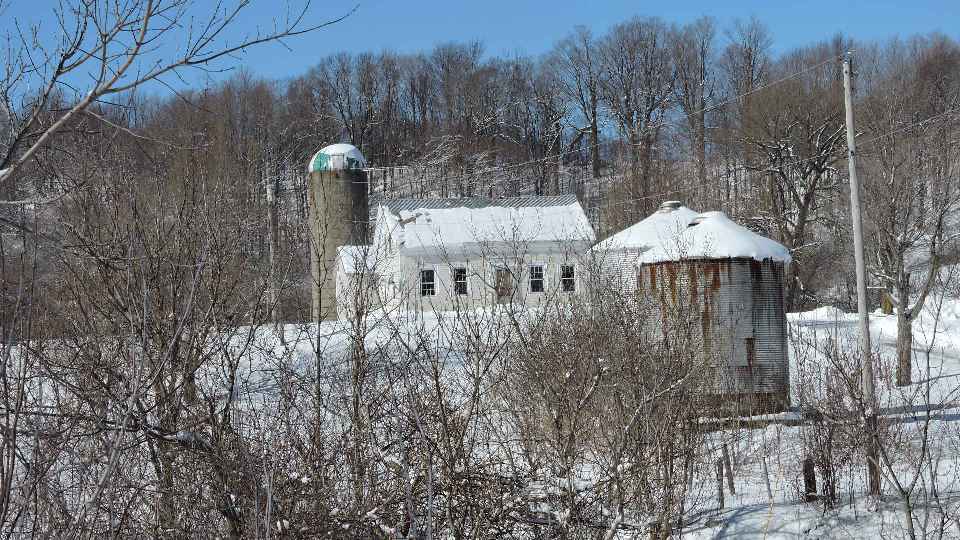
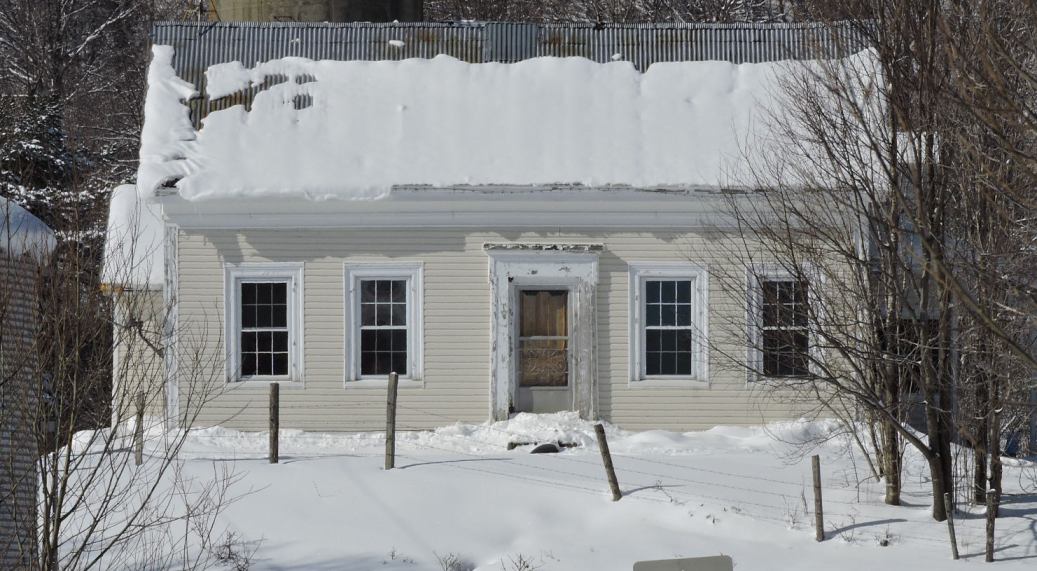
With its trim condition and its beautiful old front door with knocker
this little white frame house atop the hill in the town of Rodman near
the town of Watertown line commands the admiration of the passerby.
Operated by F H Barker, son of Charles E Barker, owner of the 91.48
acres upon which it stands, you will be told that upon the plaster of
one of the rooms is written "1801" and that the floors of the
house are of black cherry, of which there were many trees upon the farm
in the early days. Also there used to be fireplaces in the fine old house,
but they have been closed.
It is the Daniel Smith house and, if tradition were reliable, is close to a century and a half old. However, the record does not justify tradition if the original Daniel Smith of the town of Rodman was the first owner. The reason for this statement is that Daniel Smith did not own any land in the town of Rodman until September 23 1818 when he bought 224.89 acres in the locale of this house from Josiah Ogden Hoffman, New York City, northern New York land speculator. Then there is an hiatus in the record which raises a doubt whether Daniel Smith or his son, Daniel Smith Jr, was the first owner of the house.
Certain it is that it came down to the present owner from the latter, and in all probability the junior Daniel got the property from his father, but here exists a gap in the chain of title. In any event it is unlikely that the house is over 131 years old and it seems likely that that is about what it is, although it may be 25 years younger if Daniel Smith Jr, erected it.
In 1804 or 1805 the senior Daniel Smith is reputed to have come from Columbia county and settled at Camp's Mills. He fought in the battle of Sackets Harbor and on August 26 1812 bought 48.04 acres of land in the Camp's Mills area, where he erected a sawmill. On January 6 1813 he sold off four acres to Simeon Southwell and John W Phelps for $242 and on January 7 1817 disposed of the balance to Elisha Camp for $2,502. At that time Smith and his wife, Susan, were living upon a farm of 99.49 acres, in the town of Rutland, purchased April 6 1815 from Isaac and Ann Bronson, Fairfield, Connecticut
Having bought the Rodman farm in 1818 Daniel and Susan Smith were residents of that town when they sold the Rutland farm to Morris Bosworth of Lowville January 7 1824 that deed shows. What became of Daniel and Susan Smith after that the county records do not show. He was a justice of the peace in the town of Rutland and is reputed to have had three sons and ten daughters, all but one of whom reared families. The son, Daniel Jr, was born in Hounsfield in 1815 was married to Elizabeth Robbins of Copenhagen in 1844 and followed farming and cattle dealing. A son, Stephen R, was born to that marriage.
After his first wife's death he married Mercy A Brown of Rodman. He died August 2 1898 leaving the latter and the son, Stephen. But on September 20 1867 Daniel and Mercy A Smith had sold the parcel upon which this house stands to Nancy Robbins Lawrence, Susan Smith, Eveline Pawling, Emeline Smith, John B and Jennie M Jones, Nelson S and Mercy Smith. After ensuing transactions in the Smith family it came into possession of Mrs John M (Ella M) Lewis, Copenhagen, August 3 1910 and after whittling it down to 91.48 acres Mrs Lewis conveyed it to Charles E and C Mabel Barker on November 24 1936
Still sturdy and imposing, in spite of the removal of the beautiful original front door and the original windows by recent generations, this century and a quarter mansion of native limestone at LeRaysville faces an inglorious end. Owned by the United States government since September 24 1941 when it was taken over from Mr and Mrs William V Delaney to become a part of the Pine Camp military reservation, a lack of interest in the place is resulting in slow interior disintegration.
Its site consisting of two lots each four rods wide and 15 rods deep front on LeRaysville's main street. One of these lots was bought from James D LeRay de Chaumont by William Phelps, Connecticut cabinetmaker, on December 9 1817. On March 28 1923 Phelps purchased the adjoining lot from Alfred and Margaret Lathrop and shortly after that the mansion is believed to have been erected. Near it Phelps bad his stone cabinet shop and did a considerable business.
He had come to LeRaysville from Connecticut in 1811 and was one of the early postmasters of that community. His wife was Eliza, daughter of Cyrus Brown, brother of Major General Jacob Brown, and in 1856 his son built a sawmill where the first one in LeRaysville had been constructed by Benjamin Brown in 1801. William Phelps died January 2 1868 aged 76. On March 5 1886 his widow died aged almost 91 1/2 years.
Their son, William S Phelps, postmaster, storekeeper and lawyer at LeRaysville, where he was also extensively engaged in lumbering, was justice of the peace, LeRay supervisor in 1856-1857-1858 and served through the Civil war in the 194th New York Volunteer Regiment
Jules Rene Payen, a distinguished French engineer and chemist, came to LeRaysville to manufacture gunpowder by a cheap process, and in 1840 bought the beautiful LeRay mansion. There he, Chevalier of the French Legion of Honor, died July 27 1862. His daughter, Julia, who had married William S Phelps, inherited the LeRay mansion. She died July 4 1912 and on February 20 of that year her son, Frederick J Phelps, had died and the LeRay mansion by the Payen will went to Frederick's daughter, Mabel A Phelps Anderson, wife of Fred C Anderson and now resident of this city.
But the chain of title of this limestone mansion in LeRaysville runs
through many owners. On September 2 1834 William and Eliza Phelps sold it
to Zelotes Phelps, Hartford county, Connecticut, Jan 30 1836 Zelotes and
Sarah Phelps deeded it back to William. Later it passed to William S
Phelps who, with his wife, Julia, conveyed it to Jane Phelps August 25 1859 and on June 1 1868 she, then of Philadelphia, Pennsylvania, sold it to
Lydia B Child. On September 21 1875 Lydia B Child, Vineland, N J, sold
to Leonard Mosher and November 6 1886 the Mosher estate conveyed it to Frederick
Appenzeller, a native of Switzerland, who became postmaster, merchant
and hay buyer at LeRaysville and supervisor. A daughter of Mr Appenzeller
is Mrs De Witt Nichols of this city.
On October 29 1912 Mr Appenzeller disposed of this house to Frank Bowman of LeRay and on May 2 1918 Mr Bowman conveyed it to William H and Nellie Rendel Peters. Mr Peters died February 23 1930 and full title passed to his widow who married again and as Mrs Nellie Peters Ellis sold the house to William V and Marion T Delaney August 5 1935. Mr Delaney is a civil engineer and Mrs Delaney a former school teacher. They had planned to reside in the old Phelps mansion and did so for a period of six years until the United States government through declaration of taking acquired it, the LeRay mansion and much other property, for the Pine Camp military reservation.
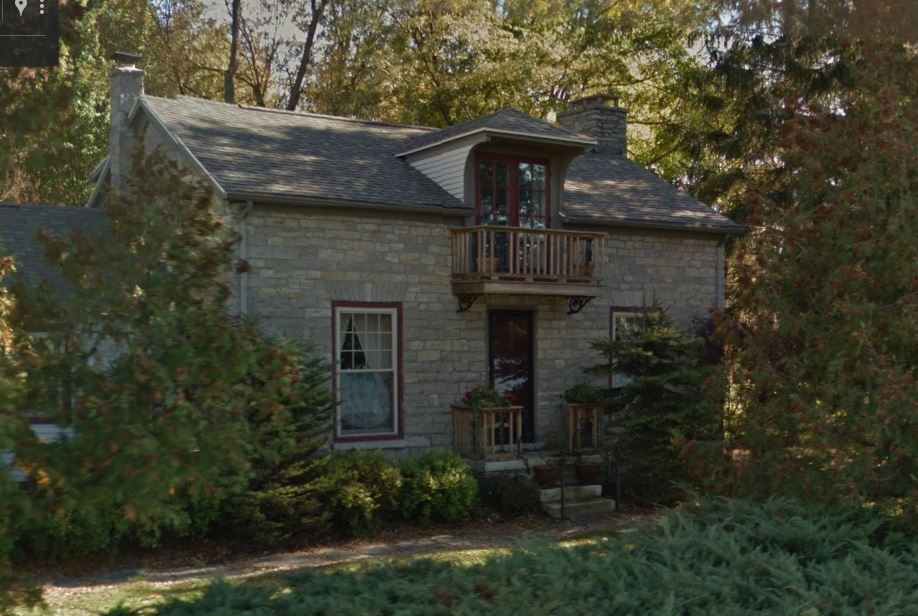
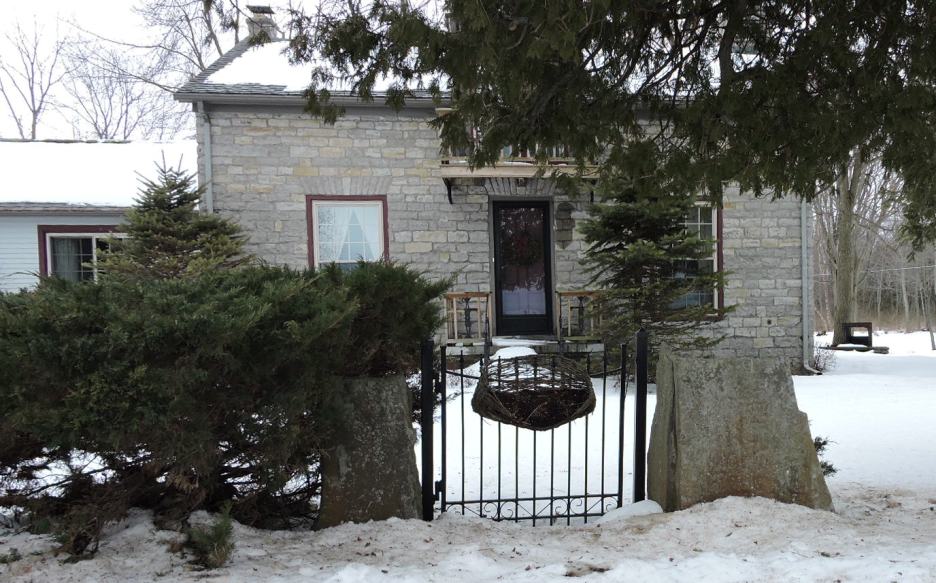
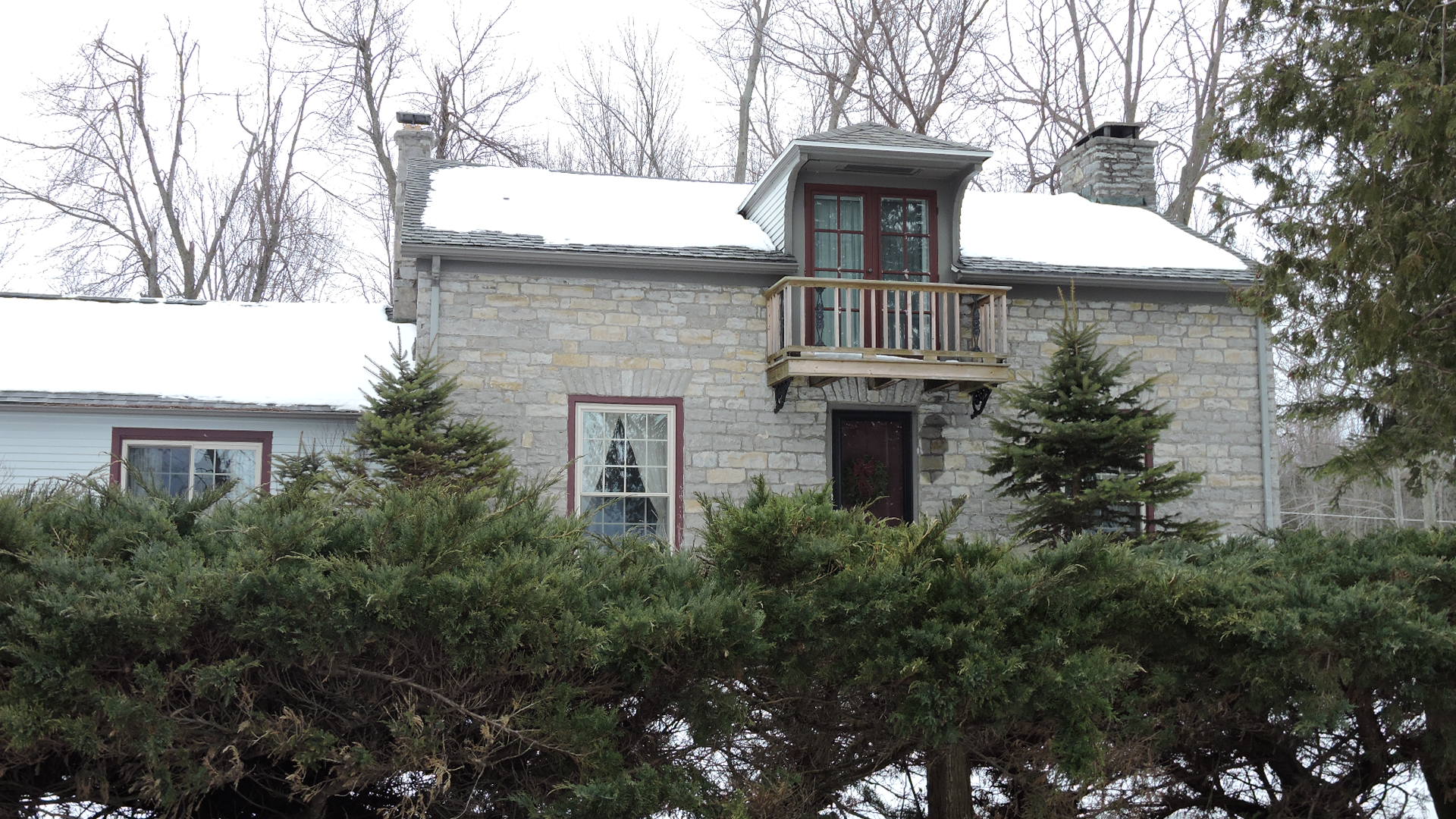
Because this old, unoccupied native limestone house, on Cape Vincent's Tibbets Point road, has had its windows boarded up so long, a decided air of mystery has enveloped it. Quaint, like something which might have ome from an old English, Irish or Norman countryside, the little house has every appearance of antiquity.
Whether its original owner was Henry Ainsworth, Buel Fuller or Charles Wilson seems uncertain, but it occupies land which was part of the 599.06 acres patented by the state to Captain John Tibbets November 18 1800.
It was for Tibbets that Tibbets Point and the Tibbets Point lighthouse got their names. So far as the record shows William E Weiss Jr, Wheeling, WV, is the present owner of this place, having purchased it and the farm which goes with it from Nellie Mance White of Rosiere and Lewis F Willoughby, Rochester, administrators of the Lewis Mance estate on April 7 1943.
Lewis Mance died June 26 1918 aged 80 years. Member of Company E, 94th
New York Volunteers, he had seen battle service in the Civil war. At the
time of his death he had owned this house and farm over 40 years, having
purchased 102 acres of the property March 5 1878 from Charles Wilson,
and an adjoining 50-acre parcel from the David Owen estate for $2,750
March 27 1872. Owens had bought that parcel from Samuel D and Zaire A
Fuller August 25 1857 and Fuller had acquired it from his parents, Buel
and Sally Fuller, on December 3 1856. Also on December 3 1856 Buel and
Sally Fuller had conveyed adjoining 50-acre parcels to two other sons.
Porter A Fuller and William D Fuller. In each of the three instances the
consideration was the same, $2,000.
County records show that on May 1 1864 Caroline Fuller joined with Porter A Fuller, her husband, and Cornelia B Fuller joined with her husband, William D Fuller, in selling their two 50-acre parcels to Charles Wilson.
While it is difficult to trace the early landholdings of the senior Charles Wilson and Buel Fuller in the town of Cape Vincent without devoting considerable time in searching and plotting adjoining properties, there is a conveyance of three parcels of 50 acres each in the area of this house from Benjamin and Elizabeth Tibbets to Buel Fuller for $600 on July 1 1835.
Reasonably may be drawn the conclusion that there was no house on the
land there at that time. It may Likewise be presumed that this house was
built by Buel Fuller. However, there is no definite proof of this existing
today.
In any event the house stands within a few feet of the lake shore, close along which the scenic Tibbets Point road runs from the village of Cape Vincent. Properly restored the old house has most attractive possibilities for a summer home, and the present owner started to make such a restoration after he purchased the place, but for some unknown reason halted these rehabilitation operations. Along this same highway and not far from this house is the fine old stone house owned and occupied by Mr and Mrs Byrd Wise, and also the old John Maynard stone house, which is now owned by J Reginald Newton.
It is one of the most picturesque localities in the picturesque and highly historic town of Cape Vincent, and from this old house one can look across the waters to Wolfe island, which is Canadian territory.
21430 Rt 47 Carthage NY en route to Felts Mills
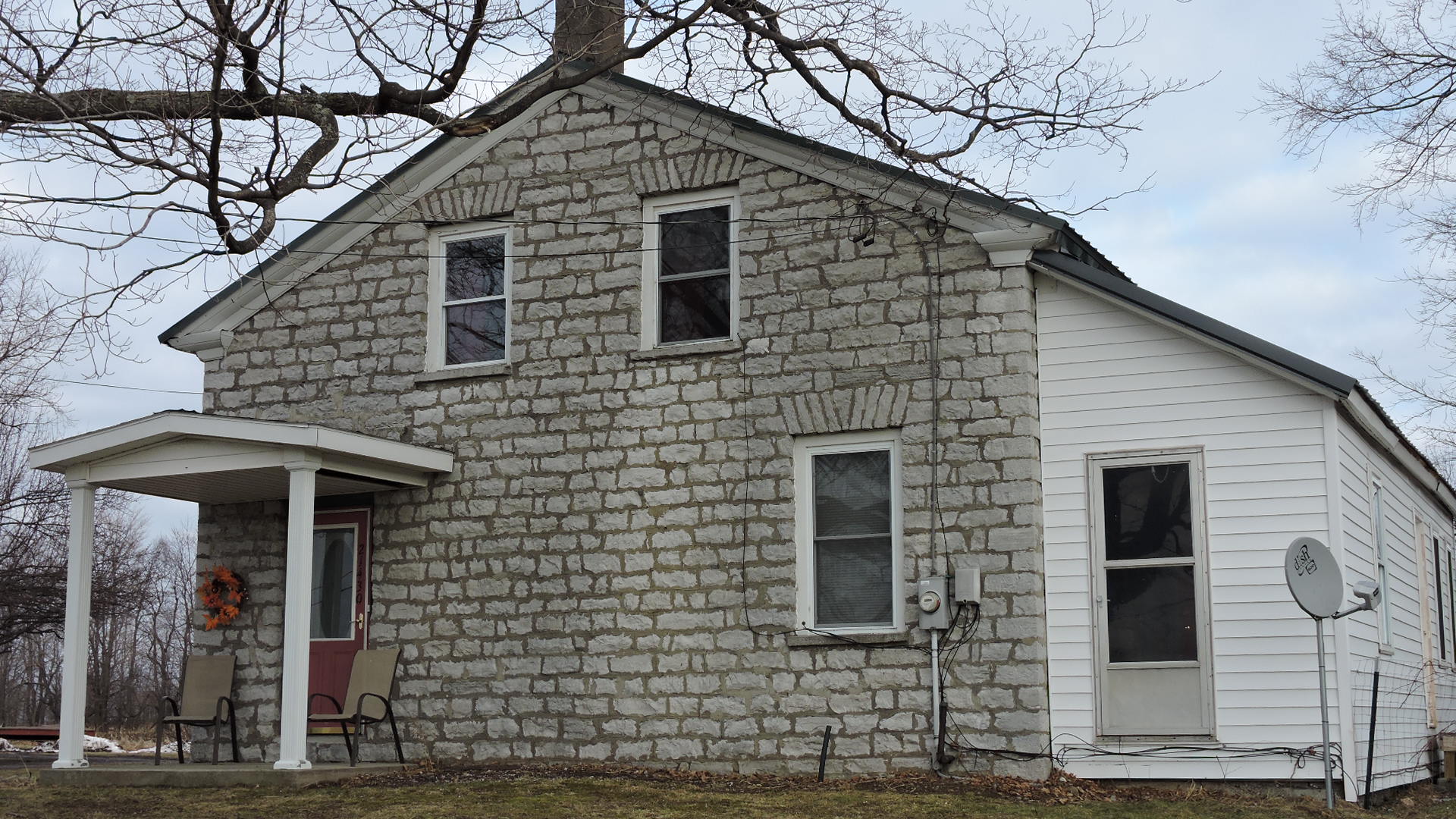
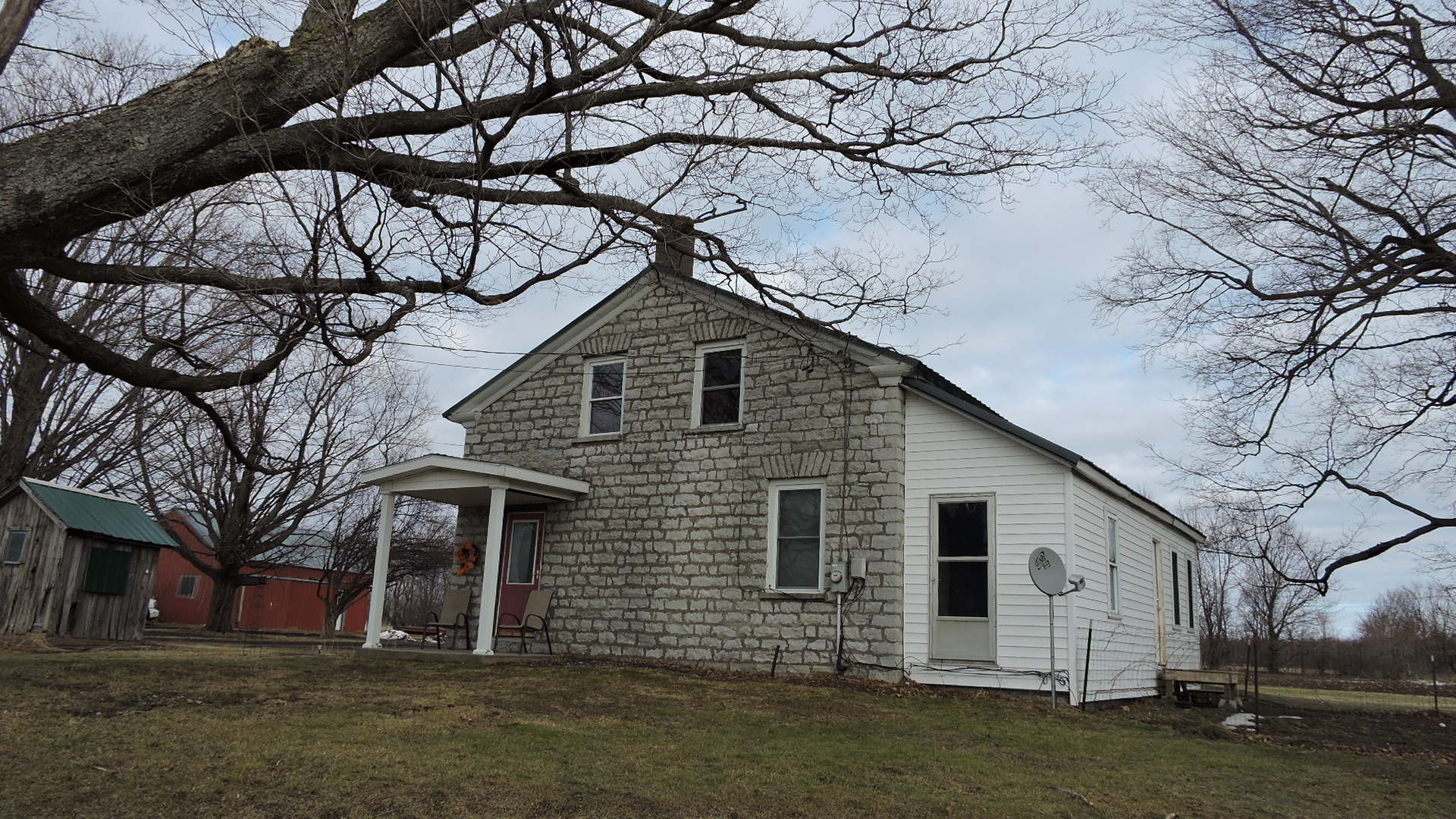
In the heart of the town of Champion, which vies with the town of Ellisburg
for the honor of first settlement in Jefferson County, is Champion Huddle.
There, in the early days of the last century, was a considerable community
with a tannery, a boot and shoe shop, distillery, blacksmith shop, cheese
factory and schoolhouse. One of the early dwellings in that section was
this native limestone house, which may first have been owned by Deacon
Jonathan Carter or by Reverend Nathaniel Dutton. In later years it was owned
by John L Goldsmid who had a considerable amount of property in Champion
and later came to Watertown, where he became one of the presidents of
the Bank of Watertown organized January 26 1839. Still later it was owned
by George S Whitney, by William A Babcock, who was a cousin of Henry
Holmes Babcock who founded the H H Babcock Buggy company in this city,
by Frederick A Babcock, by L Jay Colvin and today by Frank C and N
Belle Feistel.
The little house, whose front entrance appears to be in the end facing the big tree, must be something over 110 years old. With it are 84.75 acres of land made up of several small parcels. One of these, possibly the one upon which the house stands, was early owned by Reverend Nathaniel Dutton, native of Hartford, Vermont, graduate of Dartmouth in 1802 the year before. Daniel Webster, and whose wife was a sister of Mrs Noadiah Hubbard. H and Deacon Jonathan Carter, who came to Champion about 1804 influenced the formation of the Champion Congregational society in 1805.
This 30-acre parcel of land owned by Reverend Mr Dutton was sold by him to Goldsmid February 18 1839.
But there is another 30-acre parcel in this farm, which Goldsmid bought
and when he sold it March 1 1847 to George S Whitney, the deed stated
that the parcel was once owned by Jonathan Carter. The fact that Whitney
paid Goldsmid $3,000 for it is more than a possible indication that Carter's
domicile stood upon it. Be that as it may, Mr and Mrs Feistel bought the
property October 30 1945 from the estate of L Jay Colvin. Mr Colvin, who
died January 5 1945 at the age of 67 had purchased the place from Frederick
A and Caroline Babcock October 3 1916. Mr Babcock, who died August 6 1932
at the age of 67 was the son of William A and Adelia Wright Babcock, who
are said to have, acquired this farm May 16 1873 from the family of George
S Whitney. As has already been seen Whitney had purchased one of the 30-acre
parcels from Goldsmid in 1817 for $3,000 and as late as March 1 1863 he
purchased another of the parcels from Willard A and Deborah Knowles. Here
it should be
noted that a relative of Mr and Mrs Knowles, Caroline A Knowles, became
the wife of Frederick A Babcock on February 10 1891.
Concerning Mr and Mrs Feistel, who are among Jefferson County's unusually good farmers, it should be pointed out that their son, Glenn L Feistel, is one of the outstanding agriculturists of the country. In 1936 when he was but 18 he was elected master of the Champion grange, becoming the youngest grange master in the country. In June, 1940 he was graduated from the state agricultural college at Cornell and since then he has been prominent in 4-H club work. He has served as 4-H club agent-at-large in St. Lawrence and Cattaraugus counties, as acting agent in both Jefferson and Orleans counties and as president of the state council. On June 23 1943 he was married to Miss Shirley M Barber of this city. The early training which became the foundation of his success in the field of agriculture was built on this little Champion farm under the tutelage of his parents and the 4-H club of the county.
33720 County Rt 126 Carthage NY
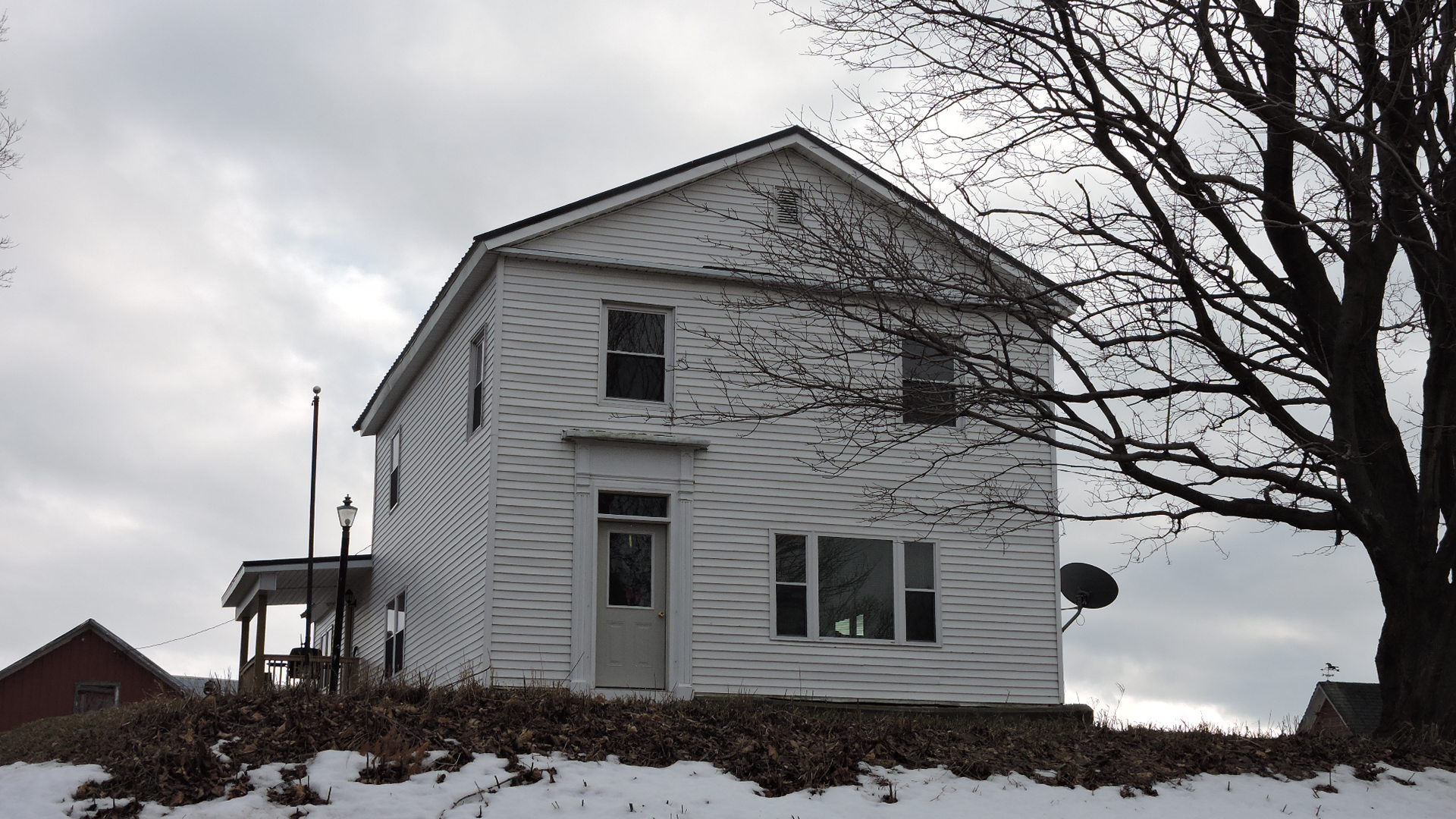
Ancient and weathered as it is this old frame house a half mile outside the hamlet of Champion on the Watertown- Champion road was onetime one of the pretentious houses of the county. Even today the comforts of its interior belie the weather worn appearance of the outside, and the front doorway hints of the entrance beauty that originally existed there.
Probably constructed more than a century ago, the house has a decided resemblance to the frame house erected in the hamlet of Champion early in the last century for Noadiah Hubbard, who was one of the first two settlers in Jefferson County.
While there appears to be no record as to the builder of this house, one may reasonably conclude that it was constructed by David Granger, who lived not far away and was one of Jefferson County's most- noted housebuilders, he having been the master builder of the LeRay mansion near LeRaysville.
Just what the relationship was between David Granger and Thomas A Granger, who was one of the early owners if not the first owner of this house, is not known and it is highly regrettable that there exists no substantial history of this family in this county.
From whom Thomas A Granger bought this house and farm or when there is no record, but on March 1 1854 he and his wife Julia A Granger sold it to Leonard and Harlow L Pierce for $6,125. It is reasonable, therefore, to assume that the house is well over a century old, and the fact that Thomas A Granger purchased a small parcel of land not far away in the same town from David Granger March 20 1837 leaves the premise open that David may have built and sold this house to Thomas.
David Granger and his wife, Lucy, are buried in Champion's Hillside cemetery
along with Colonel Elias Sage, an apprentice of David who worked on the LeRay
mansion, and along with Noadiah Hubbard and his family. What became of
Thomas A Granger seems to be a mystery. He is not buried in any of the
Champion cemeteries and the presumption is that he and his family removed
to other parts.
As for this house and farm the record is clear from the time Thomas and Julia Granger sold it to Leonard and Harlow A Pierce March 1 1854. On January 28 1862 Leonard and Anna Pierce sold their interest to Harlow L Pierce for $3,000 and October 28 1876 Harlow L Pierce sold the whole property to James Holcomb of this city, for $6,500. There was 210 acres at that time and August 1 1882 James and Jennie J Holcomb conveyed it to Orlin Holcomb.
Orlin Holcomb, city, transferred the place to Eva May Champlin, adopted daughter of Watertown's Chief of Police Charles G Champlin May 10 1889. Eva May became a Mrs McCormack and as Eva May McCormack she sold the house, outbuildings and 210 acres to Fred H and Nettie W Lord of Glen Park March 26 1909. On December 22 of the same year they disposed of the property to Archie V and Lucy M Weaver of Champion, and they retained it until January 28 1917 when Homer W and Elizabeth M Hobbs of the town of Croghan purchased it of them and on March 3 1948 sold it to Olive B Hoffman, wife of William Nichols Hoffman, the present owner.
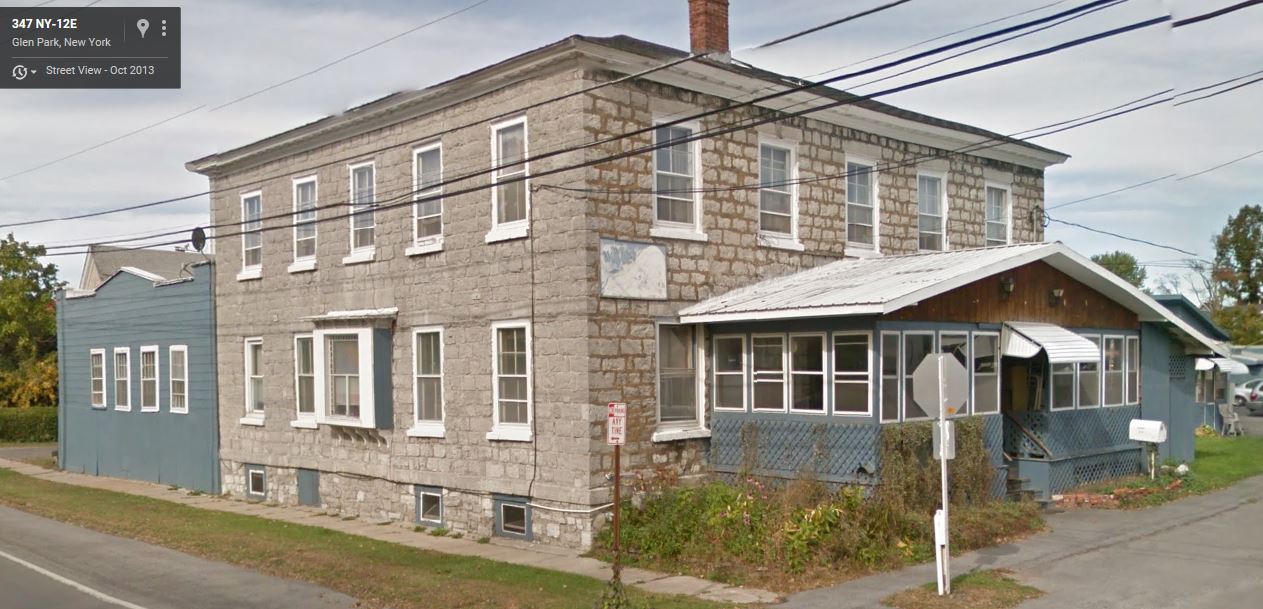
James Wood, one of the colorful early figures of Jefferson County, concerning
whom all too little is known, came to the Black River country about 1804.
For a time he kept tavern on the present Hotel Woodruff site. He fought
in the War of 1812 and Caroline, his wife, baked bread for the soldiers
at Brownville.
Later he built a dam and cloth-dressing mill 80x350 feet at "Jim Wood's Falls," previously known as Bartholomew's falls, where Glen Park now is. Before machinery arrived for the mill a spring freshet took it and the dam out one night. Not till the next morning did he discover his loss. Then he moved to Dexter, built a sawmill and engaged in the lumber business. Although progressive he was not a financier and did not prosper. He built the propeller James Wood, first of its kind on the lake, and ran vessels on the Erie canal. Then he became a commission merchant in lumber at Detroit, Michigan, where he died December 29 1851 aged 69. He is buried in Brownville cemetery as is his wife, Caroline, who died January 4 1845 aged 55 their son, Gilmour, almost 30 and twelve-year-old daughter, Sarah, who died in 1841.
Concerning James Wood and three of his sons Emerson's history of the county of half a century ago states: "They also built the large two-story stone dwelling house for many years called the 'Jim Wood place,' but now occupied as a postoffice and dwelling at Glen Park." A quarter of a century ago the postoffice was discontinued.
From county records it would appear that "Jim" Wood's son,
James N Wood, who became a lumber merchant in New York City, held title
to this property. On October 22 1830 James N Wood purchased from the trustees
of the Mechanics Fire Insurance company a hundred acres where this house
is. On December 5 1848 while residing in New York he sold the same parcel
to Asel Wilcox of Manlius, for $4,000. Charles R Remington, paper manufacturer,
bought 16 acres of this plot from William Thomas March 12 1881 and 35.76
acres from Fernando H and Viva Reeves November 27 1882. The C R Remington
& Son Paper company was afterward formed and August 25 1893 Charles
R and Charles H Remington and their wives deeded all of their land holdings
in the Glen Park area to the C R Remington & Son company for $225,000.
The International Paper company purchased the property from them February 27 1899 later conveyed to a subsidiary, the International Hydro-Electric company, and it on January 5 1932 sold this house and the large lot, bounded by Main, Church and Park Streets, to Neil Huff. Before that sale the International Paper company had discontinued operation of its three Glen Park paper mills. But during all of the years those mills flourished the "Jim Wood" mansion was used as a superintendent's residence by the C R Remington & Son company and its successor, International Paper company.
Neil and Lona Huff sold to Terrah and Isabelle Wilson April 5 1934 who conveyed to Michael Brady October 1 of that year and November 25 1935 Brady
disposed of it to Joseph J Yett and it became the Glen Park Hotel, but
June 25 1937. Joseph J and Florence I Yett sold out to Paul Pryl of
Amsterdam, who operated it until December 12 1938 when he sold back to the
Yetts and the place became "Gene's Inn."
However, Mr and Mrs Yett sold it to Paul H Holton, April 24 1945 and the following September 10 he disposed of it to Emmett O and Pauline M Abbess, the present owners, brother-in-law and sister of Charles and George Sowan. When the property became a public place the dance hall was added.
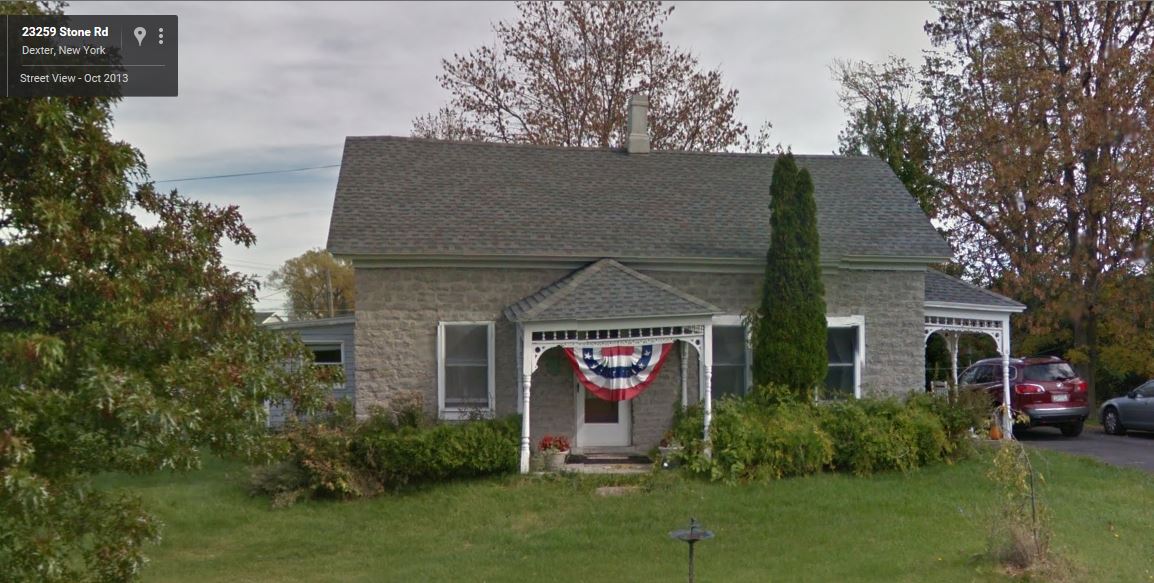
As one turns from the shore road, that passes the long and closely-knit string of summer cottages at Adams Cove, into the Pillar Point highway he sees this old native limestone house in the angle. It faces on the Pillar Point road and directly across from it is the old District school No. 13.
This house is the old James R Adams farmhouse, the age of which is probably around 115 years. From the heterogeneous and sketchy title record one cannot positively say who the first owner was, but in all likelihood it was Henry Adams, who is mentioned in the histories as having been one of the earliest settlers of Pillar Point.
Across the shore road to the north is the cove, which is a part of Guffin's Bay. The cove may have been named for Henry Adams or for several members of the Adams family, for there were a number of them who owned farm lands in that immediate vicinity. James R Adams, Seth O Adams and Henry Adams lived along in a row with John D Burlingame, Sylvanus Henderson, F Dibble and other early settlers of what is now the Adams Cove summer colony.
There was a John Adams, son of Henry Adams, born in the town of Rodman, but who settled on Pillar Point in 1834 and married Eunice Farewell, daughter of Solomon and Sabina Burlingame Farewell of Denmark. One of the children of John and Eunice Adams was Milo J Adams who, incidentally married Laverne E Adams, daughter of James R and Margaret Satchwell Adams, owner of this house.
Milo J Adams is mentioned because on September 3 1892 he bought the 55.74-acre
tract where this farm is from Mary C Adams Emerson, Kearney county, Nebraska,
who was the daughter of James R and Margaret Satchwell Adams and wife
of Charles D Emerson, and who inherited her interest in the farm from
her father.
This 55.74-acre tract was purchased by James R Adams from Henry Adams for $1,000 on May 1 1866 which leads to the belief that this house was built for Henry. There is, however, in the farm today another tract of 50 acres and a small parcel of .32 of an acre, which Washington Coster, New York City speculator in North Country lands, sold to Mrs Elmira Hunter on November 20 1839 and which the Hunter heirs disposed of to Sylvanus Henderson March 15 1865.
It remained for Frank M Bosworth of this city, to bring the 55.74 acres, 50 acres and .32 of an acre together into the present farm in 1906 he having bought one parcel on September 15 and the other on September 18 of that year. On January 11 1908 he disposed of the whole to A H Lefebvre, Black River Traction company manager and local industrialist. Mr Lefebvre sold the property to William Allison, Dexter, April 15 1915. The following November 15 Mr Allison conveyed the place to Mary A Herrick and on September 22 1944 Mary A Herrick sold to George W Olin, the present owner.
Unquestionably there is interesting history tied into the story of this old house, just as there is into practically every old stone house in the entire North Country, but apparently none of it has been reduced to writing and so has been lost to the present generation.
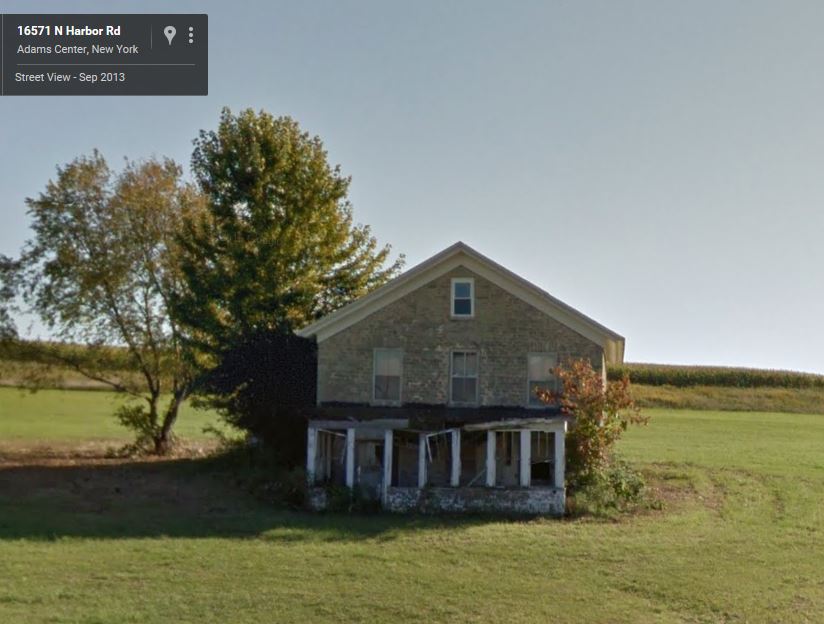
Another old native limestone house bearing every evidence of being considerably over a century in age is this Walsworth house located on the road which taps the Watertown-Syracuse state highway east of the village of Adams Center and runs from there to Smithville.
One of the early and most popular pioneer settlers of the town of Adams was Zacheus Walsworth. County records fail to tie the ownership of this house to him, although it is not unlikely that it was first his home. Lewis Walsworth was, however, one time its owner and three months prior to his death conveyed the farm to his sons, Warren and Levi J, in exactly equal amounts of 78.92 acres each.
The transfers were made on the same date, June 4 1889 and on the following September 8 Mr Walsworth died leaving a widow, Lucinda, and children, Mrs Sarah McWayne, Levi J Walsworth, Warren Walsworth, Byron Walsworth of the towns of Adams and Hounsfield, and Mrs Elvira Mott, New York City.
Apparently the part of the farm containing this house was deeded by Lewis to his son, Warren, who, with his wife, Rebecca, sold it to Eugene Cobb of the town of Adams on September 7 1898. Ten years later, on August 31 1908 Warren Walsworth died leaving his widow Rebecca, who was then 56 and resident of Sackets Harbor, but no children. Mrs Walsworth lived until October 8 1928.
On February 10 1900 Eugene and Sarah Cobb sold the property to Fred L Walsworth. He was the son of Levi J Walsworth and the brother of Mrs Sarah Cobb. Fred L Walsworth, who died March 16, 1948 at the age of 67 was the husband of the former Miss Amelia Phelps of Hounsfield, and on May 10 1915 they disposed of this house and farm to Thomas H Hollowood of this city.
Mr Hollowood, now deceased, having died October 17 1946 at the age of 64 was long prominent here in the ice business having first been identified with the late Chauncey W Gray and later manager of the ice business for Clarence B Hartman.
Mr Hollowood, who had also served as deputy sheriff and turnkey at the county jail for a time, retained ownership of this old house and farm for 28 years and on November 10 1943 sold to William and Ethel Burroughs for $7,000. At that time as now the place consisted of 70 acres in two parcels, one of 60 acres and one of ten acres, some of the original land of the farm having been sold off.
Mr and Mrs Burroughs kept the 70 acres and buildings only until May 16 1944 when they sold to Rea L and Daisy C Fralick, the present owners.
Mr Fralick is the son of the late Ornaldo C and Percie Anna Hogan Fralick of Honeyville, the latter of whom died May 9 1942 and the former on December 22 1948. Ornaldo C Fralick, who died at 73 was the son of Adam N and Adelaide Washburn Fralick of Rodman. Mrs Adam N Fralick was born June 8 1849 daughter of Moses Clinton and Caroline Burton Washburn of Rodman.
But the story of this old house which, along with its farm, is maintained in excellent condition, has been lost. It is located off the beaten trail on the so-called North Harbor road which ends in Sackets Harbor if followed to the right beyond North Adams instead of the road which runs from that point to Smithville.
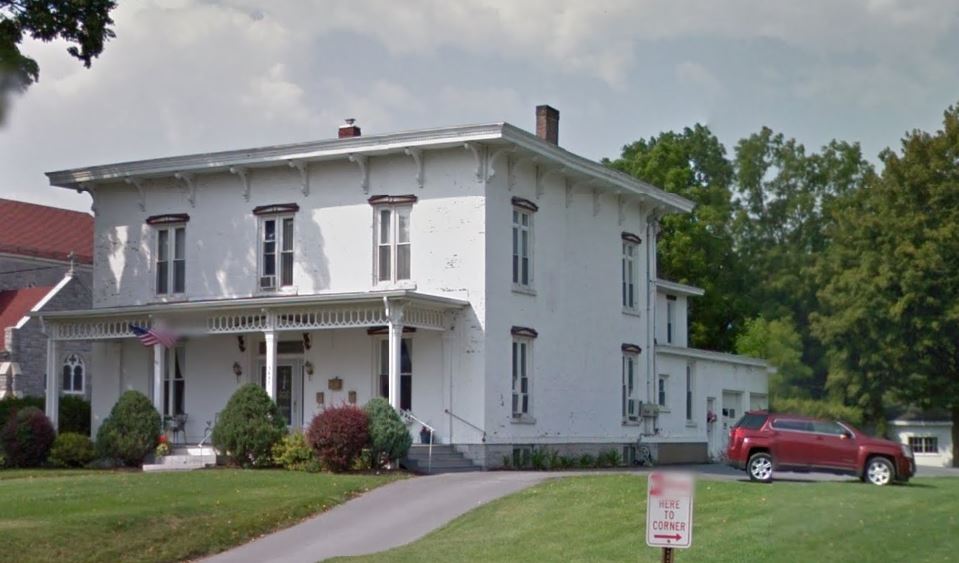
A century ago the Doigs constituted one of the outstanding families in Lowville. Andrew W Doig and his half brother John were for several years business, political and civic leaders in Lewis county's seat of government. They were sons of Andrew Doig, who had come to Lowville in 1809 from Jackson, Washington county, NY, and who had been born in Perthshire, Scotland, February 29,1776. The elder Doig died March 11 1854.
His son, Andrew W Doig, was elected county clerk of Lewis county in 1825 and served one term. He was assemblyman in 1832 and from 1835 to 1840 was surrogate.
From 1839 to 1843 he was congressman from the 16th district which included Herkimer county and served in the 26th and 27th congresses. He was a member of the Democrat party.
In 1849 he joined in the great gold rush to California, but returned to Lowville after a few years and then with his son-in-law, E G Morris, moved to Brooklyn, where he died at Green Point July 11 1875 and was brought back to Lowville for burial. During his residence, in Lowville he was for years a trustee of Lowville academy.
On October 30 1854 Andrew W Doig et al conveyed the large lot at 73 Shady avenue, upon which this large brick mansion stands, to his brother, John, who is reputed to have built it that year. Back in 1801 this same site had been acquired by Captain Jonathan Rogers, who built upon it the first brick house in Lowville. Rogers, who had come from Westfield, Massachusetts, in 1798 also had the distinction of having constructed the first frame house in Lowville.
The Rogers brick house had disappeared from the scene by the time John Doig built this mansion of brick, which became one of the most pretentious houses in Lowville. And here John Doig resided until his death November 15 1867. Possession of this property remained in the Doig family until April 8 1940 making a total period of almost 84 years of Doig ownership.
Born in Lowville May 15 1820 John Doig was son of Andrew and Polly Thompson Doig. Educated in Lowville academy, John Doig was later for some years a member of its board of trustees, of which he was also for a time treasurer.
Aside from two years when he was a clerk in New York City, John Doig
spent his entire life in Lowville, where for many years he operated a
drug store, a citizen reputed for his honor and integrity.
On May 1 1848 he was married to Miss Maria Knox. Their children were Frank C and Charles K Doig. Except for village service John Doig steadfastly refused to accept public office. For a number of years he was village trustee, then village treasurer and finally president.
After his death title to the mansion passed to his widow, Maria K Doig. She died May 14 1890 and her two sons succeeded to the ownership. Frank C Doig died April 2 1909 and the mansion went to his widow Kale and to Charles K Doig. The latter died March 5 1937 Kate, who died November 5 1938 her only daughter, Mrs Maria willing his interest to leaving the property to Doig Mitchell.
Mrs Mitchell sold it to Claude A and Elizabeth Stevens Dekin April 8 1940. Son of A A Dekin, Claude A Dekin was born in Glenfield February 9 1888 was educated there, came to Lowville in February, 1903 was married to Miss Elizabeth S Stevens, daughter of Mr and Mrs William W Stevens, October 22 1919 and that year became a member of the furniture and undertaking firm of A A Dekin & Sons, to which he became the sole successor in 1929. World War I veteran and charter member of Lowville American Legion Post 162 Claude A Dekin is also prominent in Masonry, was master of Lowville Lodge, No. 134 F & A M, in 1917-1918 and later grand sword bearer of the state Masonic grand lodge. He is also past president of the Lowville club and a Kiwanian charter member. Mrs Dekin is a past matron of Zenith Chapter, O E S, and prominent in civic affairs. They sold this house to Leonard D Harris December 1.
At the northwest corner of State and Central Streets is this well built red brick house nearly a century, if not slightly over 100 years old. For 46 years it has been owned by the J B Wise estate and some years ago was converted into a three-apartment house. Fortunately, however, from an aesthetic standpoint, its original smallpaned windows have been retained.
Down through its long history there have been some ownerships of distinction. For instance in the post-Civil war period it became the residence of Roswell D Murray, a skilled stone and brick mason who played an important role in the construction of the beautiful LeRay mansion near LeRaysville, in the building of the John Felt mansion at Felts Mills, the Woodruff and old American hotels as well as the Knowlton stone dam, the old Jefferson County bank and the old Kirby hotel in this city, and the stone barracks at Madison Barracks.
Roswell D Murray was born at Fairfield, NY April 30 1800 but came to Lewis county with his parents when a small boy. His wife was the former Clarissa Dodge. Leonard R Murray, son, conducted a crockery store here. Alice Clarissa, daughter, married Samuel Adams, local musician and music store proprietor, parents of the late Dr Murray M Adams.
On January 6 1866 Perley Blodget, who had bought the place April 15 1864 from Guevera Wait, sold it to Mr Murray who conveyed it to his daughter, Mrs Adams, November 12 1872 and she disposed of it February 2 1884 to John I Woolworth, Civil war veteran and Champion farmer who, like Frank W Woolworth, dime-store magnate, was a great grandson of Phineas Woolworth.
Mr Woolworth died June 6 1887 and the house went to his widow, Helen S Arthur Woolworth, who lived there with her daughter, Cynthia, first wife of the late Dr Delancey B Armstrong. Cynthia died November 30 1900. Three years later Mrs Woolworth died leaving the house to her brothers, Hiram S and J Herbert Arthur, and sister, Mrs Mary J Woolworth. Then on April 20 1903 Helen S Woolworth's estate sold this property to Constantine Ganter and Silas D Ball who disposed of it to the late Mayor James B Wise, founder of the J B Wise company, September 27 1904.
The lot upon which the house stands was sold by Mary C Sewall and her
trustees to Walter Monteith July 10 1838. The ensuing October 1 Monteith
sold to William VanderBogart, and May 22 1845 VanderBogart sold to Francis
Lamon. One deed by Gilbert Woodruff to Samuel Clark January 13 1853 for
$3,100 stales that Woodruff bought the lot from Francis Lamon August 1
1848 in which case Woodruff, builder of Washington hall and many other
local buildings and houses, probably erected this house. Its construction
would substantiate that, but there is no recorded deed to support this
reference.
On the contrary the record shows that Lamon sold the lot to John Collins
August 1 1848 for $360; that Collins sold to Daniel W Rickerson, merchant,
March 20 1852 and that Rickerson the following December 14 sold to Woodruff
for $3,000 and Woodruff disposed of it to Samuel Clark January 13 1853.
Clark sold to Guevera Wait March 3 1860 and Wait sold to Blodget April
15 1864 as already stated.
In any event the lot was originally part of the extensive Sewall holdings which went all of the way from State Street down Central Street to the river and included besides, Sewall's island, and much of Factory Street. And in spite of the record, or lack of it, this house was probably built by Gilbert Woodruff, one of the finest creators of buildings this community has ever known.
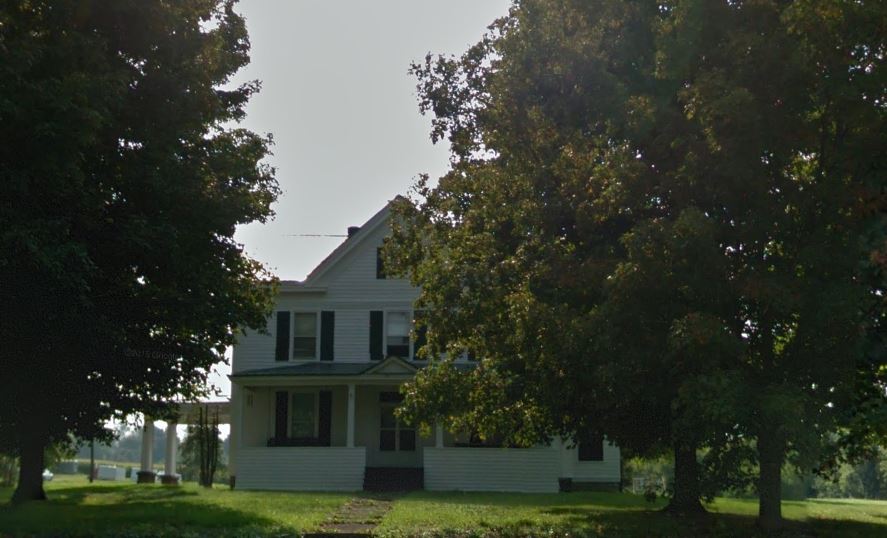
Brother-in-law of Silas Stow, land agent for Nicholas Low, for whom the town and village of Lowville, Lewis county were named, Judge Daniel Kelley was not only one of the earliest but one of the most prominent settlers there as well.
Dr Franklin B Hough, famed north country historian, is authority for the statement that on April 12 1798 for a consideration of $650 in payment of 250 acres of land there went to Daniel Kelley the first deed to an actual settler in the village of Lowville.
That land was on outer State Street on the south side of the creek beyond the old Strife House and from a high and sightly location overlooking the village stands the Kelley residence, a frame structure probably built at least 140 years and possibly a century and a half ago. Today, owned and occupied by Mr and Mrs Arthur Nelson Virkler, it is probably Lowville's oldest residence.
Born in Norwich, Connecticut, November 27,1755 son of Daniel and Abigail Kelley, this early settler of Lowville, Daniel Kelley, was married June 28 1787 to Jemima Stow, sister of Silas Stow of Middletown, Connecticut, and in 1798 they removed to Lowville.
That same year he erected a log cabin, and on the south side of the creek a saw mill. The cabin was placed against a huge boulder. The next year he raised a grist mill and placed it in operation September 22 1799. Likely it was not many years later that he erected his large frame house which, much added to and altered by later owners, is seen in its present form above.
The front gable and verandah, the substituted front entrance and large-paned windows, the altered cornices, the porte cochere and the rear addition constitute a facelifting beyond all resemblance to the original Kelley house, built on a one-acre plot of high ground which he cleared for the purpose in 1800. The implication is that the house was constructed at that time.
And though Daniel Kelley tarried but briefly in Lowville, selling his property of 100 acres to James Henry for $5,000 on May 10 1814 and removing to Cleveland, Ohio, where he served as postmaster and as county treasurer before his death August 7 1831 aged 76 he left an historic imprint in Lewis county.
When the county was set off in 1805 he became Lowville's first supervisor, and he was one of the first three judges of the court of common pleas when it convened at Chillus Doty's tavern in Martinsburg December 8 1805. On March 29,1806 he was appointed the first county judge of Lewis, and when Lowville academy was chartered March 21 1808 he was one of its first trustees.
Kindhearted and keen mentally, his wife, who died September 14 1815 nursed the sick and acted as midwife in many a Lowville family. Datus, Alfred, Irad, Joseph B, Thomas M, and Daniel were their children, some of whom added luster to the name in the middle west.
James Henry, who acquired the house and 100 acres of land from Daniel Kelley on May 10 1814 held ownership of the property a score of years and then on September 2 1834 transferred it to Harvey Henry who sold to William George for $9,600.47 on October 27 1857 and March 8 1859 George sold to Charles H Curtis for $9,000. Curtis also kept it 20 years and conveyed to James T Campbell December 9 1878 for $8,000.
Mr Campbell made extensive changes in the house in the latter part of 1895 and on June 20 1927 sold to Mr Virkler, prominent in the automobile business for upwards of 40 years, and the Lowville Ford agent since 1914. Fourteen years after that Henry N Nortz became his partner. Mr and Mrs Virkler are among Lowville's leading residents, and several of the prior owners of this house were likewise prominent in the community
One of the few undemolished old native limestone houses in the LeRaysville area for addition to the Pine Camp military reservation is this rectangular Georgian type dwelling probably built about 125 years ago by Benjamin McOmber.
It is in the heart of the hamlet of LeRaysville, being located on the corner of Pearl and Pleasant Streets, directly across the alley from the now nonexistent old LeRaysville hotel, a big wood structure erected about 1810 two years before James D LeRay de Chaumont moved into his first mansion not far away, and operated by Amasa Barber at an early date.
In the same immediate vicinity resided Dr Horatio Orvis, LeRaysville's first physician and only a little way distant Leonard Fortune started an axe-helve factory.
On July 18 1825 the LeRays sold the site for this house to Benjamin McOmber for $63.70. It is likely that McOmber erected the big stone house shortly after that, for undoubtedly there was a house on the lot when he sold the property back to Vincent LeRay October 29 1830 for $700.
Vincent, who had been managing the vast LeRay north country estate from 1823 when his father, James D LeRay became insolvent, retained possession of this house nearly 34 years, using it perhaps as a domicile for some of his representatives. Through his attorney, Patrick Somerville Stewart, he sold it to Mrs Esther Jones, wife of William Jones, on August 1 1864. Mrs Jones, who later became Mrs Esther Klodwick of the town of Croghan, disposed of it to Heman B Corey, town of Alexandria, on October 17 1872.
On September 20 1875 Heman B and Margaret C Corey transferred the place to Francis D Planck and less than four years later Frank D and Eliza M Planck conveyed it to Stephen Roberts for $1,000. For a considerable period of years it remained the homestead of the Roberts family, Stephen Roberts, a Quaker like many of the others in that vicinity, having been one of those who worked on the construction of the Quaker meeting house at LeRaysville.
Stephen Roberts deeded this house to his wife, Eunice, January 13 1891 and the following June 17 she conveyed it to their son, Samuel C Roberts. He retained it ten years and on May 22 1901 with his wife, Dulina C Roberts, then of the town of Denmark, Lewis county, disposed of the property to Eugene A Child. On May 8 1905 Eugene A and Helen M Child sold to Frank G Taylor and January 15 1906 he and his wife, Betsey M Taylor, transferred the old house and lot to Frank Fortune of the town of LeRay. Frank and Addie Fortune sold to William H Savage December 31 1918 and under his will it went to John Savage June 2 1930.
Frank G and Betsey M Taylor, Great Bend, then acquired it back again on June 24 1931 from John and Pauline Savage and on November 19 1941 Mr and Mrs Taylor, Great Bend, and Maynard Johnston, city, disposed of it to the United States of America for $1,850. It is now occupied by tenants.
Mr Taylor, retired paper mill sawyer, died February 5 1948 aged 80. His wife was the former Miss Betsey M Sheldon of Felts Mills.
Stephen and Eunice Roberts were the great-grandparents and Samuel C and Dulina C Roberts were the grandparents of Deputy Postmaster E Byron Cory of this city (Watertown), his mother, wife of John M Cory, city, being Miss Ella Roberts, daughter of Samuel C and Dulina C Roberts. Mrs Eliza M Planck, wife of Frank D Planck, was a daughter of Stephen and Eunice Child Roberts, great-grandparents of Deputy Postmaster Cory. Mr Cory is not aware of a relationship to Heman B Corey, but the chain of title to this house indicates that its ownership was in E Byron Cory's ancestors
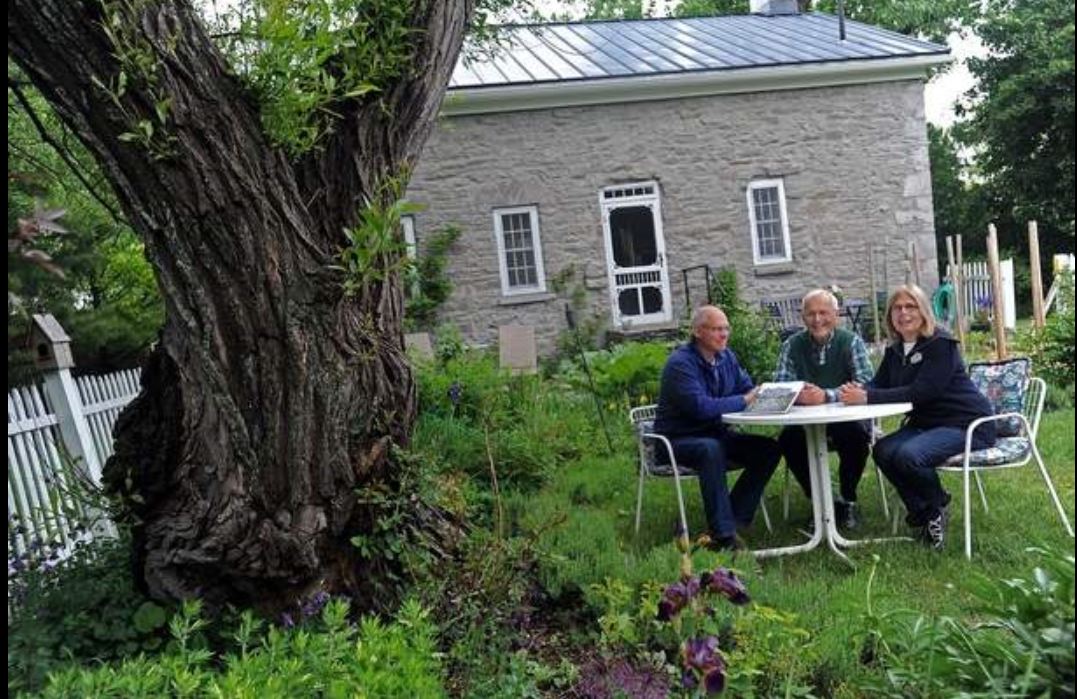
The image below and info below is from:
https://www.stonehousesofjeffersoncounty.org/historic-houses-inventory
On the lake shore of Pillar Point at the beginning of Sherwin's Bay is this cozy little house of native limestone, owned and occupied by Ernest C Eveleigh, prominent Jefferson County farmer and controller of a considerable amount of summer resort shoreline back of this house.
It is a pleasant and sightly place and the farm of Mr Eveleigh, who has given considerable grand and trial jury service in the county, consists of 174.34 acres made up of four adjoining parcels.
Mr Eveleigh and his late wife, the former Miss Mary L Bonnett, purchased this property from Ora I Taylor, town of Brownville, on December 17 1937. The deed shows it to consist of a parcel of 64 acres, one of 35.83 acres which was formerly part of the Asahel Burlingame estate, one of 35.51 acres also at one time part of the Asahel Burlingame estate, and one of 39 acres which Samuel Read purchased from the Mechanics Fire Insurance company of New York City through its attorney, James D LeRay de Chaumont. This insurance company had been a speculator in LeRay lands in this north country.
From the county records it appears that Mr Taylor purchased the 134.34 acres consisting of the 64-acre, 35.83-acre and 35.51-acre parcels from Fred Taylor, town of Brownville, November 26,1906. Fred Taylor had bought them from Warren Gould March 2 1903 and Warren Gould had acquired them from Albert A and Franklin M Burlingame October 4 1902. The Burlingames got them back in the late 1880s from Alonzo Burlingame and it appears that the two smaller plots had been part of the Asahel Burlingame estate
Asahel Burlingame was one of the early settlers of the town of Brownville and the bulk of his land-holdings had been purchased by him in 1832 and 1834. The 64- acre tract, which had been sold by Washington Coster in 1839 he being an early New York City speculator in LeRay lands, however came through another channel of ownership to Alonzo Burlingame on January 11 1861.
From early town maps it would seem that the 39- acre parcel is the one upon which the house stands and the record of this parcel would indicate that the construction of the house followed within a year or two after Samuel Read bought the plot from the Mechanics Fire Insurance company for $141.54 on August 13 1827.
On April 20 1868 Samuel Read conveyed the 39-acre parcel with two other parcels to Dyer Read, who sold it to John Gould March 25 1887 and on March 8 1897 John Gould sold it to Warren Gould for |2,000. It was from Warren Gould that it went to Fred Taylor on March 2 1903.
The county map of 1855 and the county atlas map of 1864 show Samuel Read as the owner of this property, but the county atlas map of 1888 indicates John Gould to be the owner at that latter time. These indications correspond with the record in the county clerk's office leaving the inference that the house is over 120 years old. However, Mr Eveleigh has been informed that Dyer Read was the builder of the house which, if correct, means that it is not over 82 years of age. The type of construction, despite the modernizations, makes it likely that the house is much older that that.
29005 Rte 37 Evans Mills
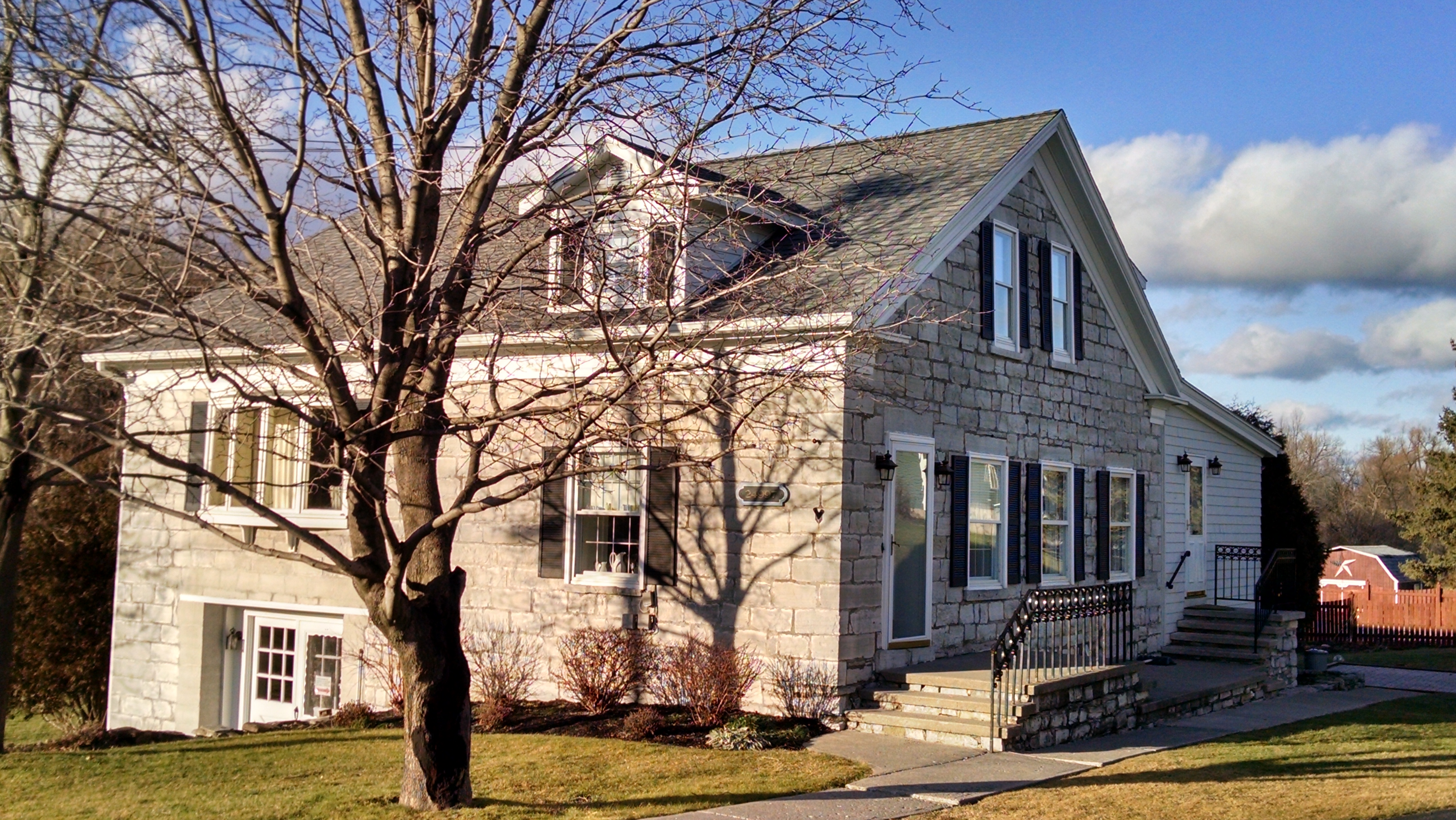
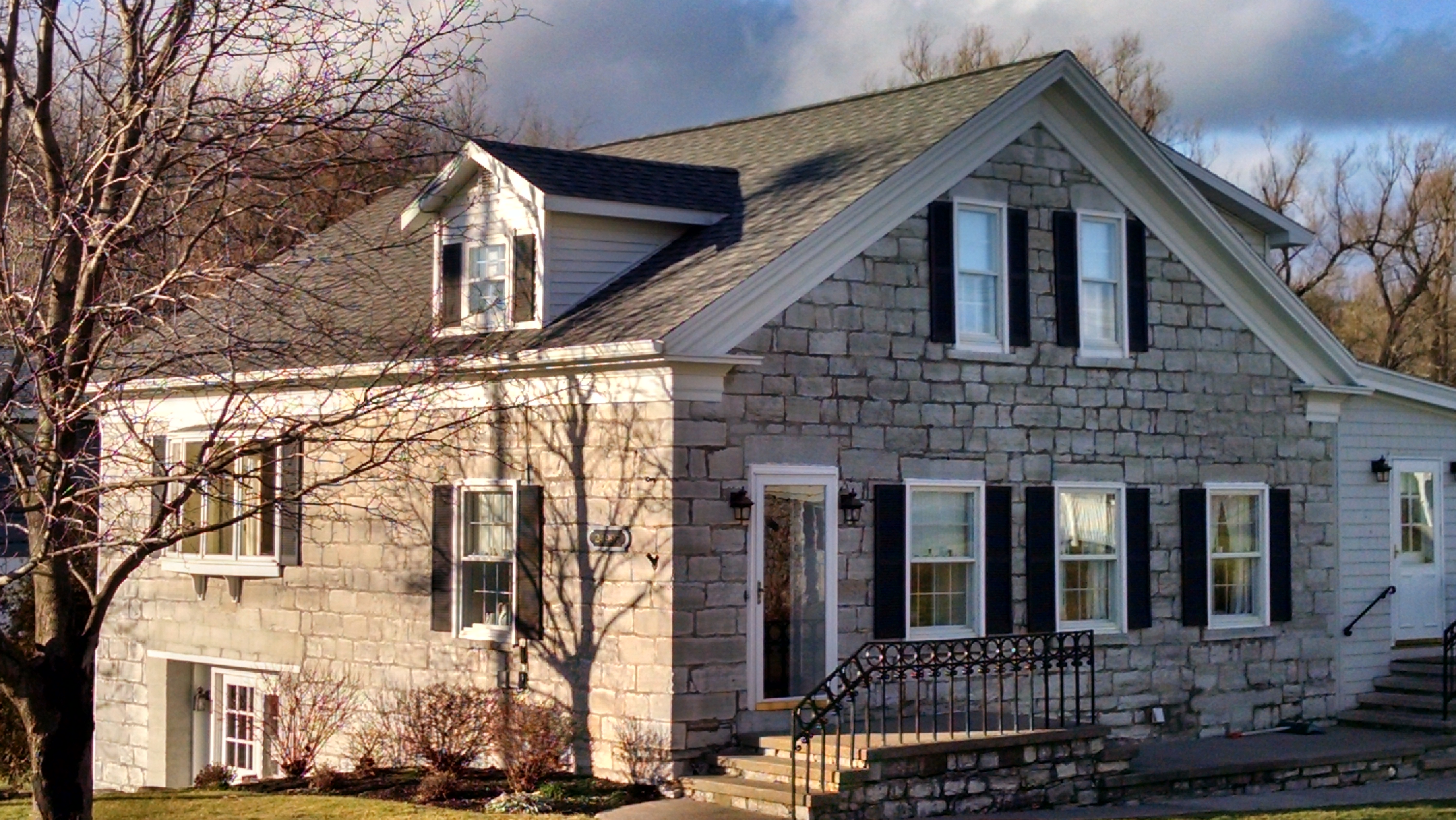
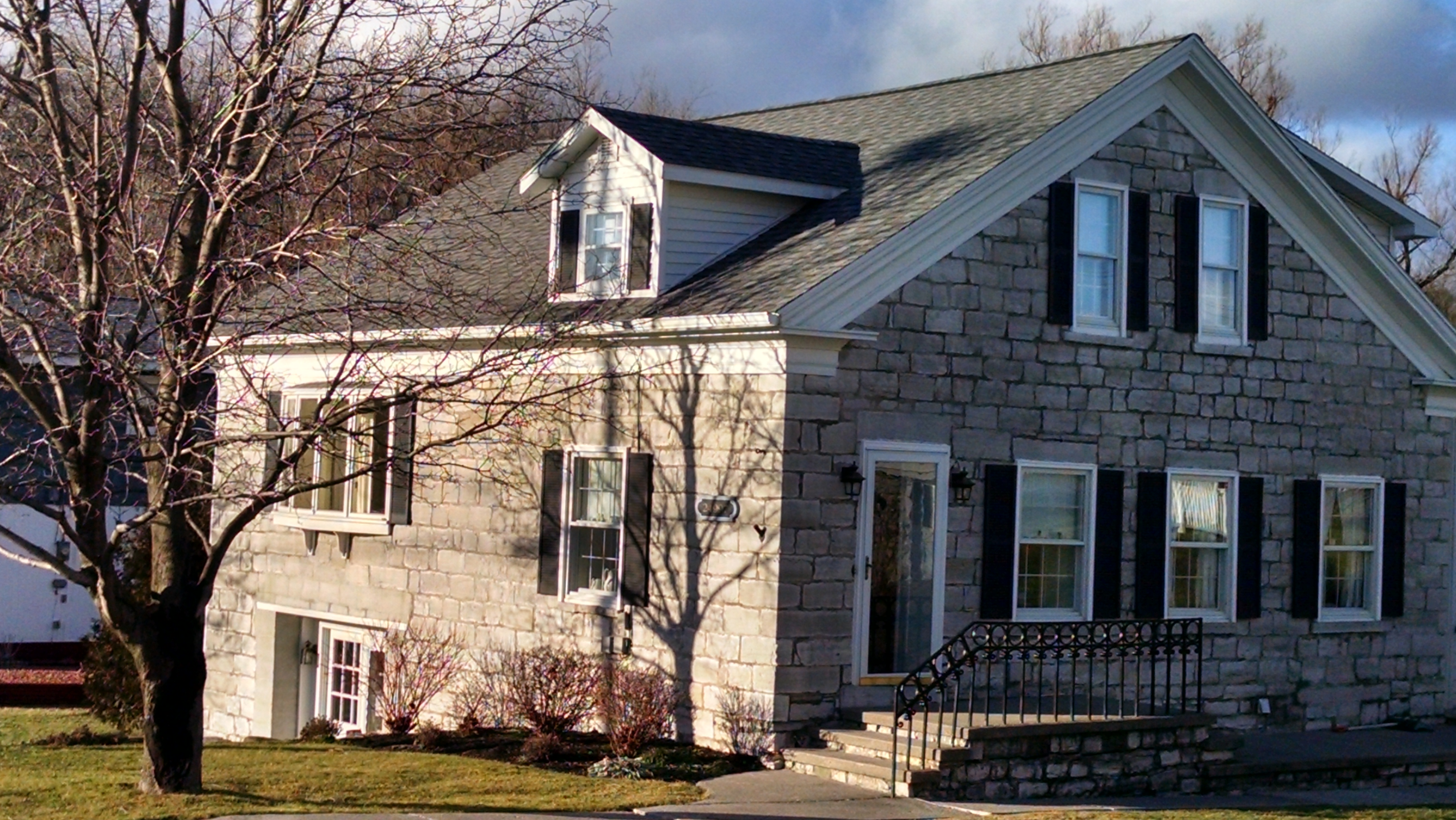
Sturdy, neat and shipshape, and one of the most attractive small native limestone houses in the county is that owned by Howard E Ganter at Pamelia Four Corners, a tiny north country hamlet noted for its many old limestone dwellings.
Apparently more than a century old, it is impossible to trace the record of its title back of May 29 1858 the date upon which Timothy A Smith and wife, Lucy A Smith of Watertown, sold it to Absalom L House.
Mr Smith, who was one of Watertown's most prominent business men, realtors and citizens in the last century, had approximately 125 real estate transactions between 1846 and the time of his death on October 7 1891. Yet nowhere is there a transfer on record to show when or from whom he purchased this house and the slightly less than one acre of land that goes with it.
Whenever he purchased it, it was a matter of real estate speculation, for he never resided there himself, his own residence for a long period of years having been on outer Arsenal Street next door to the home of his brother, A Palmer Smith, with whom he was a partner in many transactions.
Timothy A and A Palmer Smith were sons of Timothy Smith who came to Watertown from Stockbridge and who died here August 20 1873. For many years the two brothers were extensive hop-growers on outer Arsenal Street. Upon the death of Perley Keyes in 1833 they acquired the Watertown Freeman, weekly newspaper, and continued it as The Watertown Standard until July, 1835 when it was consolidated with The Watertown Eagle.
Timothy A Smith, two of whose grandchildren are the Misses Edith and
Emily Smith of this city, was married to Lucy Massey, who was a member
of one of Watertown's founding families. The red brick business block
on Arcade Street adjoining the American hotel was one of his properties,
and in the late 1870's he was a third ward alderman.
But concerning this old stone house, which stands just off the old Military highway and on the Pamelia-Perch River road immediately back of the late Elton H Miller residence also now owned by Mr Ganter, it was retained by Absalom L and Phoebe M House for nearly 21 years. On March 8 1879 they conveyed it to Cyrus House of Brownville and on February 25 1880 he sold it to Hamilton Timmerman, town of Pamelia. Mr Timmerman and wife, Frances, disposed of it to Mrs Mary M Walrath March 29 1883 and August 29 1910 she transferred it to Herman W Walrath, who for many years was engaged in grain-threshing and hay-pressing.
Mr Walrath died in Bradenton, Florida January 25 1946 aged 82 and this property passed to his brother, Burton J Walrath and sister, Mrs Elva Pickard, both of Florida. On October 11 1946 they sold it to Mrs Metta E Ganter, widow of Rubert Ganter. In the settlement of Mrs Canter's estate following her death the little house was acquired by the present owner, member of two of the county's prominent families from the Pamelia area. Mr Ganter leases the house which, with its black iron porch rail and outside door lights has a most attractive appearance. It is regrettable that its original ownership and history are not known, and slight though the Smith connection with it is, it is interesting that Mrs Timothy A Smith was the daughter of Stillman Massey and granddaughter of Hart Massey who, among other things gave the land for the First Presbyterian church
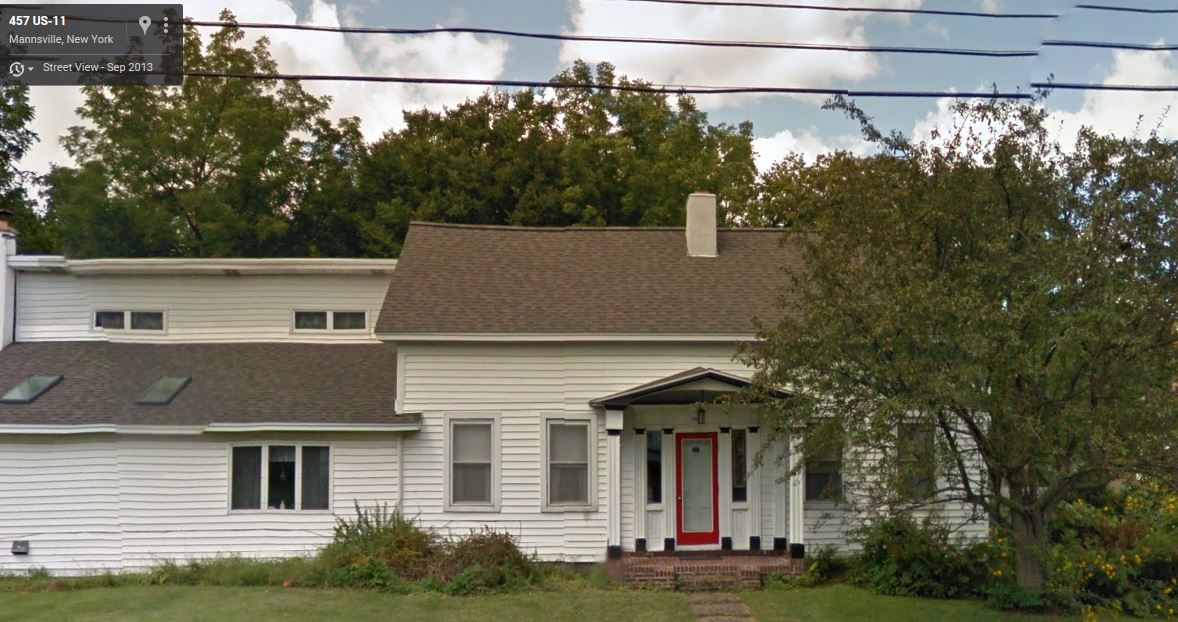
Since the fall of 1804 when Joseph Allen, a Revolutionary war minuteman, came up with Arnold and Pardon Earl from Galway, Saratoga county, to Bear Creek, now known as Pierrepont Manor, the name of Allen has been prominently identified with that community.
Born at Westport, Massachusetts, November 14 1758 Joseph Allen became a blacksmith and for some years followed his trade in connection with shipbuilding at Providence, Rhode Island. For two years and nine months he was a minuteman in the Revolution. On June 27 1784 he married Prudence Earl of Dartmouth, Massachusetts, lived there until 1793 and then moved to Galway. Eleven years later he blazed his way through the forest to Bear Creek, a virgin wilderness spot.
There he bought 320 acres and built the first house. Shortly after he constructed a frame addition, opened an inn, and a few years later gave from his tract land for a cemetery and for the public square. He was supervisor of the town of Ellisburg in 1808-9 served as magistrate, and about 1818 built a hotel which he operated until 1823. Of his ten children his son, Elihu, was born August 3 1806 became a blacksmith, married Miss Almira Andrus February 21 1839 and took residence in this house, which it is claimed he built in 1837.
Taking over the old blacksmith shop of his father on Main Street he installed waterpower in the late 1840's, operating both a trip-hammer and grindstone with it. Residing next door was his brother Harvey. Elihu died July 10 1886. In this attractive house, which, in more recent years became known as "Dream Cottage," were born his sons, George, Edward and William J. The birth dale of the latter, William Jarvis Allen, was October 16 1845. His education included study at Hungerford Collegiate Institute. On December 19 1864 he entered the Jefferson County Journal under Justus Eddy at Adams to learn printing. Shortly he came to the Watertown Reformer. Later he went to the Utica Observer, but in 1871 bought an interest in the Jefferson County Journal, became its sole owner after a time, and was editor until his death January 21 1926.
Village president of Adams, member of the village board of education, vice president of the New York State Press association he attained no little distinction during his life. His first wife and mother of his children was Miss Alice Kilby of Adams, whom he married February 4 1874. She died January 8 1891 and June 13 1895 he married Miss Clara Miranda Cooper of Adams, a native of Henderson, who became head of the Eastern Star order of the state and ascended to the presidency of the Northern Federation of Women's clubs.
Upon the death of Mr Allen she joined her stepdaughter, Miss Edna F Allen under the name E F Allen & Company in the operation of the Jefferson County Journal, of which Miss Edna F Allen has been the editor, publisher and sole owner since the death of Mrs Clara Cooper Allen on July 18 1941.
Despite the family tradition that Elihu Allen built this house, county records show very little ownership of real estate by Elihu and no connection with this place until September 21 1881 when Hiram and Fanny Allen quitclaimed their interest in it to him. After that the record is a void for years until July 30 1898 when William J and Clara Cooper Allen quitclaimed to George Allen, whose recorded will February 2 1917 passed it back to his brother William J. After the latter's death his estate sold it to Mrs Adelaide Allen Grenell August 14 1926 a granddaughter of Joseph Allen and widow of William H Grenell, seedsman. January 26 1927 Mrs Grenell sold to James A Reynolds, Minneapolis, Minnesota, who sold it November 16 1928 to John A Hill Jr, poultryman-market gardener, native of Smithville where he lived in the big stone house originally owned by Smithville's founder, Jesse Smith. Since the death of Mrs Hill January 21 1948 the former Miss Grace M Penney of Henderson, whom he married February 10 1897 her sister, Mrs Fred (Jennie) Lane has kept house for him.
Facing Gouvello Street and onward to the lake front and located at the southeasterly corner of Gouvello and James Streets in the historic village of Cape Vincent, the beauty of this old, white, frame house with its especially fine doorway demands instant notice.
It seems, from its design and exterior appearance, unlikely that it is under 115 years old, yet it is impossible to take it back through county records to a date earlier than May 25 1867. That was the date when Mrs Sarah Ann Ainsworth and her husband, Attorney Laban H Ainsworth, who were already residents of Watertown, disposed of it to Mrs Elizabeth B Hassler for $2,500.
When the house was built, who owned it before Laban H Ainsworth and his wife, or when and from whom they acquired it there appears to be no record. Certain it is that there are no more outstanding families in Cape Vincent than the three which have possessed this property for the past 84 years, the Ainsworths, the Hassler's and the Dezengremels, and the latter two are maritally bonded together.
The Ainsworths, whose immediate progenitor was Henry Ainsworth, Vermonter and Revolutionary war veteran, began settling the Cape Vincent area before 1810. Laban H Ainsworth, a follower of the law, transferred from Cape Vincent to Watertown about 1861 or 1862. He does not appear in the directory of 1860 but that of 1863-4 shows him fourth ward village trustee, resident of 10 Massey Street and partner of George D Earll in the law firm of Ainsworth & Earll, 16 Court Street.
When Watertown became a city in 1869 Laban H Ainsworth was elected the first recorder (city judge), a post he held some years. The 1880s found him residing at 82 State Street, the first house this side of the Mayor James B Wise house, and by 1890 he had completely disappeared from the local scene. But as he had been prominent here he had earlier also been prominent in Cape Vincent, having been an original trustee when the village was incorporated in 1853.
As for Mrs Elizabeth B Hassler, she was born in 1822 in Washington, DC, daughter of Samuel and Eleanor Hanson and on September 15 1845 married Ferdinand Eugene Hassler, a native of Newark, N J, who had been American counsel in Panama, and who was a son of Ferdinand Rudolph Hassler. The latter, great Swiss mathematician and scientist, had come to Cape Vincent in 1820 to establish a normal school, but failed. However, Ferdinand Rudolph Hassler became the first director of the United States Coast Survey and first superintendent of the federal bureau of standards (weights and measures.)
He died in Philadelphia, Pennsylvania, November 30 1843. His son, Ferdinand Eugene, who later took over his distinguished father's farm and property at Cape Vincent, died April 15 1869 two years after his wife acquired this house.
It must have been early in 1884 that Remy Dezengremel, a native of France, married Elizabeth B Hassler, for his first wife had died only October 5 1883 and a deed dated April 18 1884 shows Elizabeth B Dezengremel deeding this house to Reverend Samuel W Stronger, who the same day transferred it lo her husband, Remy Dezengremel, prominent Cape Vincent farmer and town assessor several years. He died October 19 1888 but his widow Elizabeth Bailey Hanson Hassler Dezengremel, lived until January 19 1902.
Remy Dezengremel willed this property to his grandchildren, Alfred L Dezengremel, retired garage proprietor, and his sister, Miss Estelle Dezengremel, world traveler and magazine executive, who died at Fort George, Florida, February 9 1949 willing her share of this house to her brother and his daughter, Mrs Marie Dezengremel Fitzgerald, but Alfred L Dezengremel and his family have resided in the house for many years.
If you happen to be driving out of the village of Lyons Falls and up over the hill towards Collinsville and Turin you will see on high ground by the roadside on your left-hand two most engaging, sturdy and well-kept old houses of native limestone.
They grace a farm of some 400 acres which loftily and with some disdain looks to the village of Lyons Falls and the Moose-Black River valley below. Both were built by the same hands, those of William Rees, a stone mason, who came from his native Wales to settle in Lewis county in i801 exactly 150 years ago.
Also both are constructed from a fine quality of blue limestone that came from the two quarries located upon the farm, but while the one further up the hill from Lyons Falls is said to have been erected first and not many years after William Rees came to this country, its companion was built, according to tradition, about 1848. Never has their ownership been out of the same family, and today it is held by Mr and Mrs Reese M Earle Potter, who occupy the one farther from Lyons Falls, a picture of which was run in this series March 23 1940. In the younger of the two houses pictured above resides the family of Reese Henry Potter, son of Mr and Mrs Reese M Earle Potter.
An interesting bit of family tradition that attaches to these two houses is that William Rees and his brother, John, who was a carpenter, are said to have been engaged on the construction of the General Martin stone mansion at Martinsburg 1803-1805 and the William Constable mansion at Constableville 1809-1810. Not only that, but it is said that William was given 300 acres of land for his work on Constable Hall, and that he was the master craftsman of the Isaac W Bostwick mansion now owned and occupied by Attorney and Mrs George S Reed in Lowville.
William Rees died in 1857 and is buried in the little family cemetery across the road from the house shown above. James Rees, son of William, was the father of Mary Rees who married Marshall Ney Potter, father of Reese M Earle Potter, present, owner of these houses.
Son of Benjamin Franklin Potter and Rachel Ann Case Potter, Marshall Ney Potter was born at Potter's Corners near Collinsville, October 5 1851. Benjamin Franklin Potter was born September 29 1817 son of Joseph Potter and lived in the town of Floyd, Oneida county, until he was 16. On March 11 1846 he was married to Rachel Anna Case, who was born August 29 1820 in Turin, daughter of Pardon C Case. Benjamin Franklin Potter was one of the largest hop growers in Lewis county and for 20 years engaged in shipping venison to New York and other markets. He was a Democrat who held various town offices including that of supervisor, and was active in recruiting during the Civil war. He died February 23 1883.
Joseph Potter, father of Benjamin, was born in Coventry, Rhode Island, March 16 1775 and on February 1 1795 was married to Phoebe Adams, a Vermont native who was born December 26 1774. From Coventry Joseph Potter had first removed to Vermont, and after his marriage he removed to the town of Floyd. He was a descendant of George Potter who emigrated to New England from England in 1638.
Reese Henry Potter, son of Reese M Earle Potter and Alta VanAuken Potter, prominent in Lyons Falls life, was graduated from the Port Leyden High school and September 30 1933 was married to Miss Marion F Mainshell, daughter of Mr and Mrs Fred Mainshell of Niverville. She was a graduate of the Albany schools.
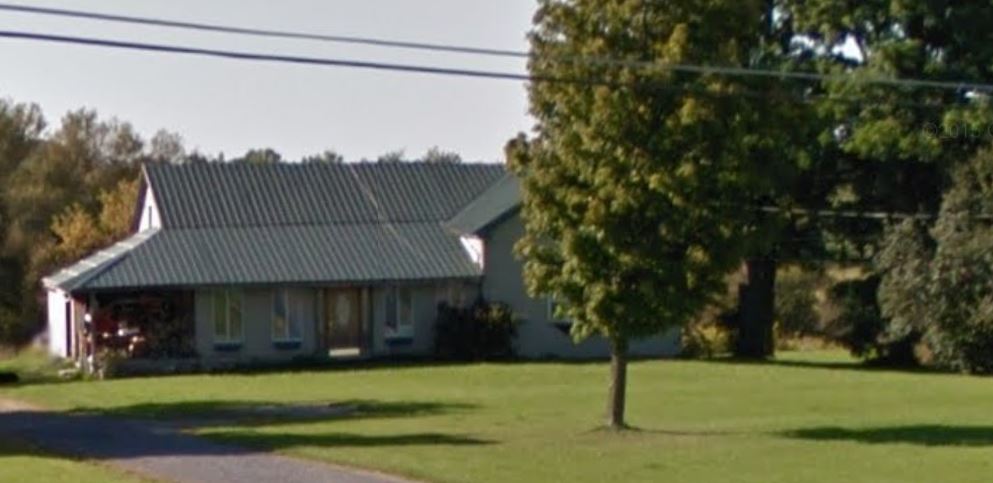
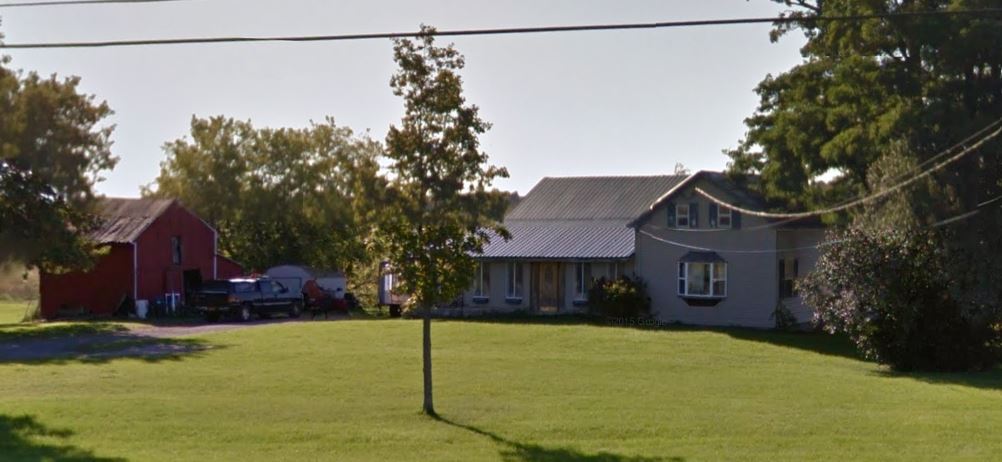
On the Watertown-Theresa road a little due north of the middle of the town of Pamelia is this old farm house. What is now the long and commodious limestone wing was probably the original house, the frame upright having been built on at some later time to solve the problem of needed expansion.
In a region of extensive deposits of good building limestone, the stone for this house is said to have been quarried near by. The architectural type of the wing gives it a mark of more than a century ago, and in the same town great lot No. 506 in which this house is located, David Locke purchased 110 acres from Washington and Stephanie Coster of New York City on March 6 1833.
While it is difficult to reconcile the deed description of the 110 acres, that Locke bought in 1833 with the 103.73 acres constituting this farm as it is today and which he and his wife, Harriet, sold to Sylvanus Seeber for $3,111.90 on November 15 1856 this 103.73-acre farm is unquestionably of the 185.5 acres which Reuben and Phebe Locke disposed of to David Locke on December 31 1853 for $5,000.
The deed from Reuben covers four parcels, one of which was the 110-acre parcel which David had bought of Washington Coster March 6 1833 for $752.05 and then sold to Reuben on April 22 of the same year for $1,000.
On that November 15 1856 that David and Harriet Locke sold 103.73 acres to Sylvanus Seeber, they also sold 82.81 acres in the same area to Orvis and Anderson Zuller. The two parcels together correspond with the 185.5 acres which Reuben and Phebe Locke conveyed to David Locke December 31 1853.
From the day that David and Harriet Locke sold this property to Sylvanus Seeber for $3,111.90 it can be positively identified in all of the transactions down to the present day. On November 1 1880 Sylvanus and Julia R Seeber disposed of this house and the 103.73 acres to Burton B Ball for $3,400. Next, on January 1 1886 Burton B and Florence H Ball conveyed the same to Silas D Ball, who retained possession of it until December 26 1930 when he sold it to Joseph C and Harriet M Dunaway.
Mr Dunaway, a native of Tylerville, died June 21 1939 and his wife died October 23 1943. Then on May 22 1944 Edward Ward, individually and as executor of Mrs Dunaway, and Mrs Nina Ward, wife of Edward and daughter of Mr and Mrs Dunaway, sold the place to Truman H and Ermine G Ansted, the present owners.
Little can be learned of the Lockes and Seebers, who were the earliest owners, but the late Silas D Ball with an ownership of 44 years gave him by far the longest of any of those who held title to it.
Mr Ball, born in the town of Watertown March 21 1847 son of Mr and Mrs John B Ball, died in this city June 21 1939 one of the most extensive real estate owners in Watertown. For many years he was a partner of the late Constantine Ganter in the real estate firm of Ball & Ganter. He was 92 when he died. Mr Ansted, the present owner of this house, is an enterprising young farmer, son of the late Mr and Mrs Chauncey Ansted, who resided near Evans Mills. Mr Ansted was married January 24 1935 to Miss Ermine G Ganter, daughter of Mr and Mrs Henry Ganter, which recalls that the Ganter family has been identified with the possession of more of the old stone houses in the town of Pamelia than any other family. At least six of the ancient Pamelia stone houses have been owned by Ganters at one time or another and that record still continues
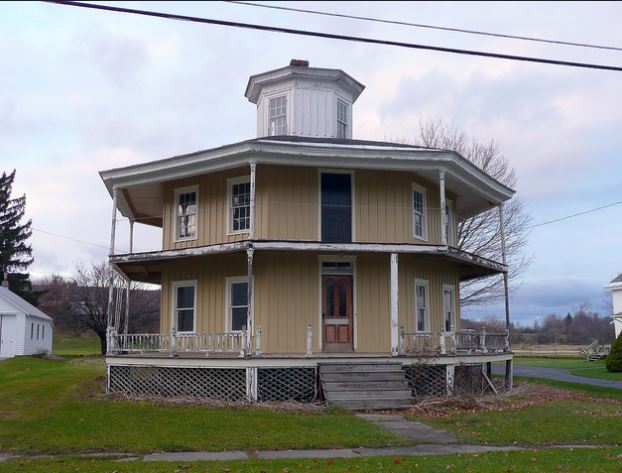
Constableville, which once ranked second only to Port Leyden as the most important business center in the southern end of Lewis county, has much to make it distinctive. Founded by William Constable of the famous north country family of land owners and promoters, the hamlet, because of being the locale of Constable Hall, William Constable's beautiful limestone manor house, is one of the most historically outstanding in the state. But Constable Hall alone, now an historic museum and shrine, is not the sole contributing factor to the distinction of Constableville. On a lesser, but nevertheless an interesting, scale the "Octagon House," now almost a century old, lends its own fair share, for octagon houses, unique as an architectural type, are rare in New York state.
This one also has an intimate Jefferson County interest, because it was built in 1856 by Moses Jay Eames, a native of the town of Rutland where he was born June 12 1829 son of Daniel Wight Eames and Laura Cone Eames. And Daniel Wight Eames was a brother of Jefferson County's famous Moses Eames, diarist, inventor, farmer and prominent industrialist. The family stemmed from Thomas Eames who, at the age of 12 came to the American colonies, married at 22 and settled at Dedham, Massachusetts
Like his accomplished uncle, Moses Jay Eames, had a decided aptitude for things mechanical. On February 9 1854 he married Sally Legal who was born August 20 1829 and lived until June, 1912. Their children were Mary Jane, who married James A Vanderburgh; Howard Clift who married Anna Earle; Laura who married Evan Roberts, her twin sister, Clara, who married Howard A Pease; and Miss Fannie Eames. Moses Jay Eames, head of the Constableville firm of Eames & Bridgeman which manufactured wooden pumps, wooden pump logs used as pipes, cheese boxes, sash and blinds and other kinds of woodwork, bought the .312 of an acre site for this house from Seth and Laura Miller December 31 1855 for $125. It is said that the house was constructed the next year.
Having seen an octagon house, Moses Jay Eames, whose mind had an utilitarian bent, was impressed by the fact that it contained one-fifth more usable space than a house of similar size in quadrangular form. So on the opposite side of the street from his factory and only a short distance from the Baptist church he erected this house.
It was a perfect octagon with porches all around it. Through the center of the house rises a single pillar, around which winds an enclosed stairway to the cupola above the second story. This cupola has always been used as a conservatory for flowers in wintertime. Four main rooms up and downstairs are arranged around the stairway.
At a later date Mr Eames built a rectangular addition on the back of the house which, notwithstanding, has never lost its distinctiveness and general appeal to the public, for it continues to attract wide public interest and its ownership has never been out of the Eames family. After the death of Mr Eames June 8 1885 his widow continued to reside there and with her her three daughters, Mrs E F (Laura) Roberts whose husband, merchant, died September 6 1916 and she on April 23 1929; Mrs Howard A (Clara) Pease, twin sister of Mrs Roberts, who died November 26 1941 and whose husband, a commercial traveler, died January 1 1934; and Miss Fannie Eames, who died December 24 1944. Mrs Roberts, Mrs Pease and Miss Eames had all been school teachers.
The present owner is Mrs Clara Shaw of Rome and Constableville. Granddaughter of Moses Jay Eames, Mrs Shaw, who was born in the house, is the daughter of the late Mr and Mrs Roberts. After being away from the interesting house from 1912 she went back in 1941 to care for her Aunt Fannie, and upon the latter's death December 24 1944 inherited the house, in which she resides a considerable portion of each year.